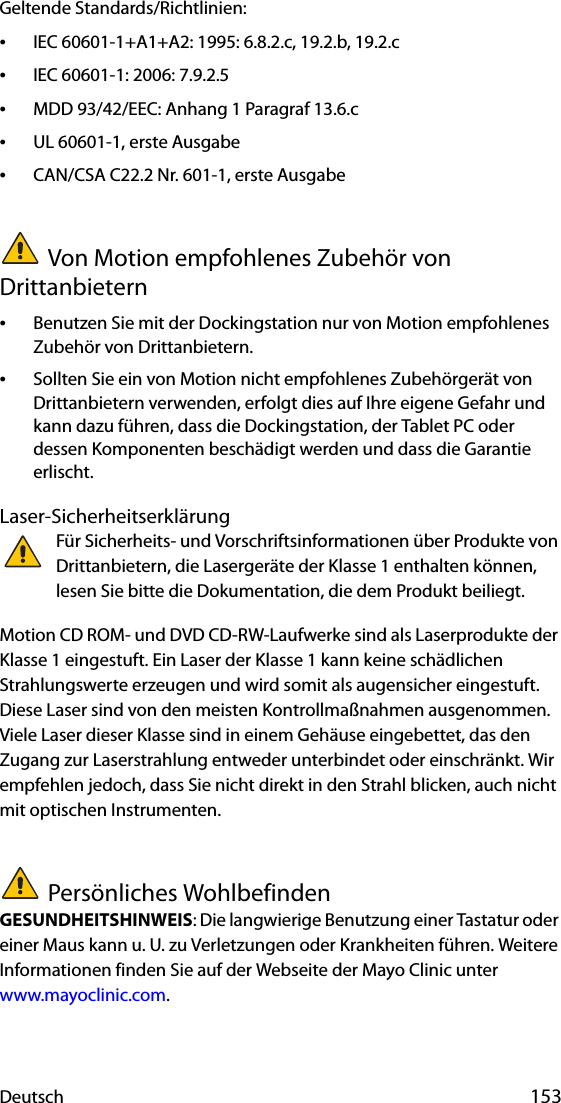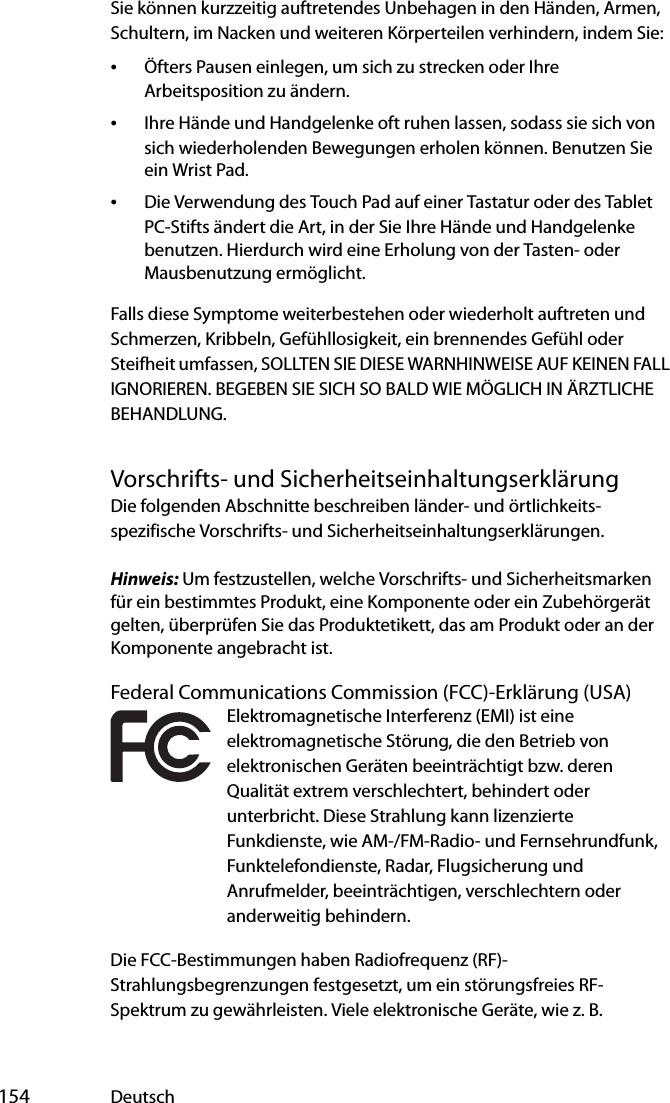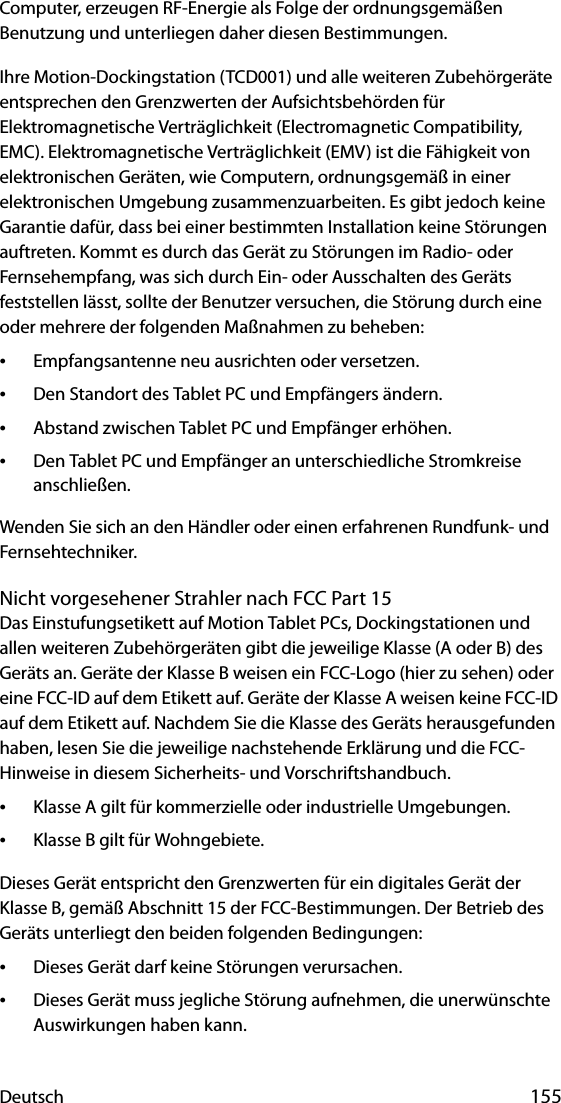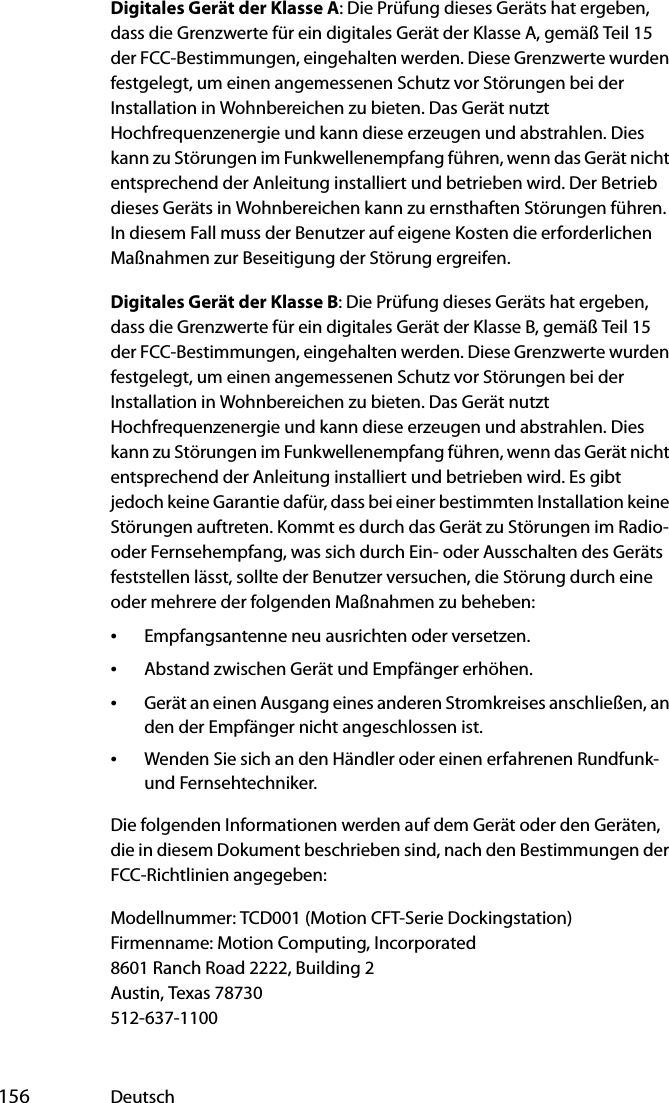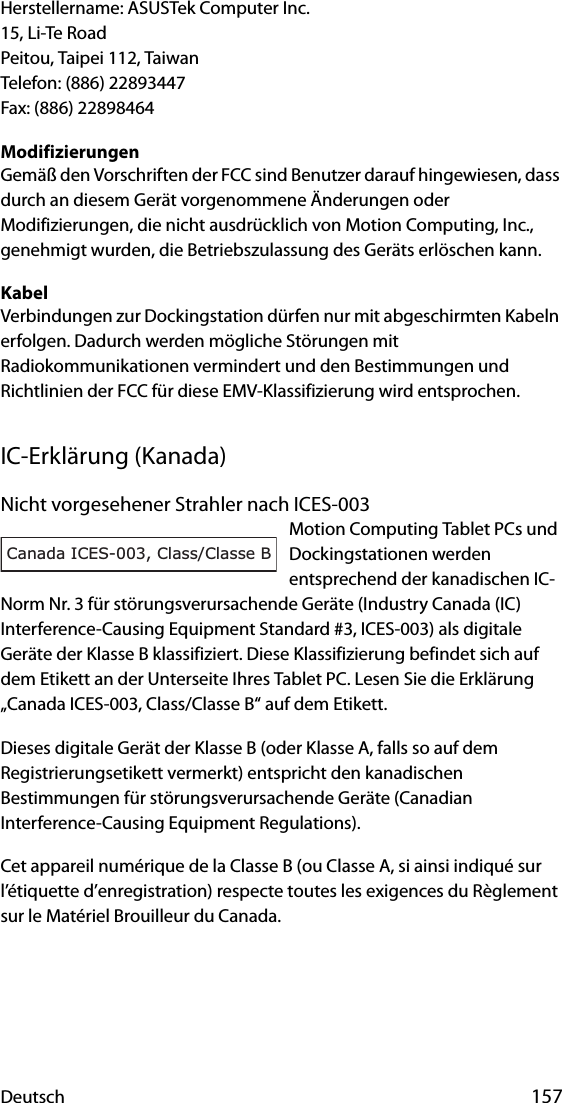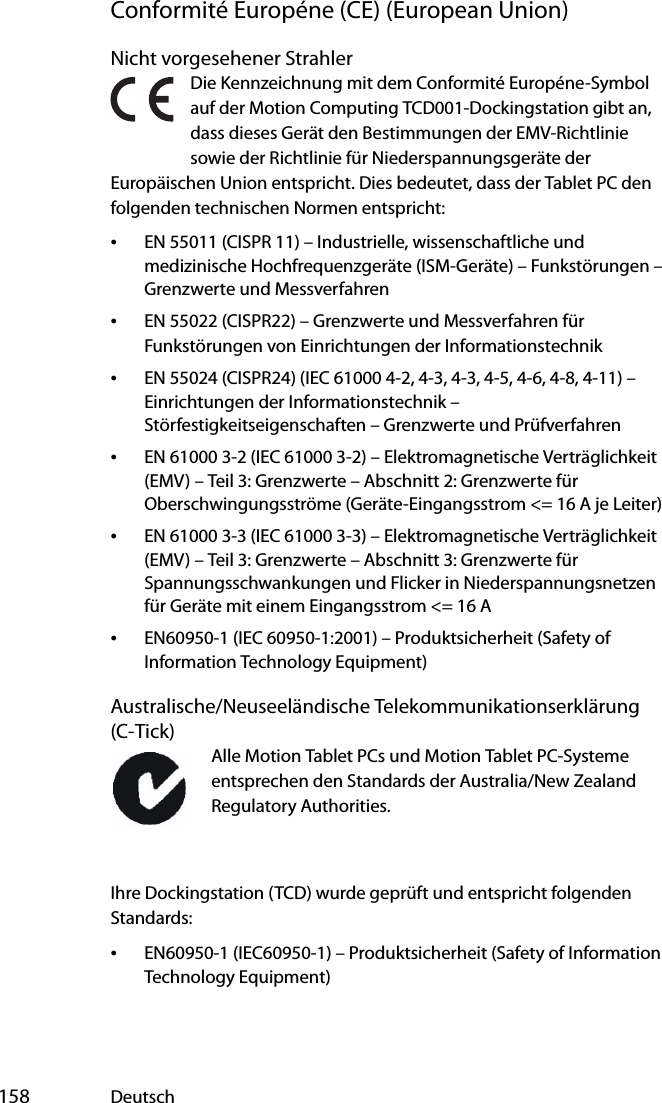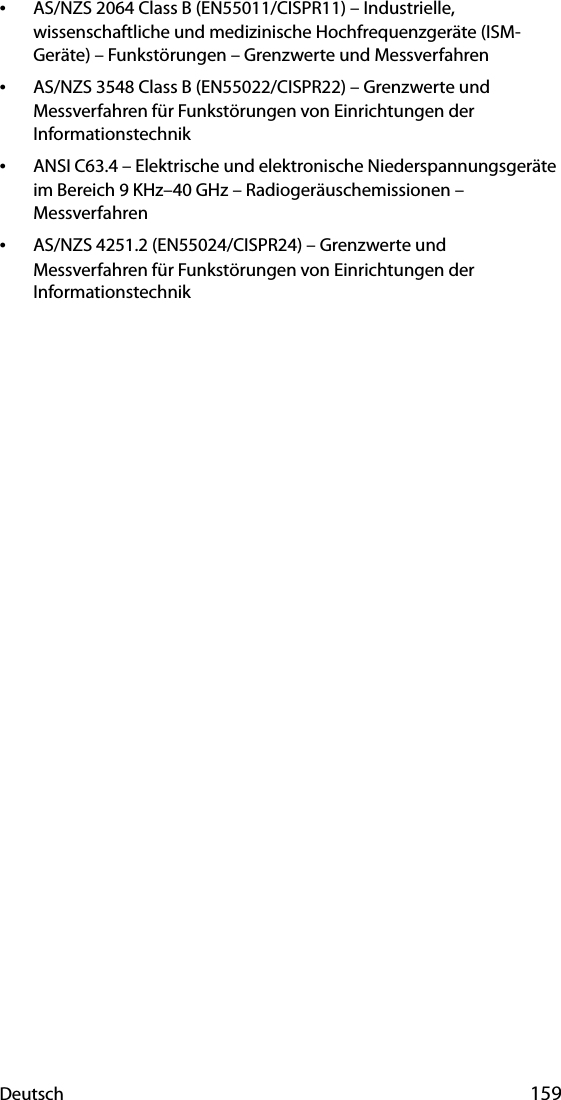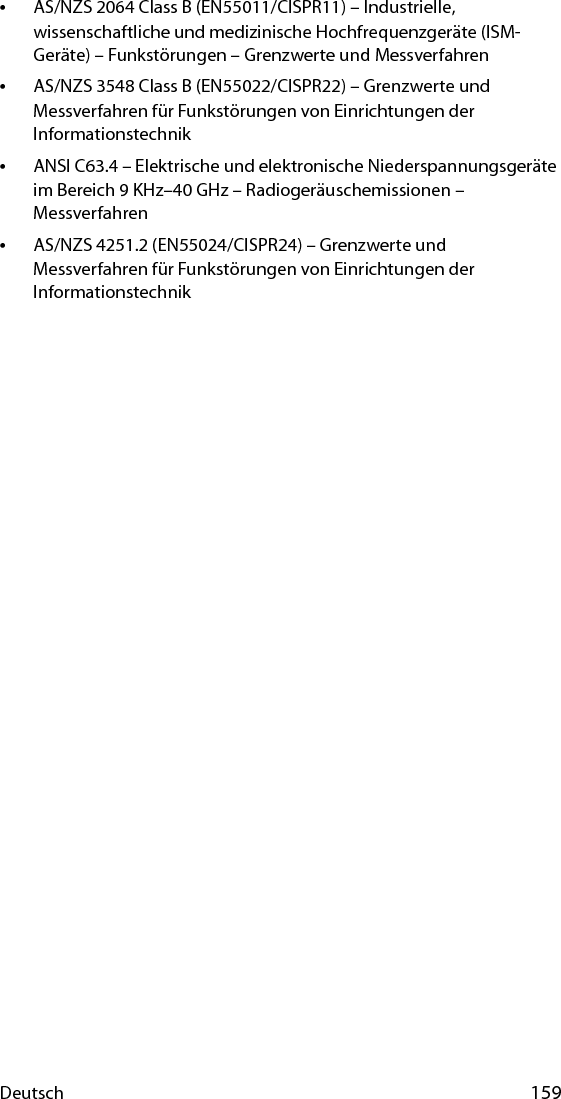Xplore Technologies of America HWMSMC5725 Cellular/ PCS CDMA Module User Manual Safety and Regulatory Guide
Xplore Technologies Corp of America Cellular/ PCS CDMA Module Safety and Regulatory Guide
Contents
- 1. Users Manual
- 2. Users Manual Safety Info
Users Manual Safety Info
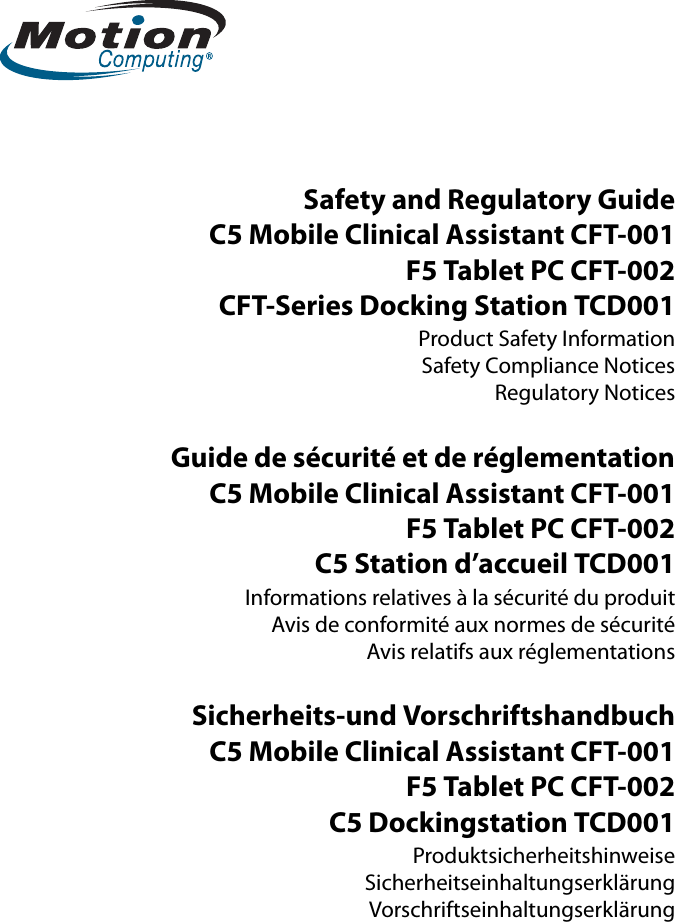
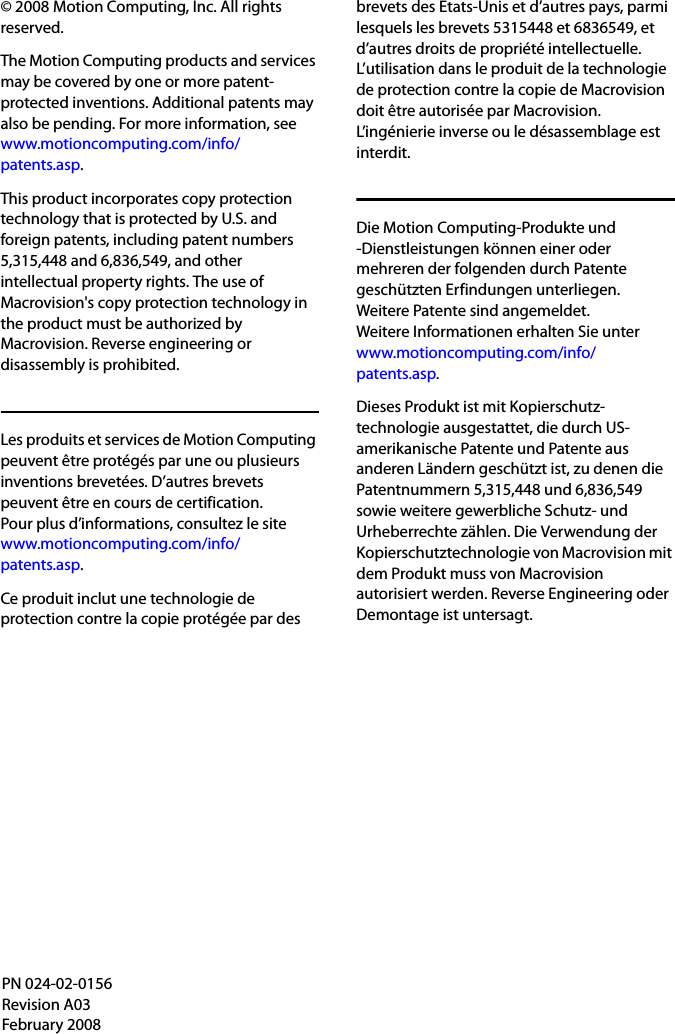
![3ContentsEnglish . . . . . . . . . . . . . . . . . . . . . . . . . . . . . . . . . . . . . 7Introduction . . . . . . . . . . . . . . . . . . . . . . . . . . . . . . . . . . . . . . . . . . . . . . . .7Symbol description . . . . . . . . . . . . . . . . . . . . . . . . . . . . . . . . . . . . . . . . .8Specifications. . . . . . . . . . . . . . . . . . . . . . . . . . . . . . . . . . . . . . . . . . . . . . .9Product safety information . . . . . . . . . . . . . . . . . . . . . . . . . . . . . . . . . .9Product mounting and installation disclaimer. . . . . . . . . . . . . . . .9C5 (CFT-001) tablet information . . . . . . . . . . . . . . . . . . . . . . . . . . . .10Setup precautions. . . . . . . . . . . . . . . . . . . . . . . . . . . . . . . . . . . . . . .10Basic personal safety precautions . . . . . . . . . . . . . . . . . . . . . . . .11Tablet PC precautions . . . . . . . . . . . . . . . . . . . . . . . . . . . . . . . . . . .12High risk and dangerous activity warning . . . . . . . . . . . . . . . .12Clinical usage notice (C5 [CFT-001] only) . . . . . . . . . . . . . . . . .13Tablet PC disposal. . . . . . . . . . . . . . . . . . . . . . . . . . . . . . . . . . . . . . .13Cabling and power cord precautions. . . . . . . . . . . . . . . . . . . . .13ITE power adapter precautions . . . . . . . . . . . . . . . . . . . . . . . . . .14Medical power adapter precaution (C5 [CFT-001] only) . . .14Battery pack warnings and precautions . . . . . . . . . . . . . . . . . .15Battery pack disposal . . . . . . . . . . . . . . . . . . . . . . . . . . . . . . . . . . . .16Travel precautions. . . . . . . . . . . . . . . . . . . . . . . . . . . . . . . . . . . . . . .17Component replacement precautions . . . . . . . . . . . . . . . . . . .17Wireless devices. . . . . . . . . . . . . . . . . . . . . . . . . . . . . . . . . . . . . . . . .17Accessory precautions. . . . . . . . . . . . . . . . . . . . . . . . . . . . . . . . . . .18Comfort and health . . . . . . . . . . . . . . . . . . . . . . . . . . . . . . . . . . . . .18Regulatory and safety compliance . . . . . . . . . . . . . . . . . . . . . . .18Other notices and marks. . . . . . . . . . . . . . . . . . . . . . . . . . . . . . . . .29F5 (CFT-002) tablet information . . . . . . . . . . . . . . . . . . . . . . . . . . . .31Regulatory and safety compliance . . . . . . . . . . . . . . . . . . . . . . .31Docking Station (TCD001) information. . . . . . . . . . . . . . . . . . . . . .44Setup precautions. . . . . . . . . . . . . . . . . . . . . . . . . . . . . . . . . . . . . . .45Clinical usage notice (C5 [CFT-001] only) . . . . . . . . . . . . . . . . .45Basic personal safety precautions . . . . . . . . . . . . . . . . . . . . . . . .45](https://usermanual.wiki/Xplore-Technologies-of-America/HWMSMC5725.Users-Manual-Safety-Info/User-Guide-1079955-Page-3.png)
![4ContentsDocking Station precautions. . . . . . . . . . . . . . . . . . . . . . . . . . . . .46Docking Station disposal . . . . . . . . . . . . . . . . . . . . . . . . . . . . . . . .46Battery charger precautions . . . . . . . . . . . . . . . . . . . . . . . . . . . . .47ITE power adapter precautions . . . . . . . . . . . . . . . . . . . . . . . . . .47Medical power adapter precaution (C5 [CFT-001] only) . . .48Motion-recommended third-party accessories . . . . . . . . . . .48Comfort and health . . . . . . . . . . . . . . . . . . . . . . . . . . . . . . . . . . . . .49Regulatory and safety compliance . . . . . . . . . . . . . . . . . . . . . . .49IC notice (Canada only) . . . . . . . . . . . . . . . . . . . . . . . . . . . . . . . . . .52Conformité Européne (CE) (European Union) . . . . . . . . . . . . .53Français . . . . . . . . . . . . . . . . . . . . . . . . . . . . . . . . . . . 55Introduction . . . . . . . . . . . . . . . . . . . . . . . . . . . . . . . . . . . . . . . . . . . . . . .55Description des symboles . . . . . . . . . . . . . . . . . . . . . . . . . . . . . . . . . .56Spécifications. . . . . . . . . . . . . . . . . . . . . . . . . . . . . . . . . . . . . . . . . . . . . .57Informations relatives à la sécurité du produit . . . . . . . . . . . . . .57Avis d'exclusion de responsabilité de montage et d'installation de produit. . . . . . . . . . . . . . . . . . . . . . . . . . . . . . . . . . . .57Informations relatives à la tablette C5 (CFT-001). . . . . . . . . . . . .58Précautions d'installation . . . . . . . . . . . . . . . . . . . . . . . . . . . . . . . .58Précautions élémentaires de sécurité pour les personnes . . . . . . . . . . . . . . . . . . . . . . . . . . . . . . . . . . . . . . . . . . . . . .59Précautions liées à la tablette PC . . . . . . . . . . . . . . . . . . . . . . . . .60Avertissement d'activité dangereuse et à haut risque. . . . .61Avis d'utilisation clinique (C5 [CFT-001] uniquement) . . . . .61Mise au rebut de la tablette PC. . . . . . . . . . . . . . . . . . . . . . . . . . .61Précautions liées aux câbles électriques et au câble d'alimentation . . . . . . . . . . . . . . . . . . . . . . . . . . . . . . . . . . . . . . . . . .61Précautions liées à l'adaptateur d'alimentation ITE. . . . . . . .62Précautions liées à l'adaptateur d'alimentation médical (C5 [CFT-001] uniquement) . . . . . . . . . . . . . . . . . . . . . . . . . . . . . .63Précautions et avertissements liés à la batterie . . . . . . . . . . .63Mise au rebut des batteries . . . . . . . . . . . . . . . . . . . . . . . . . . . . . .65Précautions à prendre en voyage . . . . . . . . . . . . . . . . . . . . . . . .65Précautions liées au remplacement des composants . . . . .66Périphériques sans fil . . . . . . . . . . . . . . . . . . . . . . . . . . . . . . . . . . . .66](https://usermanual.wiki/Xplore-Technologies-of-America/HWMSMC5725.Users-Manual-Safety-Info/User-Guide-1079955-Page-4.png)
![Contents 5Précautions liées aux accessoires . . . . . . . . . . . . . . . . . . . . . . . .67Confort et santé . . . . . . . . . . . . . . . . . . . . . . . . . . . . . . . . . . . . . . . . .67Respect des réglementations et normes de sécurité . . . . . .68Autres avis et marques . . . . . . . . . . . . . . . . . . . . . . . . . . . . . . . . . .79Informations relatives à la tablette F5 (CFT-002). . . . . . . . . . . . .81Respect des réglementations et normes de sécurité . . . . . .82Informations à propos de la station d'accueil (TCD001) . . . . . .95Précautions d'installation . . . . . . . . . . . . . . . . . . . . . . . . . . . . . . . .96Avis d'utilisation de la Clinical (C5 [CFT-001] uniquement) 96Précautions élémentaires de sécurité pour les personnes .96Précautions liées à la station d'accueil. . . . . . . . . . . . . . . . . . . .97Mise au rebut de la station d'accueil . . . . . . . . . . . . . . . . . . . . .97Précautions liées au chargeur de batterie . . . . . . . . . . . . . . . .98Précautions liées à l'adaptateur d'alimentation ITE. . . . . . . .98Précautions liées à l'adaptateur d'alimentation médical (C5 [CFT-001] uniquement) . . . . . . . . . . . . . . . . . . . . . . . . . . . . . .99Accessoires d'autres fabricants recommandés par Motion. . . . . . . . . . . . . . . . . . . . . . . . . . . . . . . . . . . . . . . . . . . . . . . . 100Confort et santé . . . . . . . . . . . . . . . . . . . . . . . . . . . . . . . . . . . . . . . 100Respect des réglementations et normes de sécurité . . . . 101Avis IC (Canada uniquement) . . . . . . . . . . . . . . . . . . . . . . . . . . 104Conformité européenne (CE) (Union européenne). . . . . . 105Deutsch . . . . . . . . . . . . . . . . . . . . . . . . . . . . . . . . . .107Einführung . . . . . . . . . . . . . . . . . . . . . . . . . . . . . . . . . . . . . . . . . . . . . . 107Symbolbeschreibung . . . . . . . . . . . . . . . . . . . . . . . . . . . . . . . . . . . . 108Spezifikationen . . . . . . . . . . . . . . . . . . . . . . . . . . . . . . . . . . . . . . . . . . 109Produktsicherheitshinweise . . . . . . . . . . . . . . . . . . . . . . . . . . . . . . 109Haftungsausschluss bei Montage und Installation des Produkts. . . . . . . . . . . . . . . . . . . . . . . . . . . . . . . . . . . . . . . . . . . . . . . . . 109Informationen zum C5 (CFT-001) Tablet PC . . . . . . . . . . . . . . . 110Vorsichtsmaßnahmen bei der Einrichtung. . . . . . . . . . . . . . 110Grundlegende persönliche Sicherheitsvorkehrungen. . . 111Tablet PC-Sicherheitsvorkehrungen. . . . . . . . . . . . . . . . . . . . 112Warnung zu gefährlichen oder mit hohem Risiko behafteten Handlungen . . . . . . . . . . . . . . . . . . . . . . . . . . . . . . . 113](https://usermanual.wiki/Xplore-Technologies-of-America/HWMSMC5725.Users-Manual-Safety-Info/User-Guide-1079955-Page-5.png)
![6ContentsHinweis zum klinischen Einsatz (nur für C5 [CFT-001]) . . 113Tablet PC-Entsorgung . . . . . . . . . . . . . . . . . . . . . . . . . . . . . . . . . 113Verkabelungs- und Netzkabel-Sicherheitsvorkehrungen . . . . . . . . . . . . . . . . . . . . . . . . . . . . . . 114ITE-Netzteil-Sicherheitsvorkehrungen. . . . . . . . . . . . . . . . . . 114Sicherheitsvorkehrungen zum Netzteil für den medizinischen Einsatz (nur für C5 [CFT-001]) . . . . . . . . . . . 115Akkupack-Warnungen und Sicherheitsvorkehrungen. . . 115Akkupack-Entsorgung. . . . . . . . . . . . . . . . . . . . . . . . . . . . . . . . . 117Reisesicherheitsvorkehrungen . . . . . . . . . . . . . . . . . . . . . . . . . 118Komponentenersatz-Sicherheitsvorkehrungen. . . . . . . . . 118Drahtlose Geräte . . . . . . . . . . . . . . . . . . . . . . . . . . . . . . . . . . . . . . 119Zubehör-Sicherheitsvorkehrungen . . . . . . . . . . . . . . . . . . . . 119Persönliches Wohlbefinden. . . . . . . . . . . . . . . . . . . . . . . . . . . . 119Vorschrifts- und Sicherheitseinhaltungserklärung . . . . . . 120Weitere Erklärungen und Marken . . . . . . . . . . . . . . . . . . . . . . 132Informationen zum F5 (CFT-002) Tablet PC . . . . . . . . . . . . . . . 134Vorschrifts- und Sicherheitseinhaltungserklärung . . . . . . 134Informationen zur Dockingstation (TCD001) . . . . . . . . . . . . . . 148Vorsichtsmaßnahmen bei der Einrichtung. . . . . . . . . . . . . . 149Hinweis zum klinischen Einsatz (nur für C5 [CFT-001]) . . 149Grundlegende persönliche Sicherheitsvorkehrungen. . . 150Dockingstation-Sicherheitsvorkehrungen . . . . . . . . . . . . . . 150Entsorgung der Dockingstation. . . . . . . . . . . . . . . . . . . . . . . . 151Akkuladegerät-Sicherheitsvorkehrungen. . . . . . . . . . . . . . . 151ITE-Netzteil-Sicherheitsvorkehrungen. . . . . . . . . . . . . . . . . . 152Sicherheitsvorkehrungen zum Netzteil für den medizinischen Einsatz (nur für C5 [CFT-001]) . . . . . . . . . . . 152Von Motion empfohlenes Zubehör von Drittanbietern . 153Persönliches Wohlbefinden. . . . . . . . . . . . . . . . . . . . . . . . . . . . 153Vorschrifts- und Sicherheitseinhaltungserklärung . . . . . . 154IC-Erklärung (Kanada) . . . . . . . . . . . . . . . . . . . . . . . . . . . . . . . . . 157Conformité Européne (CE) (European Union) . . . . . . . . . . . 158](https://usermanual.wiki/Xplore-Technologies-of-America/HWMSMC5725.Users-Manual-Safety-Info/User-Guide-1079955-Page-6.png)
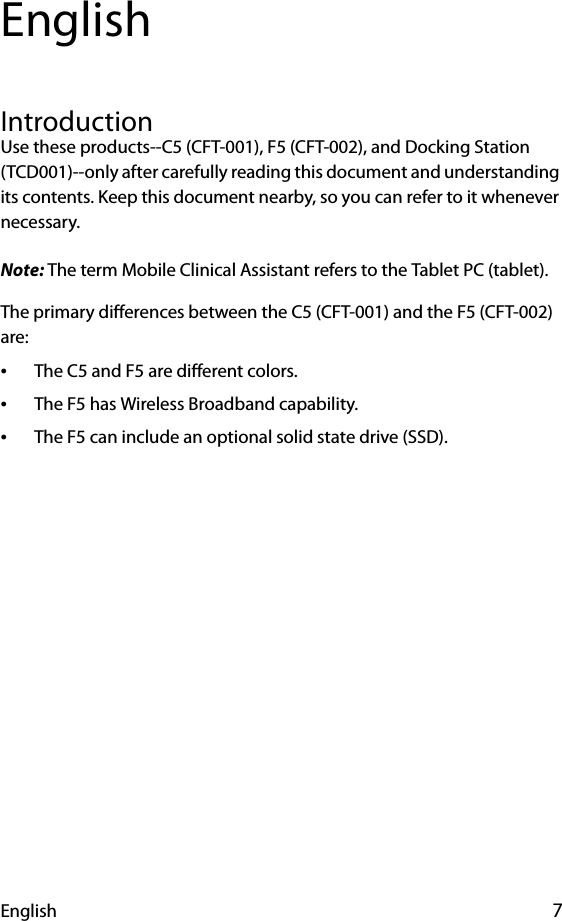
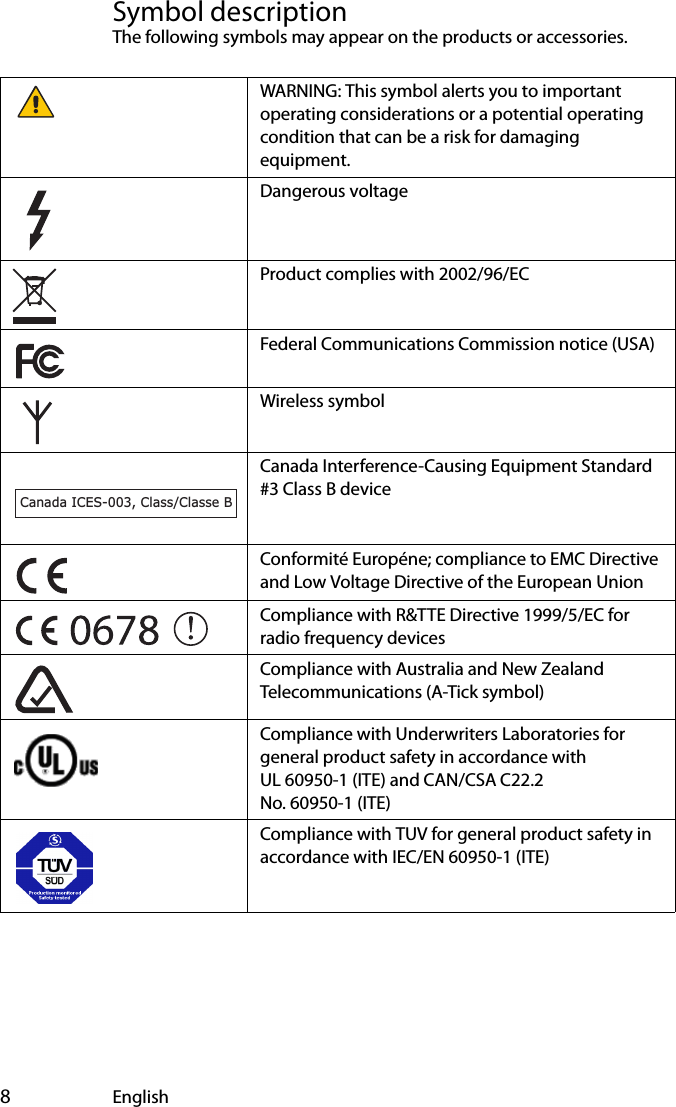
![English 9SpecificationsProduct safety informationMotion Tablet PCs and accessories are designed to optimize safety, minimize strain, and withstand the rigors of portability. However, to further reduce the risk of personal injury or damage to the unit, certain precautions should be observed.Product mounting and installation disclaimerMotion Computing shall not be liable under any theory of liability (including, without limitation, contract, tort or statutory law) for any loss, damage, personal injury, or other damage of any nature (including, without limitation, direct, special, incidental or consequential damages) arising directly or indirectly as a result of improper or inappropriate placement, installation, or use of its products or any other application. In order to safely install and use Motion products, full consideration of occupants, systems (e.g., the location of fuel lines, navigation systems, brakes lines, electrical, drive train or other systems), air-bags and other back-up, warning or safety equipment is required. Without limiting the foregoing, Motion specifically disclaims any responsibility for the placement, use, or installation of its products not consistent with (i) the original manufacturer’s or governmental or regulatory specifications and recommendations for the environment where the products will be placed, used or installed, (ii) Motion written product instruction sheets, or (iii) workmanship standards.Temperature On Off (Storage/Transportation)Temperature 5–40°C -20–60°CHumidity 20–80% RH 10–90% RHAir pressure 697–1060 hPa 187–1060 hPaPower supply (ITE) Delta Electronics, ADP-50HH Rev. BInput: 1.5 A, 100–240 VAC, 50–60 Hz. Output 19 V DC, 2.64 A. Power supply adapter is compliant with UL 60950-1, CAN/CSA C22.2 No. 60950-1, IEC/EN 60950-1 Power supplySinpro M/N: MPU50-107(for C5 [CFT-001] only)Input: 1.35 A, 100–240 VAC, 47–63 Hz. Output 19 V DC, 2.63 A. Power supply adapter is compliant with UL 60601-1, CAN/CSA C22.2 No. 601-1, IEC/EN 60601-1](https://usermanual.wiki/Xplore-Technologies-of-America/HWMSMC5725.Users-Manual-Safety-Info/User-Guide-1079955-Page-9.png)
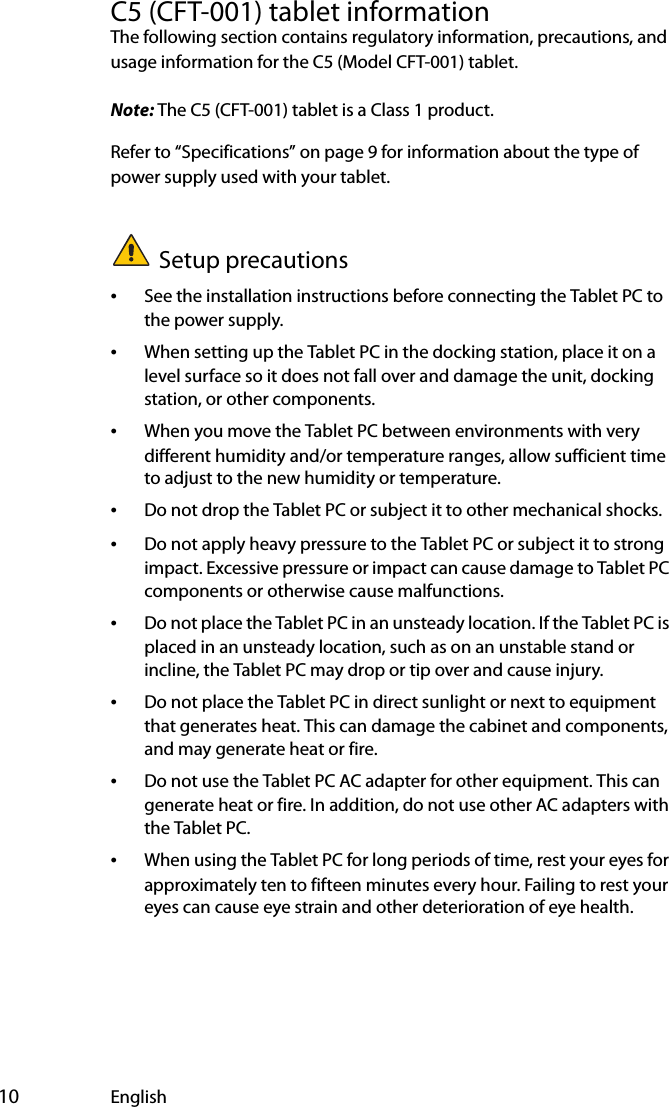
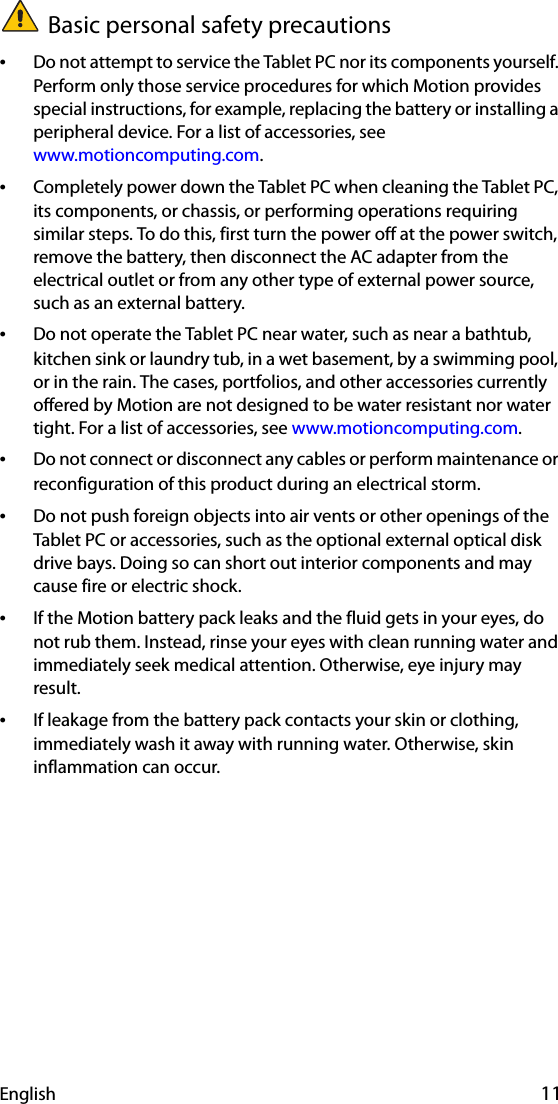
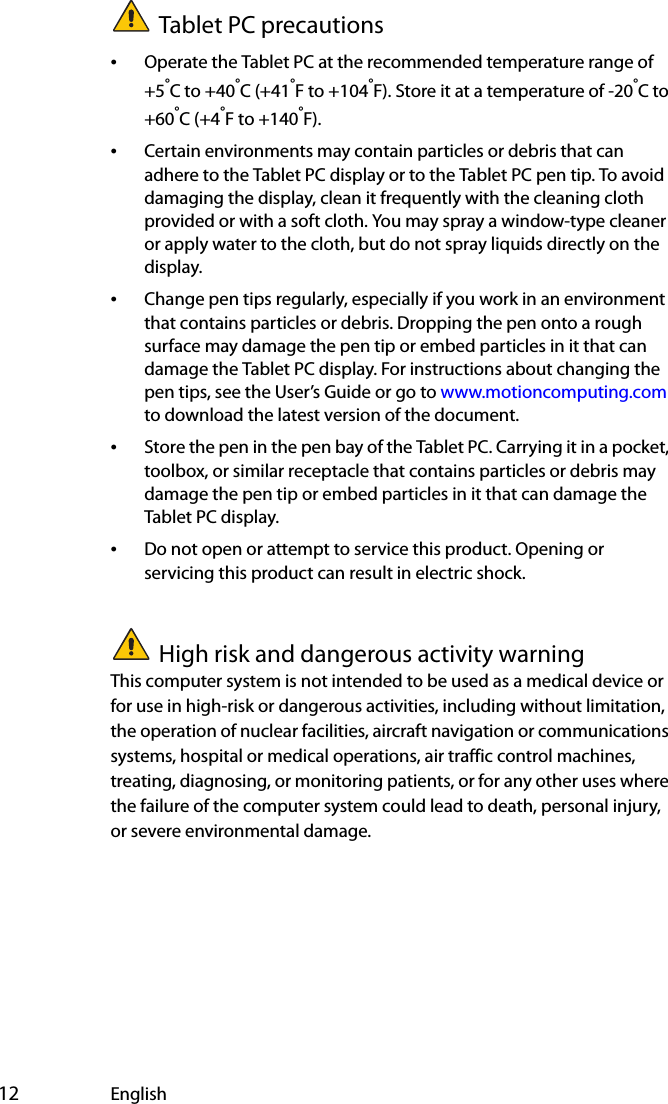
![English 13Clinical usage notice (C5 [CFT-001] only)The Tablet PC is intended to be used for patient data collection, identification, records, and so on. The Tablet PC is not intended to be used to diagnose, treat, or monitor patients under medical supervision. The Tablet PC should not make direct physical or electrical contact with the patient, transfer energy to the patient, or detect such energy transfer to or from the patient.Tablet PC disposal•Do not dispose of the unit with general waste.•The unit contains mercury in its phosphor tubes. Follow your local regulations for disposal of the unit.•If you are unable to locate a disposal site, contact your reseller or Motion Computing.Cabling and power cord precautions •Power cord sets for use in other countries must meet the requirements of that country. Use the appropriate AC adapter and power cord for your locale. For information about power cord set requirements, contact the Motion Reseller from whom you purchased the product, or contact Motion Computing if you purchased the product from us.•If no power cord was provided for your Tablet PC or for an accessory, purchase a power cord that is approved for use in your country and that matches the required voltage and amperage rating of the Tablet PC.•If you use an extension cord with your AC adapter, ensure that the total ampere rating of the products plugged into the extension cord does not exceed the ampere rating of the extension cable.•When using your power cord, make sure to position it around objects so it will not be cut or punctured.](https://usermanual.wiki/Xplore-Technologies-of-America/HWMSMC5725.Users-Manual-Safety-Info/User-Guide-1079955-Page-13.png)
![14 EnglishITE power adapter precautions•Use only the AC adapter and power cord approved for this Tablet PC or Tablet PC accessory. Use of another type of AC adapter may risk fire or explosion.•Place the AC adapter in a ventilated area, such as on a desktop or the floor, when you use it to run the Tablet PC or to charge the battery. Do not cover the AC adapter with papers or other items that will reduce cooling; also, do not use the AC adapter while it is inside a carrying case.•Be sure that nothing rests on the AC adapter’s power cable and that the cable is not located where it can be tripped over or stepped on.•Disconnect power cords and cables by grasping the connector, not by pulling on the cable itself. As you pull out the connector, keep it evenly aligned to avoid bending any connector pins. Before you connect a cable, make sure both connectors are correctly aligned.For information about the medical power adapter (C5 [CFT-001] only), see “Medical power adapter precaution (C5 [CFT-001] only)” on page 14.Medical power adapter precaution (C5 [CFT-001] only)Additional equipment connected to medical electrical equipment must comply with the respective IEC or ISO standards (e.g. IEC 60950-1 for data processing equipment). Furthermore, all configurations shall comply with the requirements for medical electrical systems (see IEC 60601-1 or clause 16 of the 3Ed. of IEC 60601-1, respectively). Anybody connecting additional equipment to medical electrical equipment configures a medical system and is therefore responsible that the system complies with the requirements for medical electrical systems. Attention is drawn to the fact that local laws take priority over the above mentioned requirements. If in doubt, consult your local representative or the technical service department.](https://usermanual.wiki/Xplore-Technologies-of-America/HWMSMC5725.Users-Manual-Safety-Info/User-Guide-1079955-Page-14.png)
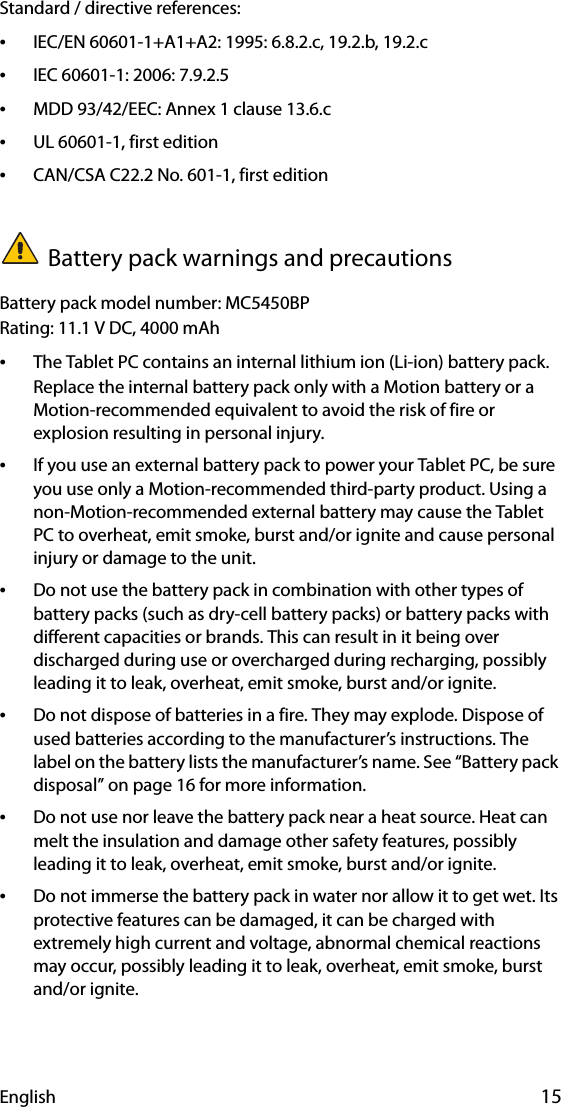
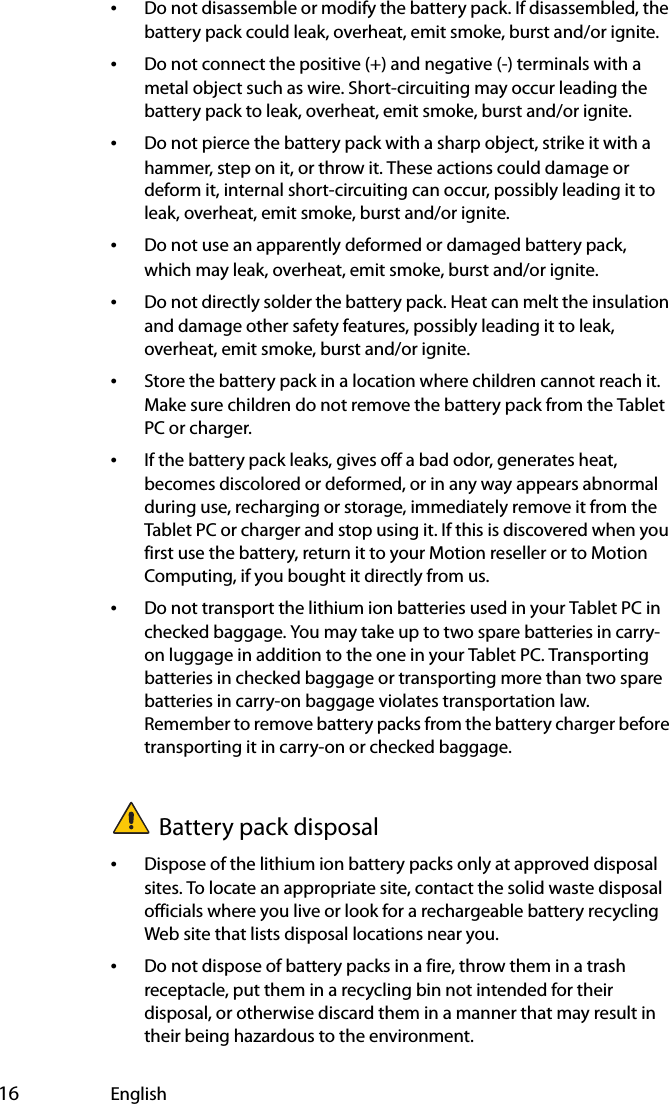
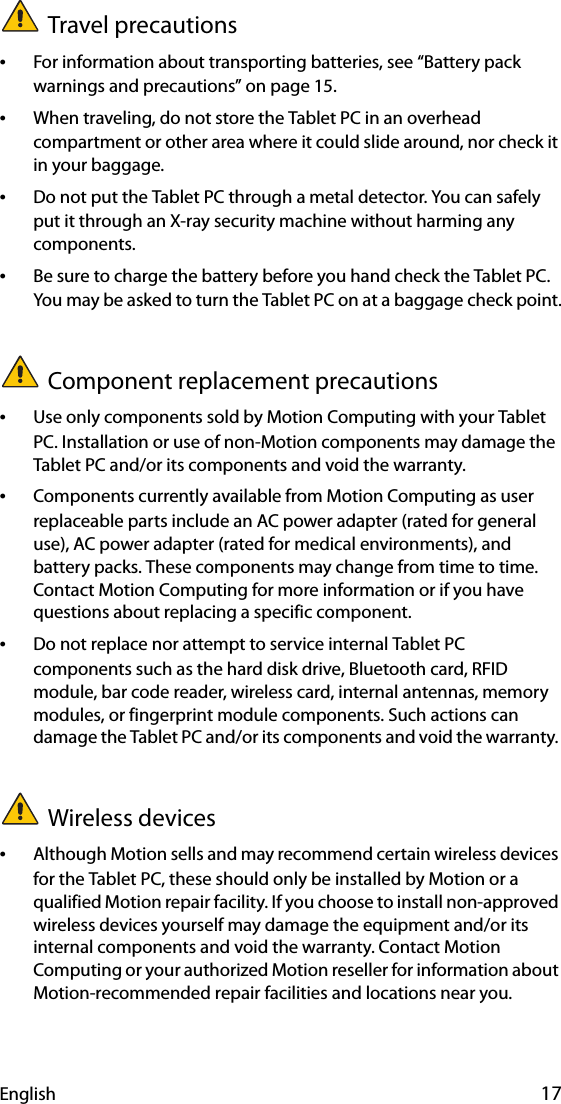
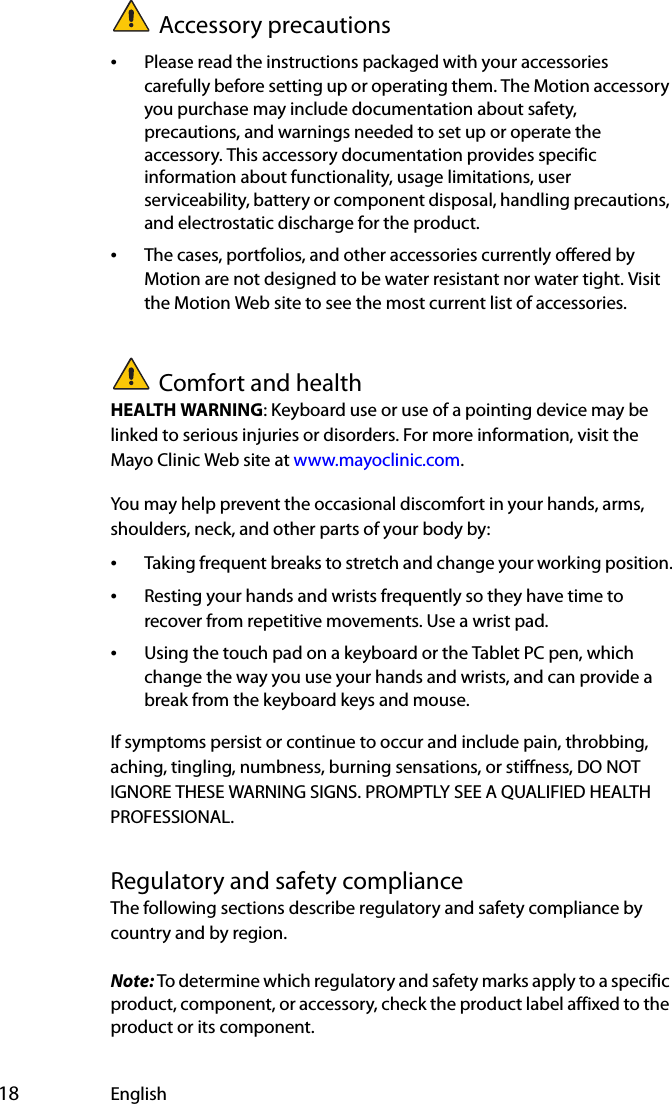
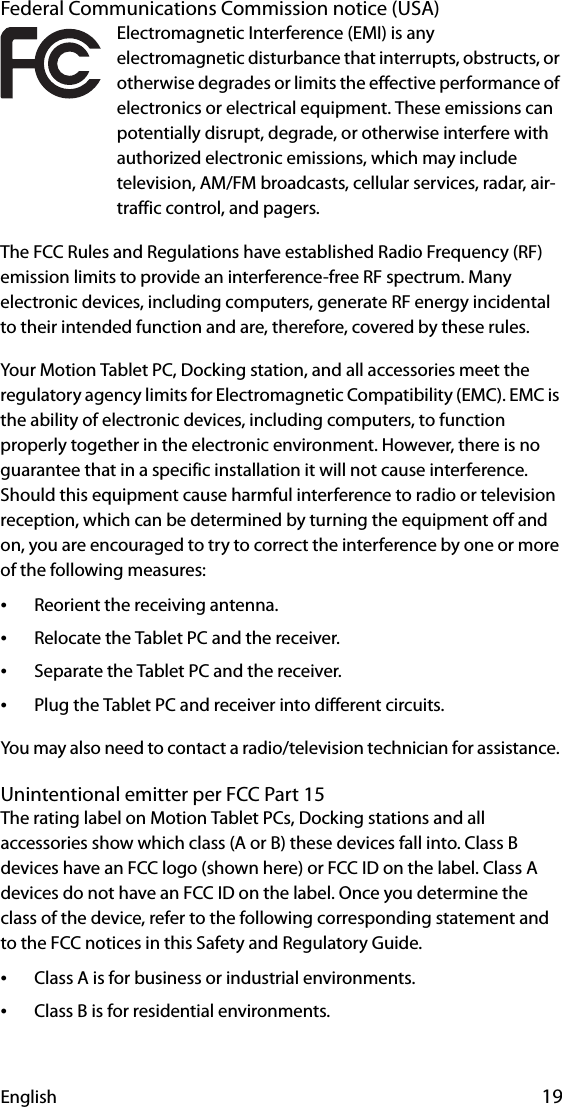
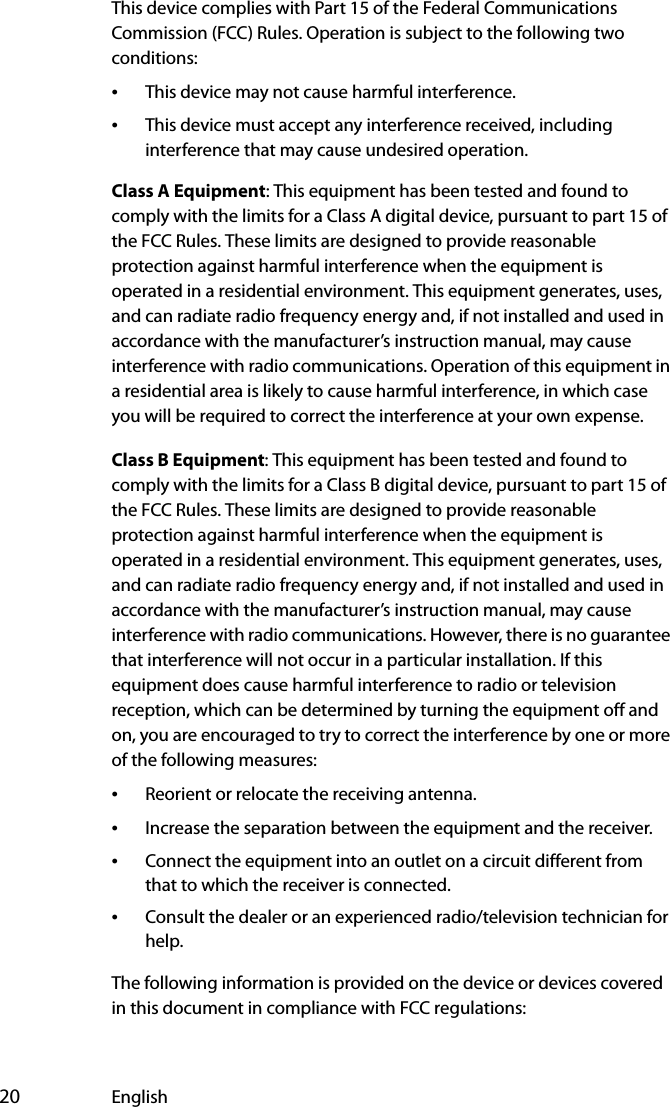
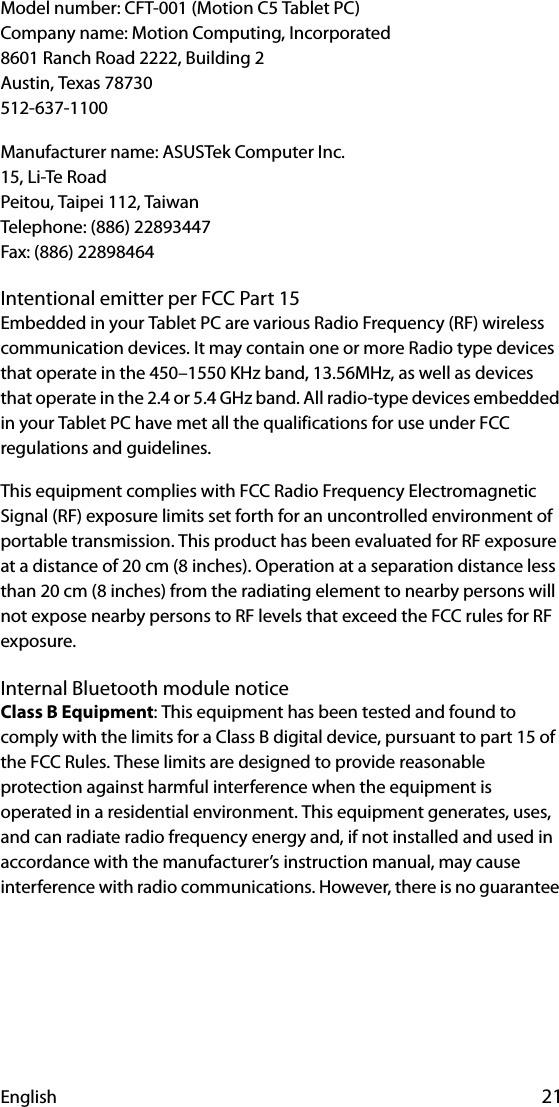
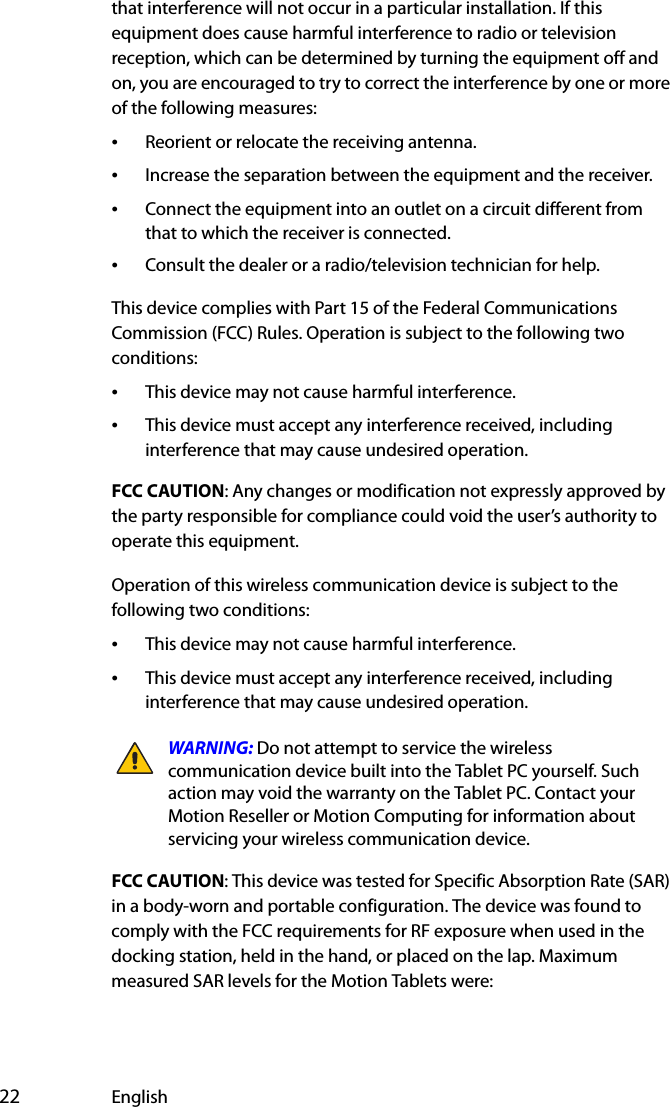
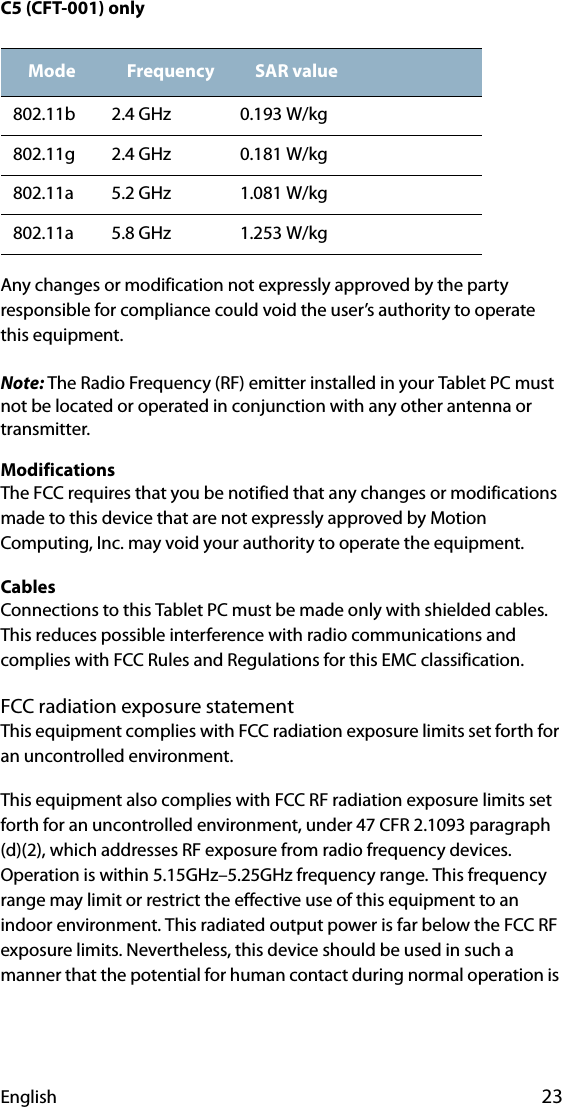
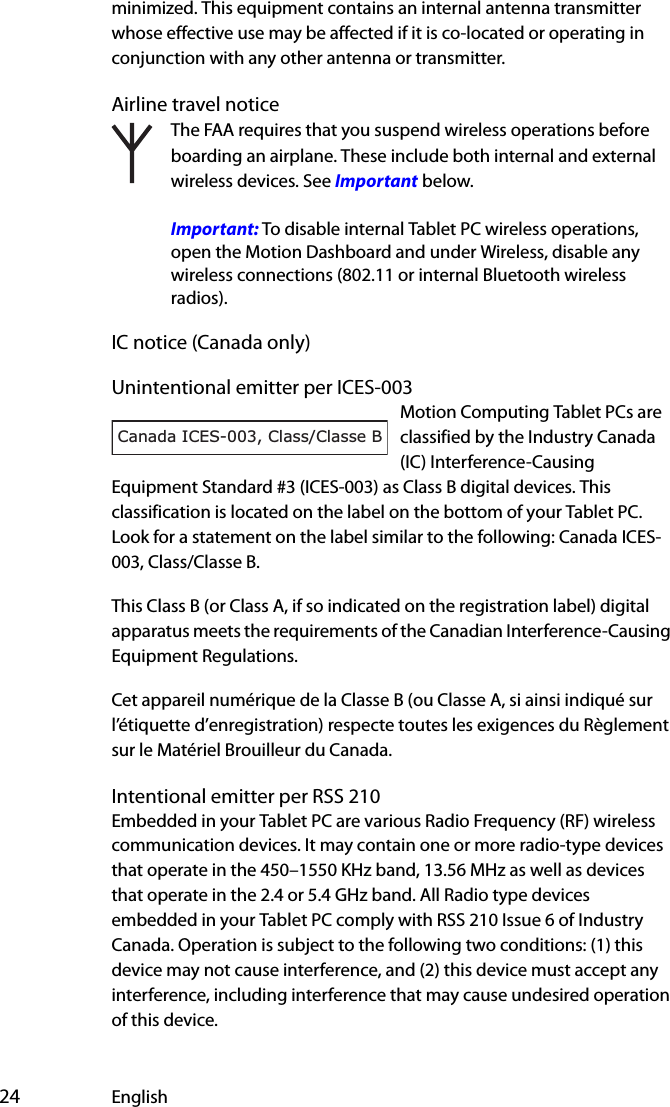
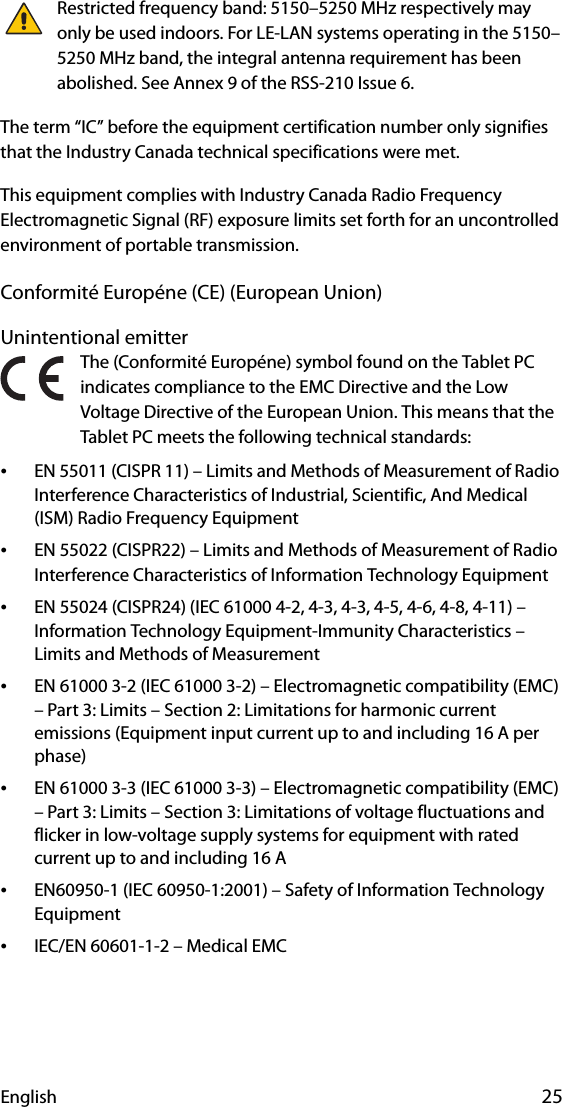
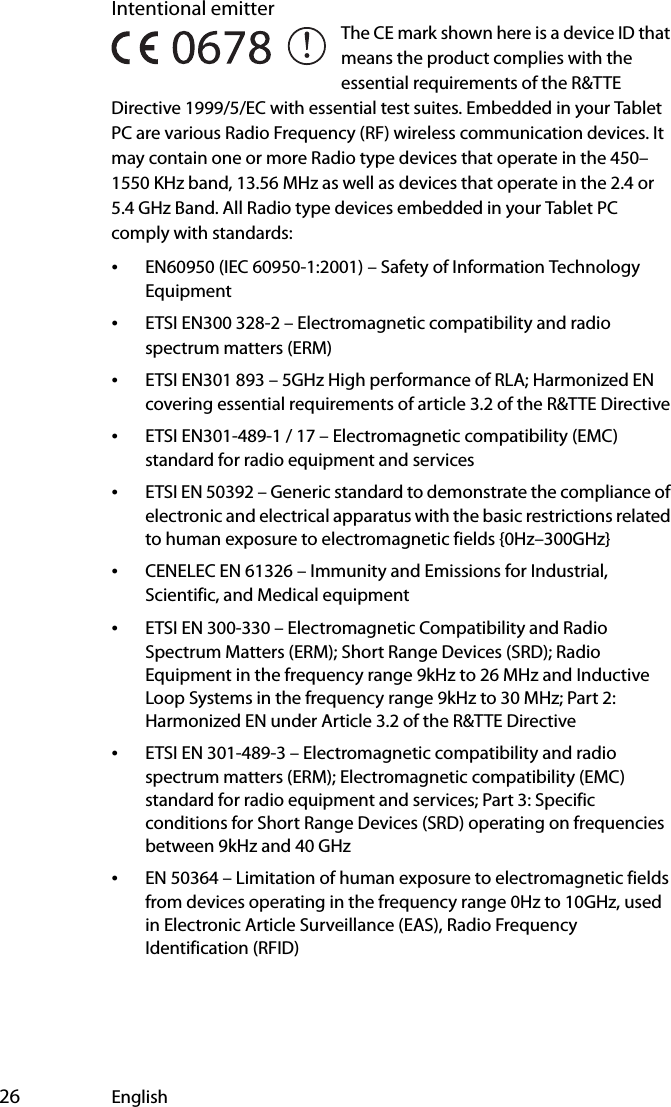
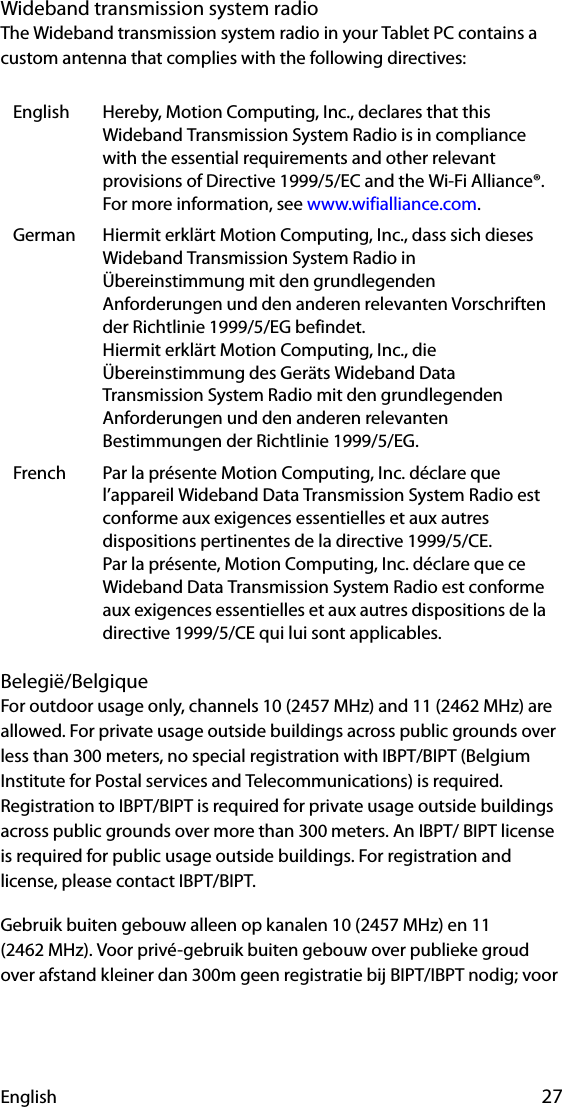
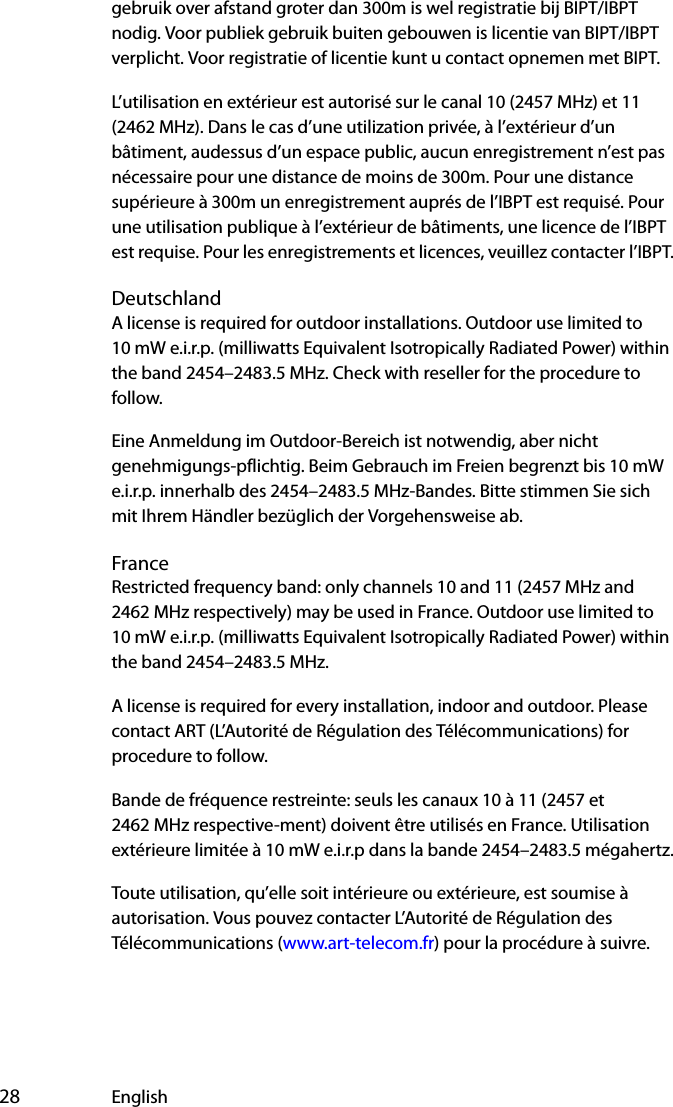
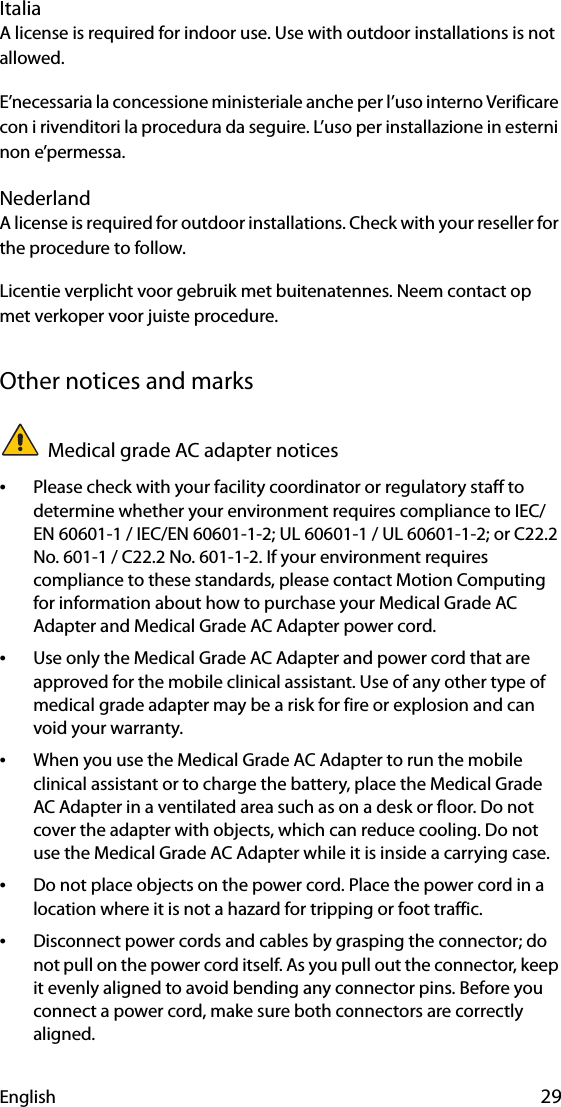
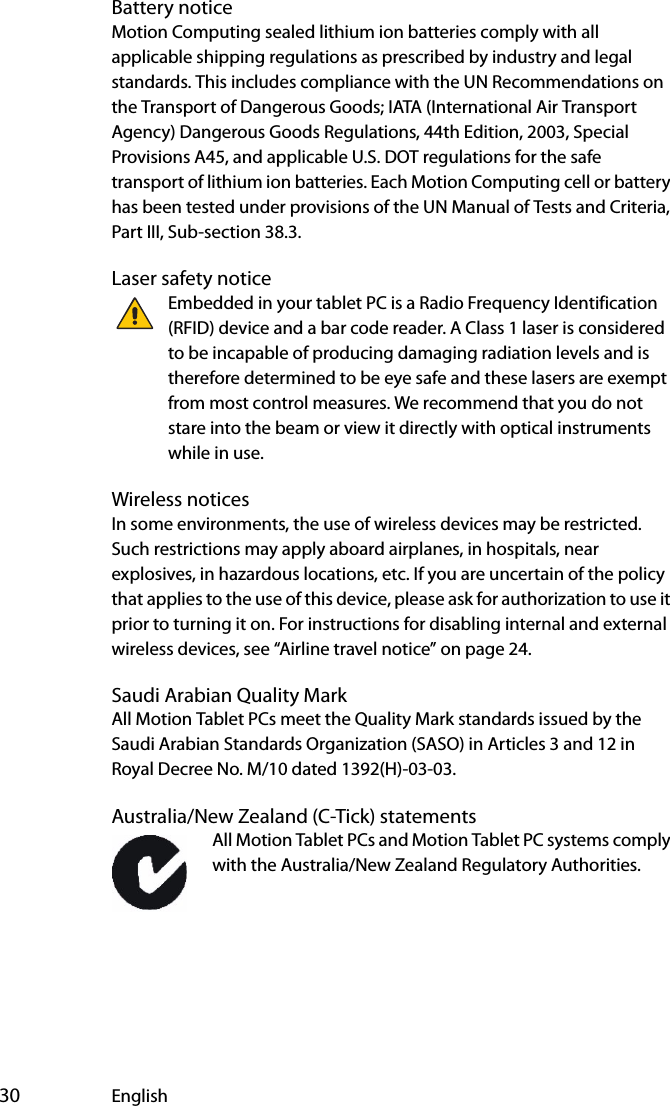
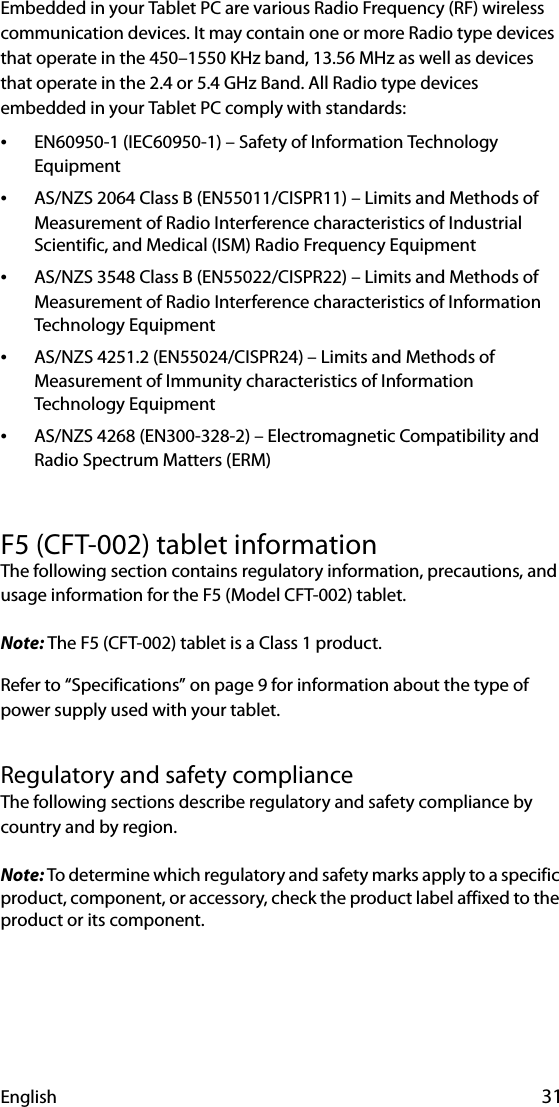
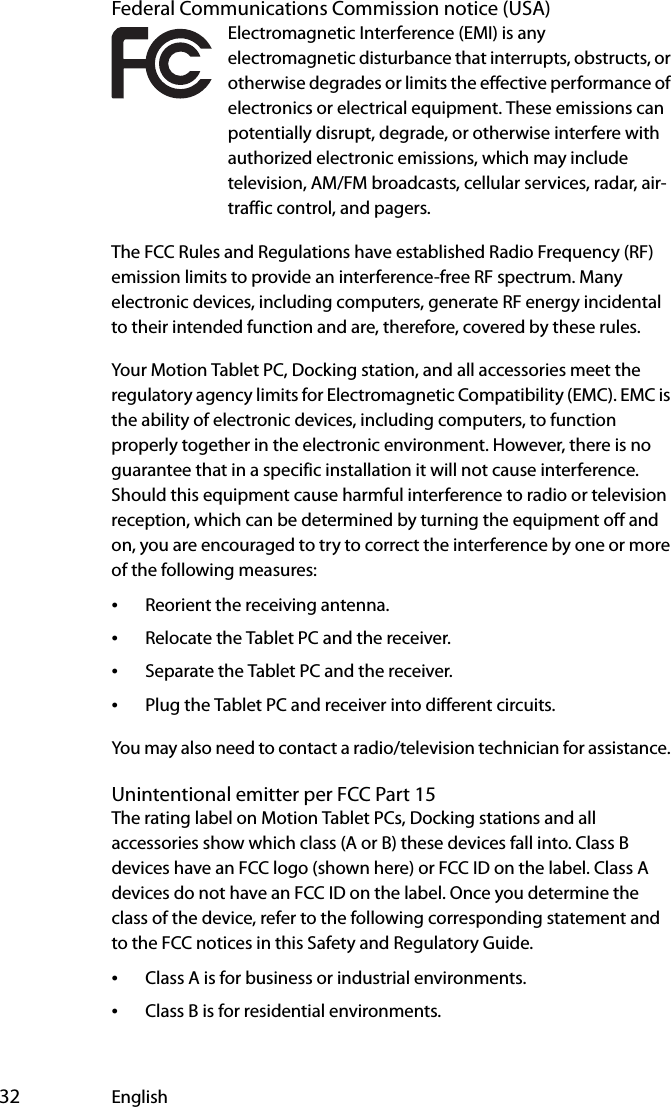
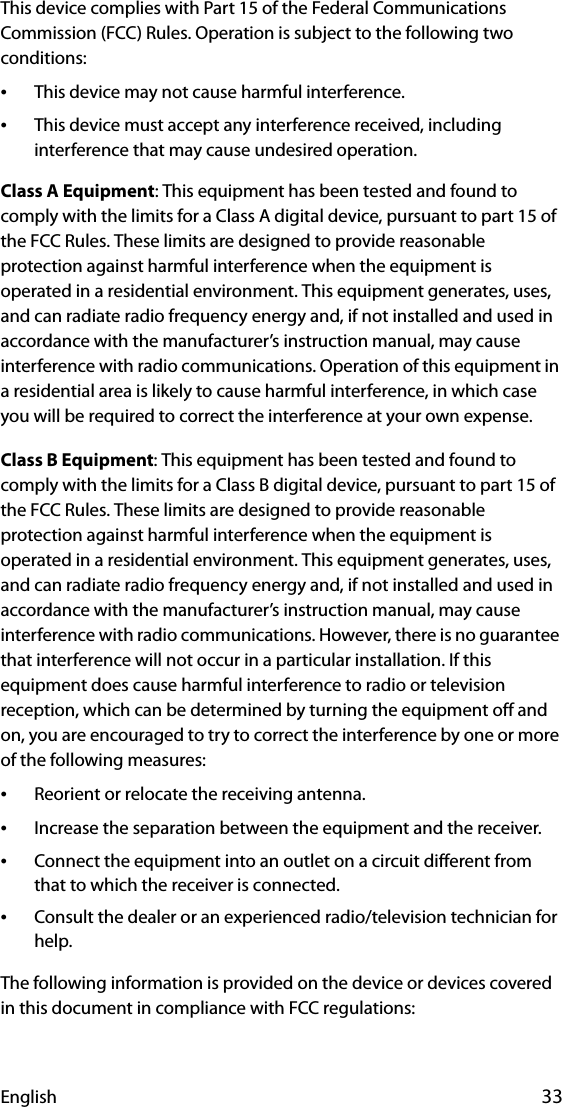
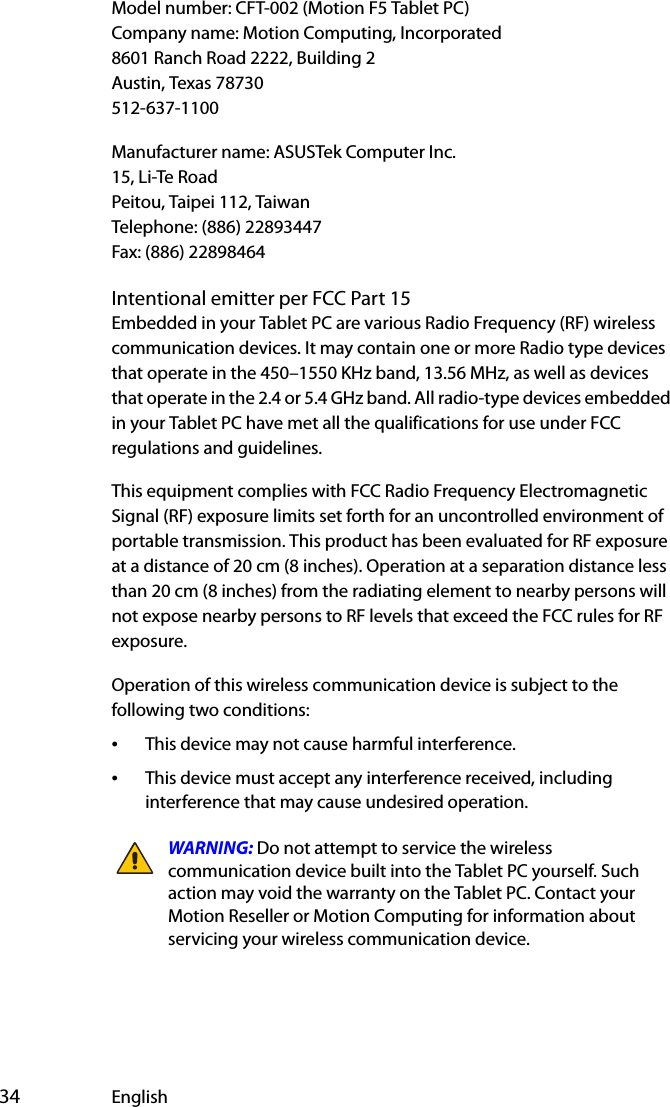
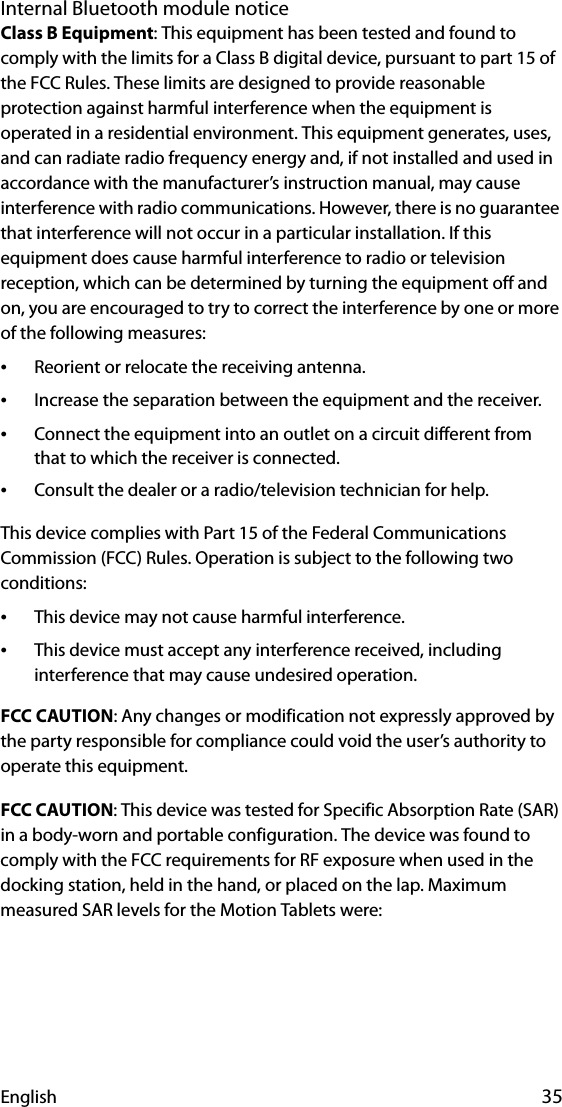
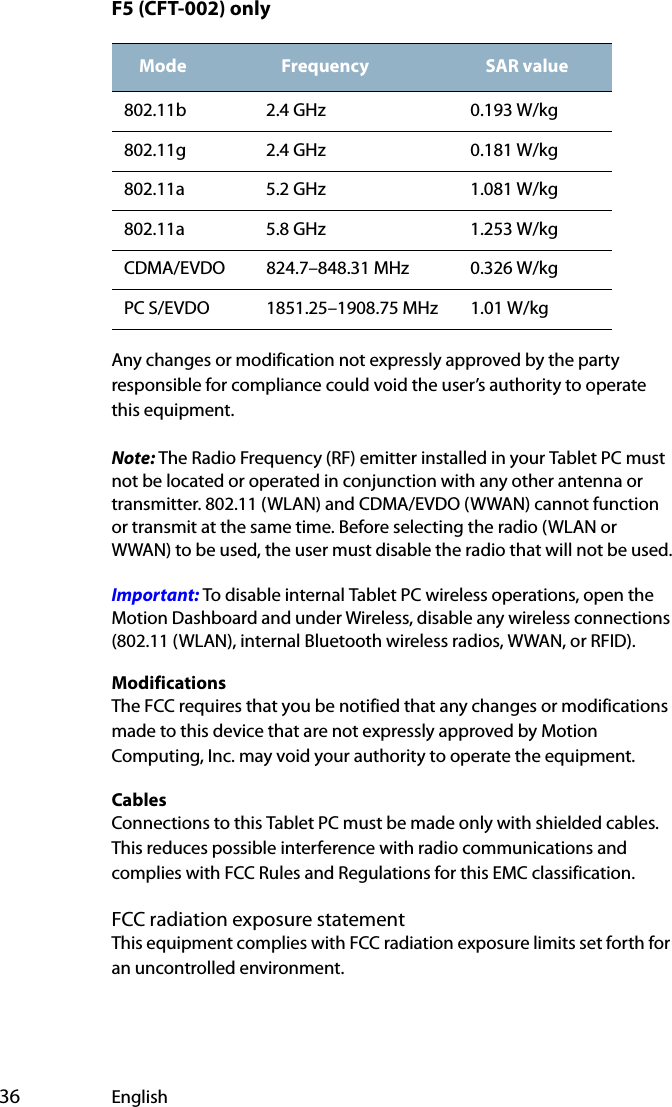
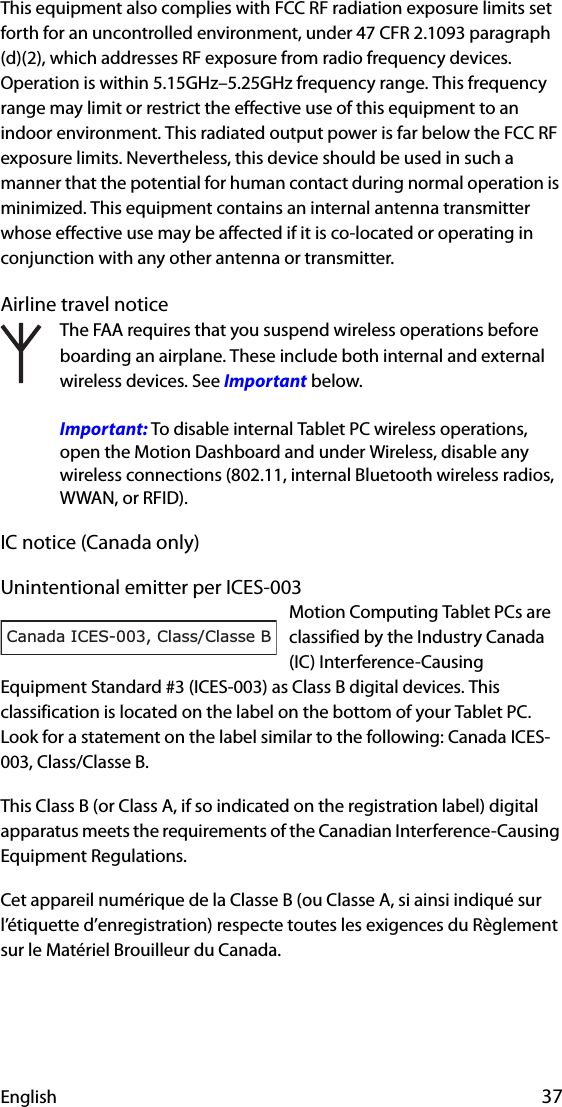
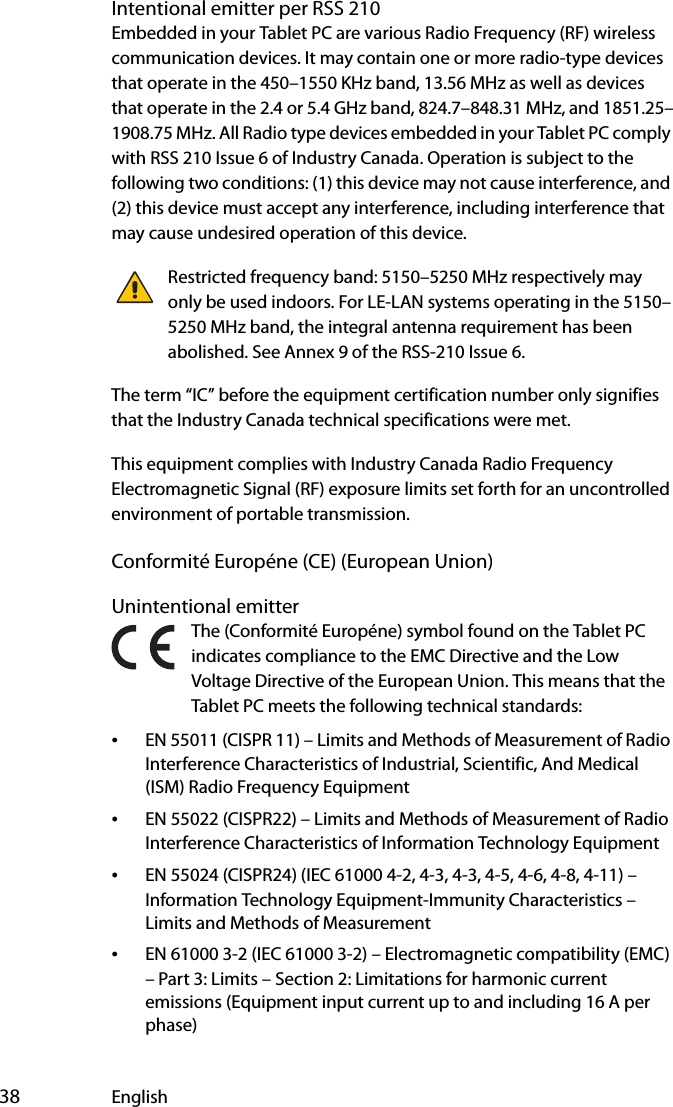
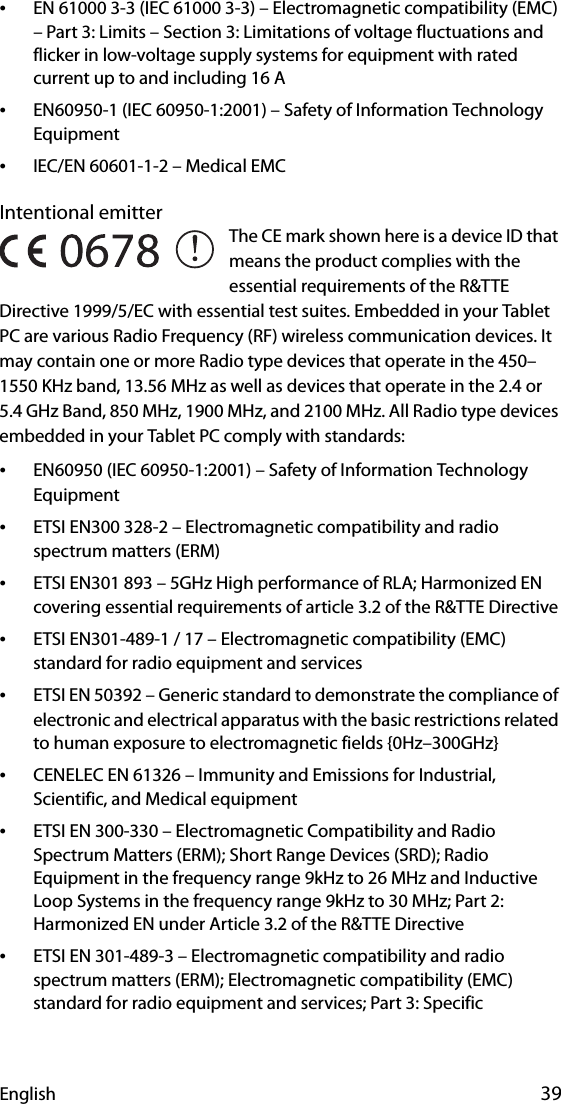
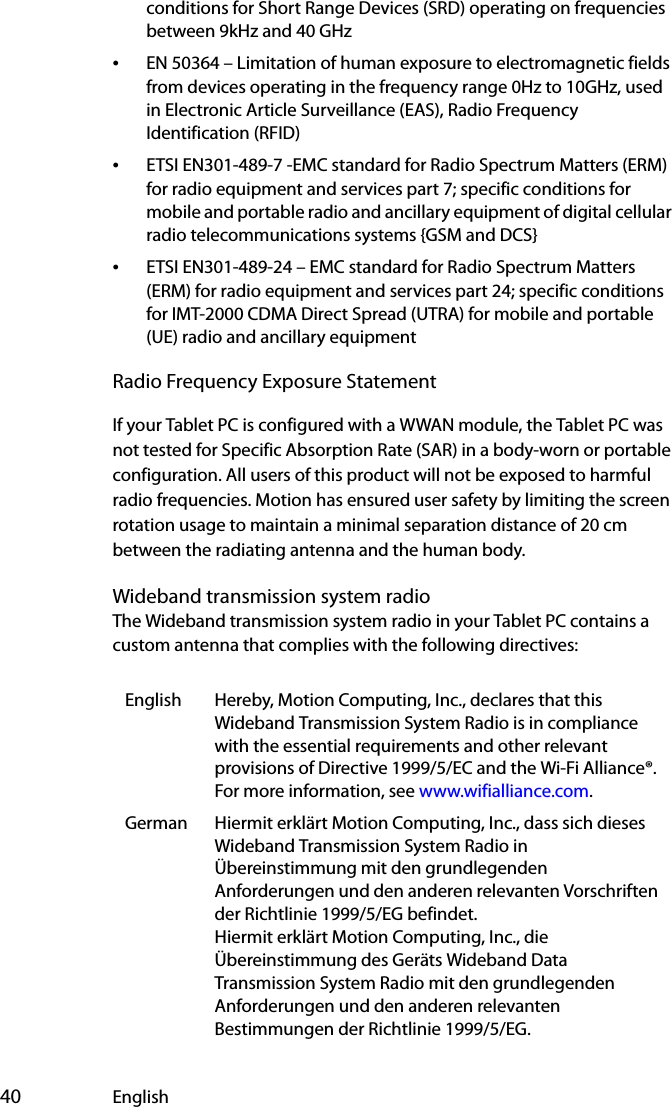
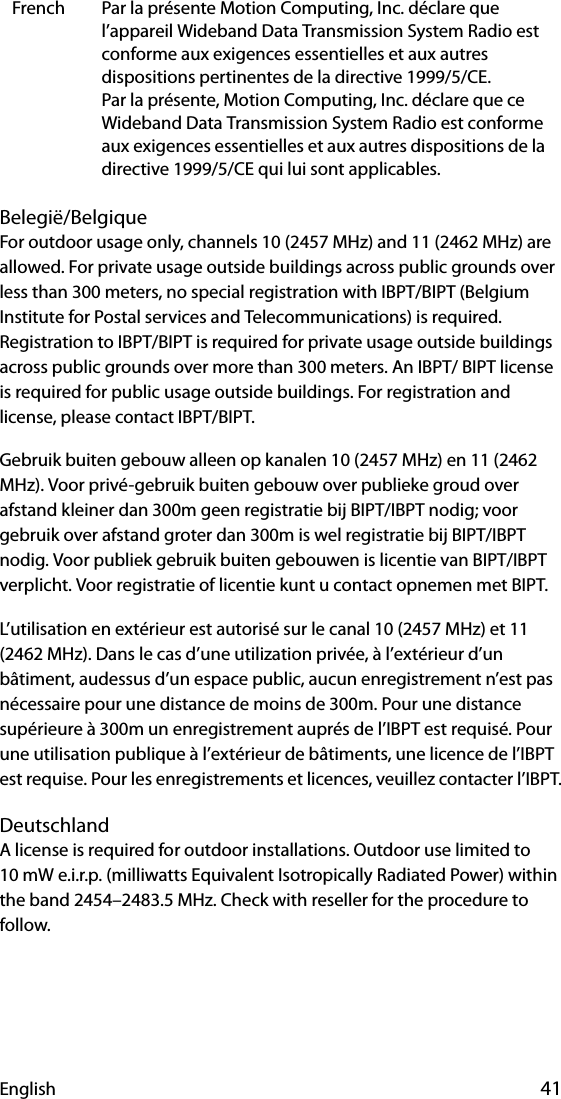
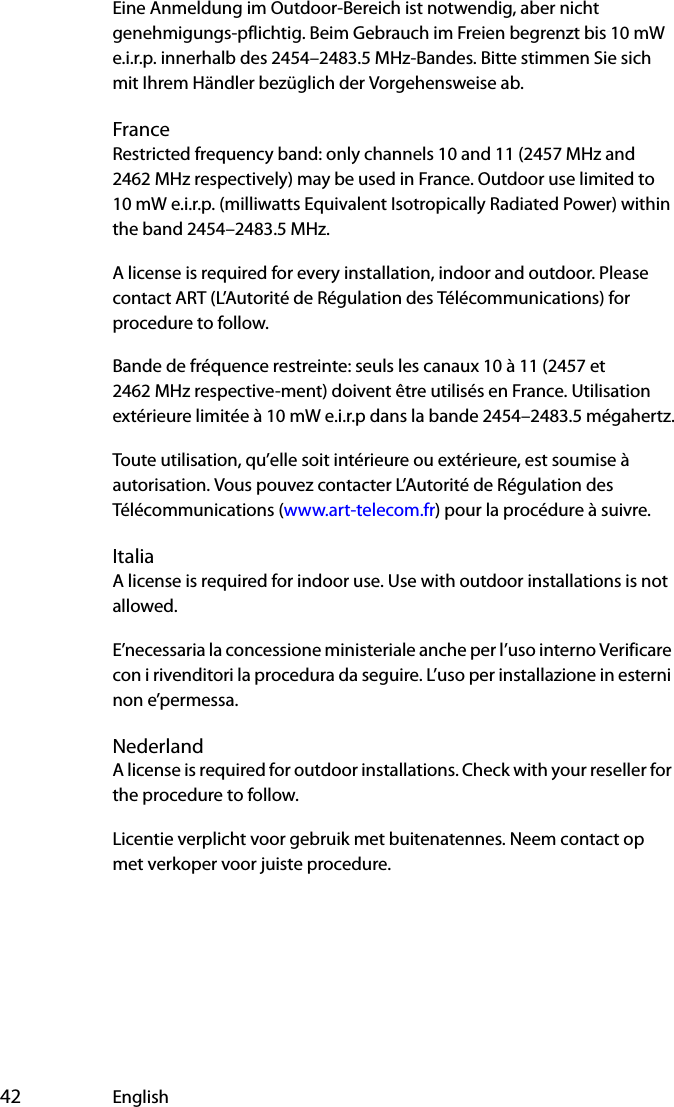
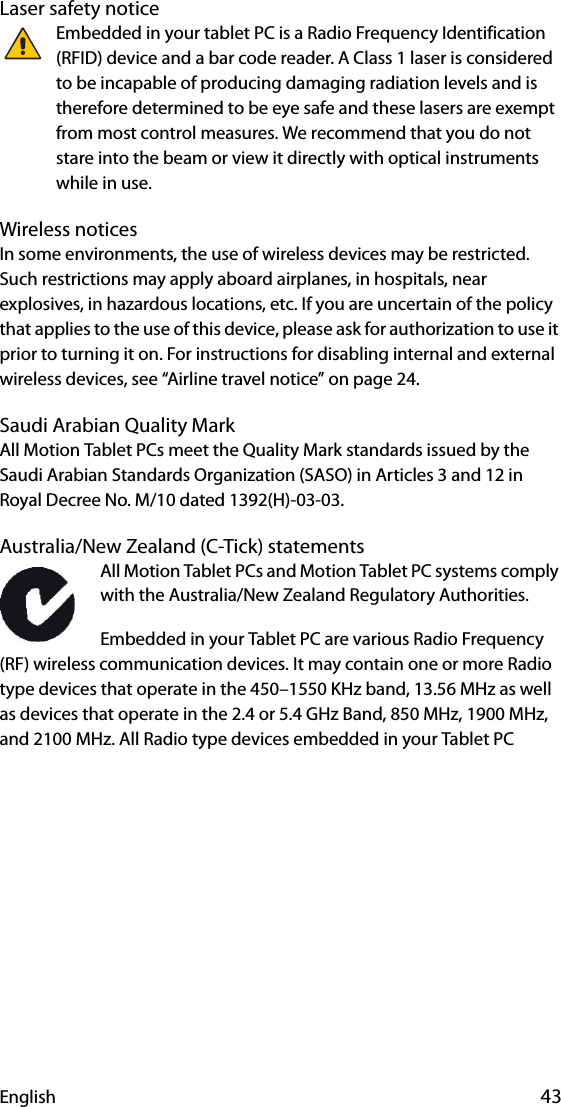
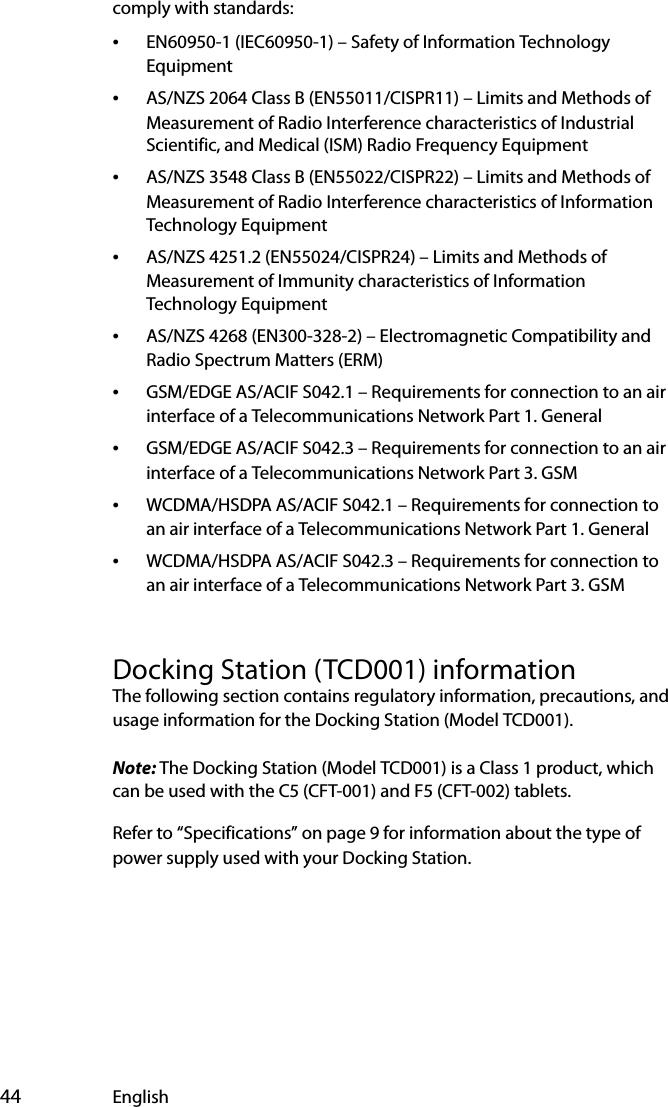
![English 45Setup precautions•See the installation instructions before connecting the Docking Station to the power supply.•Do not drop the Docking Station or subject it to other mechanical shocks.•Do not apply heavy pressure to the Docking Station or subject it to strong impact. Excessive pressure or impact can cause damage to Docking Station components or otherwise cause malfunctions.•Do not place the Docking Station in an unsteady location. If the Docking Station is placed in an unsteady location, such as on an unstable stand or incline, the Docking Station may drop or tip over and cause injury.•Do not place the Docking Station in direct sunlight or next to equipment that generates heat. This can damage the cabinet and components, and may generate heat or fire.•Do not use the AC adapter for other equipment. This can generate heat or fire. In addition, do not use other AC adapters with the Docking Station.Clinical usage notice (C5 [CFT-001] only)The Docking Station is intended for charging of the Tablet PC and providing connectivity for various peripherals. The Docking Station is not intended to be used to diagnose, treat, or monitor patients under medical supervision. The Docking Station should not make direct physical or electrical contact with the patient, transfer energy to the patient, or detect such energy transfer to or from the patient.Basic personal safety precautions•Do not attempt to service the Docking Station nor its components yourself.•Completely power down the Docking Station when cleaning the Docking Station, its components, or chassis, or performing operations requiring similar steps. To do this, disconnect the AC](https://usermanual.wiki/Xplore-Technologies-of-America/HWMSMC5725.Users-Manual-Safety-Info/User-Guide-1079955-Page-45.png)

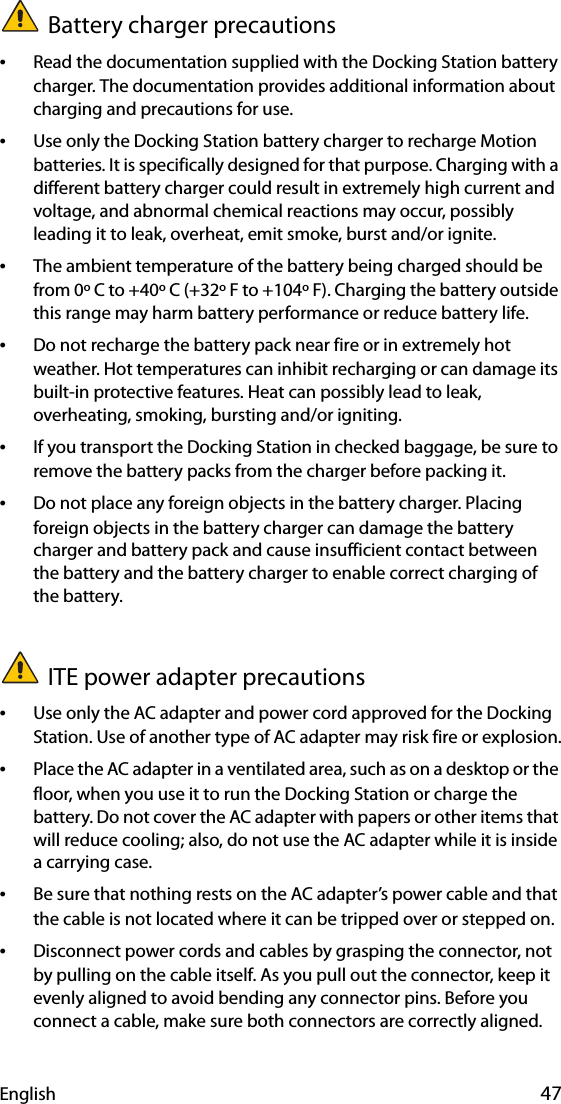
![48 EnglishFor information about the medical power adapter, see “Medical power adapter precaution (C5 [CFT-001] only)”.Medical power adapter precaution (C5 [CFT-001] only)Additional equipment connected to medical electrical equipment must comply with the respective IEC or ISO standards (e.g. IEC 60950 for data processing equipment). Furthermore, all configurations shall comply with the requirements for medical electrical systems (see IEC 60601-1 or clause 16 of the 3Ed. of IEC 60601-1, respectively). Anybody connecting additional equipment to medical electrical equipment configures a medical system and is therefore responsible that the system complies with the requirements for medical electrical systems. Attention is drawn to the fact that local laws take priority over the above mentioned requirements. If in doubt, consult your local representative or the technical service department.Standard / directive references:•IEC 60601-1+A1+A2: 1995: 6.8.2.c, 19.2.b, 19.2.c•IEC 60601-1: 2006: 7.9.2.5•MDD 93/42/EEC: Annex 1 clause 13.6.c•UL 60601-1, first edition•CAN/CSA C22.2 No. 601-1, first editionMotion-recommended third-party accessories•Use only Motion-recommended third-party accessories with the Docking Station.•If you choose to use a non-Motion-recommended third-party accessory, it is at your own risk and may damage the Docking Station, the Tablet PC, and its components and void the warranty.Laser safety noticeFor safety and regulatory information about third-party products that may contain Class 1 laser equipment, see the documentation shipped with the product.](https://usermanual.wiki/Xplore-Technologies-of-America/HWMSMC5725.Users-Manual-Safety-Info/User-Guide-1079955-Page-48.png)
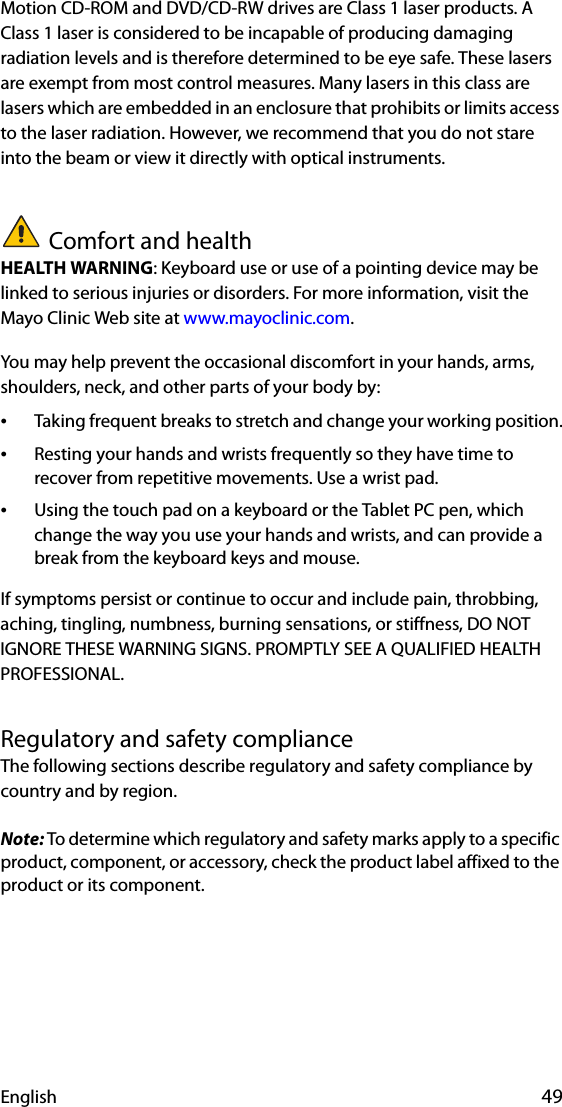
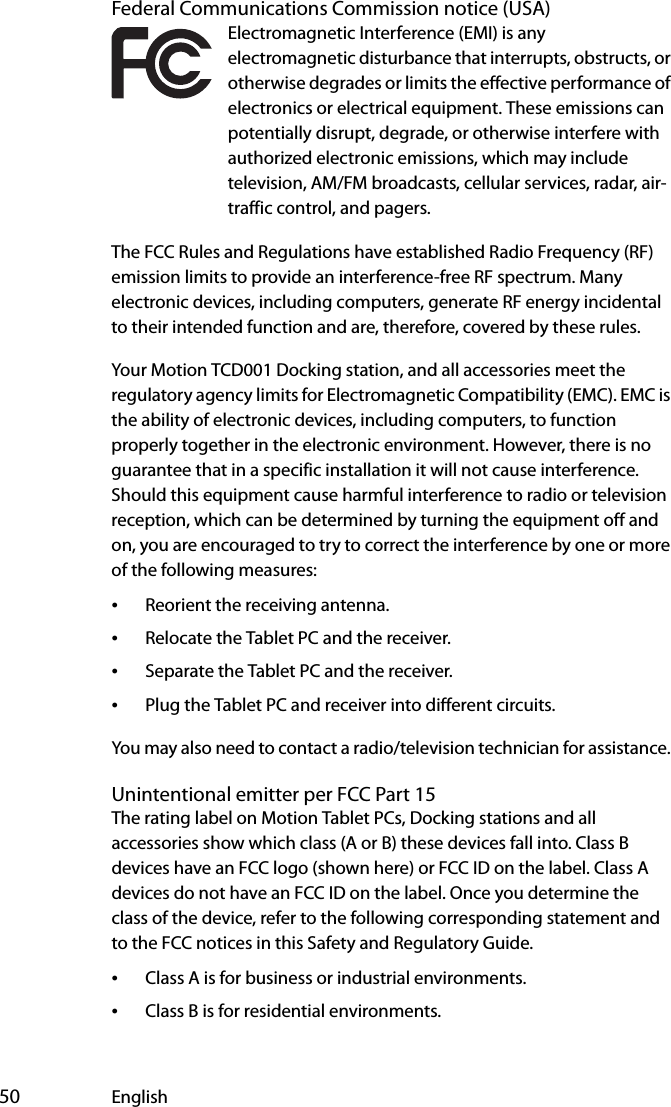
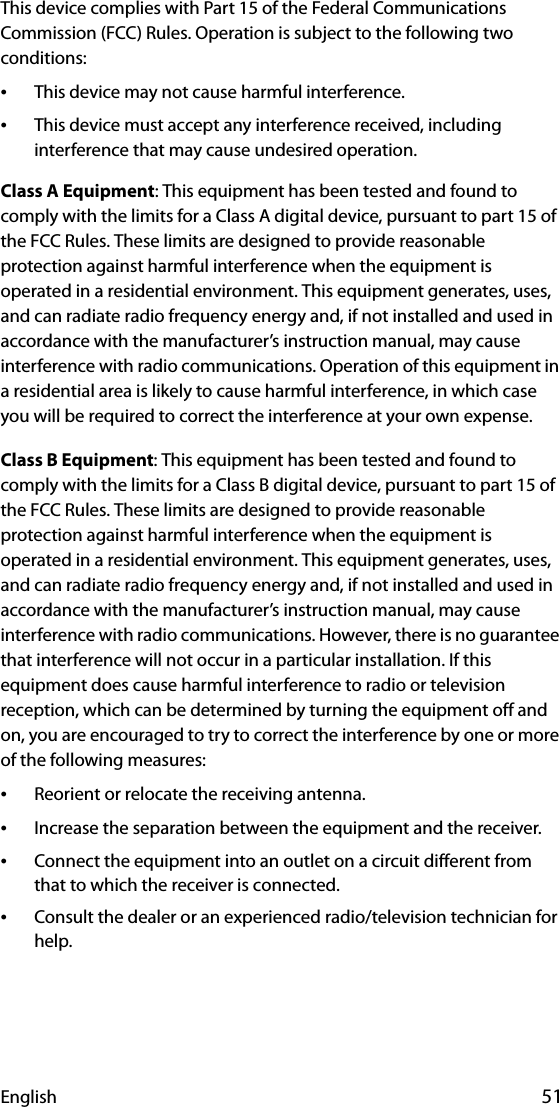
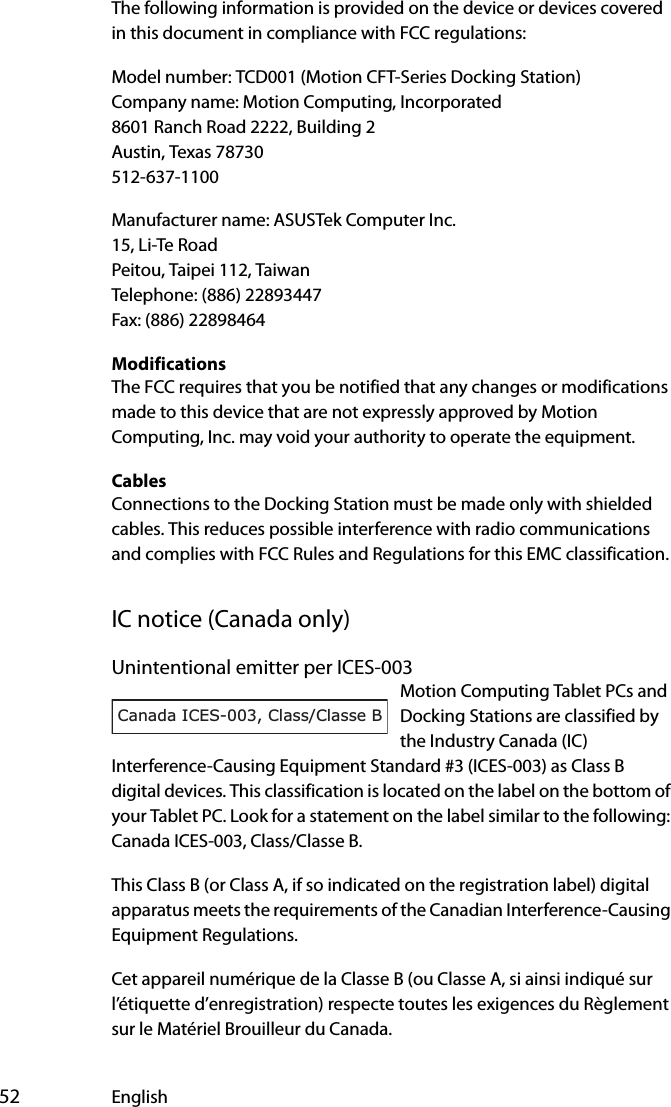
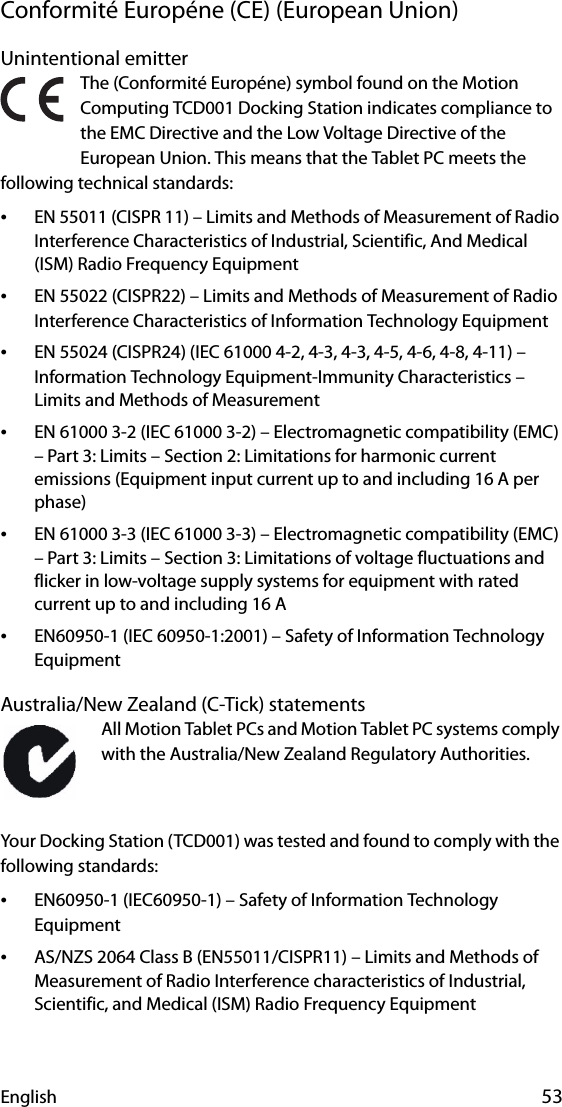
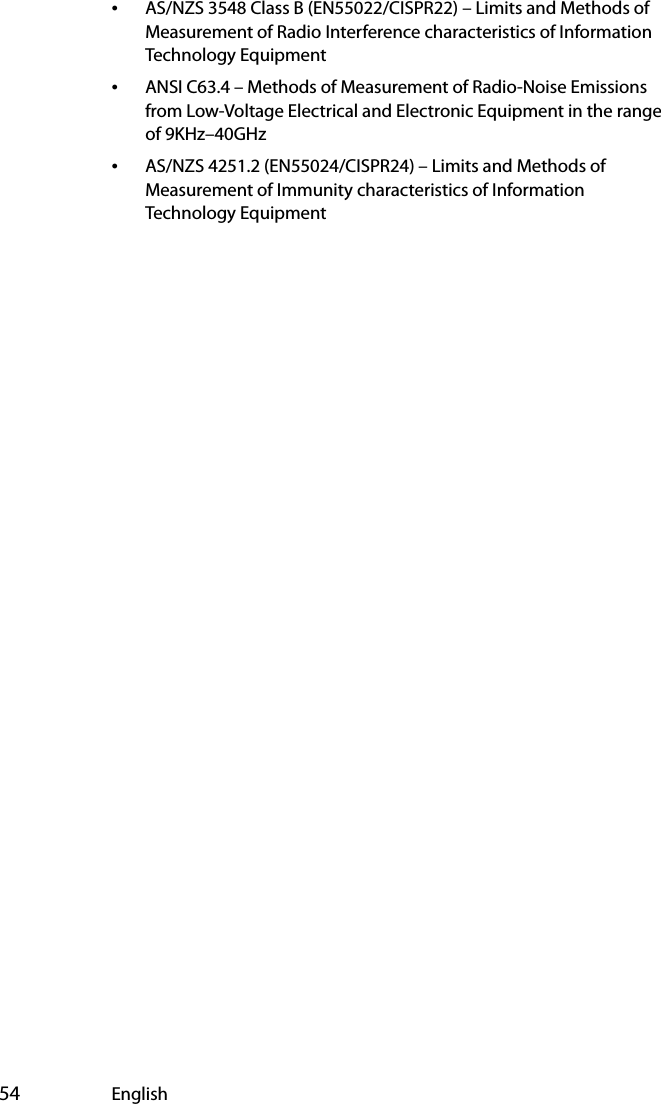
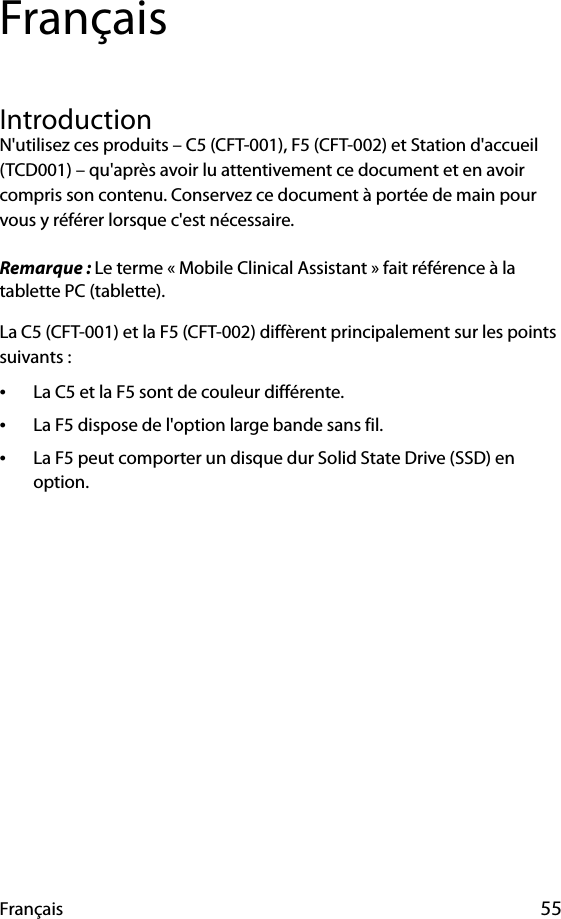
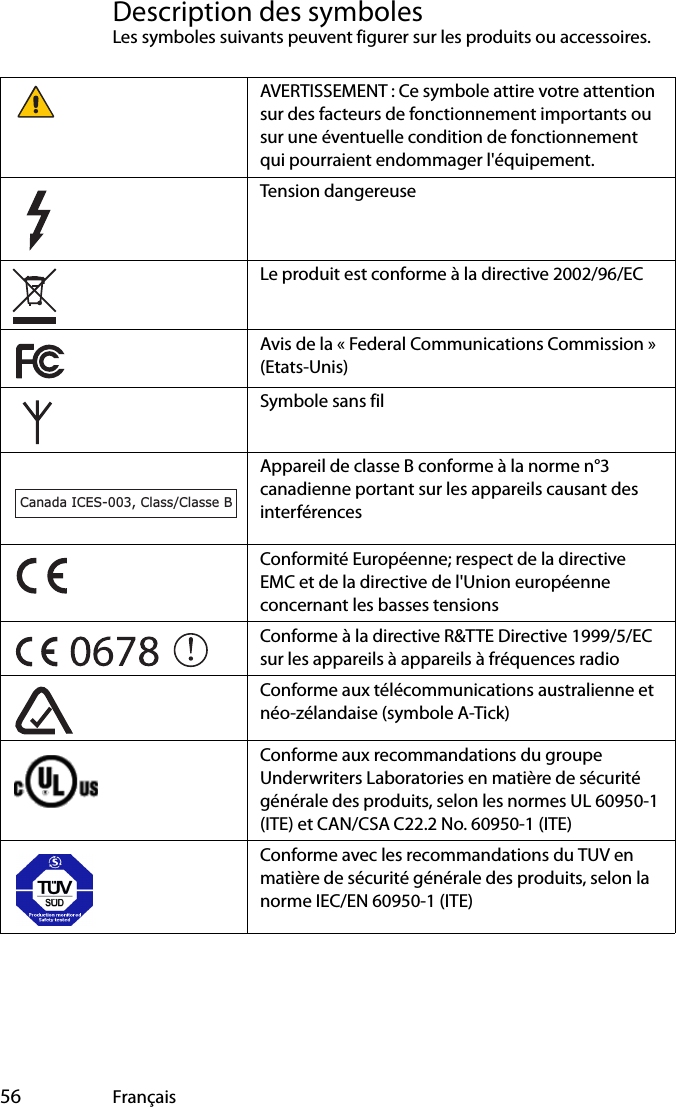
![Français 57SpécificationsInformations relatives à la sécurité du produitLes tablettes PC et accessoires Motion sont conçus pour optimiser la sécurité, réduire les déformations et supporter des conditions difficiles en cas de déplacement. Cependant, pour réduire encore le risque de dommage corporel ou matériel, certaines précautions doivent être prises.Avis d'exclusion de responsabilité de montage et d'installation de produitMotion Computing ne saurait être tenu responsable quel que soit le fondement de la responsabilité (y compris, mais sans s'y limiter, le droit législatif, des contrats, le droit de la responsabilité civile délictuelle ou le droit écrit) de toute perte, dégât ou dommage corporel ou de toute autre nature (y compris, mais sans s'y limiter, les dommages directs, indirects ou spéciaux) résultant directement ou indirectement de la mise en place, de l'installation ou de l'utilisation incorrecte ou inadaptée de ses produits ou autres applications. Pour installer et utiliser les produits Motion en toute sécurité, il convient d'accorder une attention particulière aux occupants, systèmes (p. ex., l'emplacement des canalisations de carburant, les systèmes de navigation, les conduites de frein, les systèmes électriques, de train de roulement ou autres), airbags Température Marche Arrêt (stockage/transport)Température 5–40°C -20–60°CHumidité 20–80 % HR 10–90 % HRPression de l'air 697–1060 hPa 187–1060 hPaAlimentation électrique (ITE) Delta Electronics, ADP-50HH Rév. BEntrée : 1,5 A ; 100–240 V c.a. ; 50–60 Hz. Sortie : 19 V c.c. ; 2,64 A. Adaptateur secteur conforme aux normes UL 60950-1, CAN/CSA C22.2 No. 60950-1, IEC/EN 60950-1 Alimentation électriqueSinpro M/N : MPU50-107(pour la C5 [CFT-001] uniquement)Entrée : 1,35 A ; 100–240 V c.a. ; 47–63 Hz. Sortie : 19 V c.c., 2.63 A. Adaptateur secteur conforme aux normes UL 60601-1, CAN/CSA C22.2 No. 601-1, IEC/EN 60601-1.](https://usermanual.wiki/Xplore-Technologies-of-America/HWMSMC5725.Users-Manual-Safety-Info/User-Guide-1079955-Page-57.png)
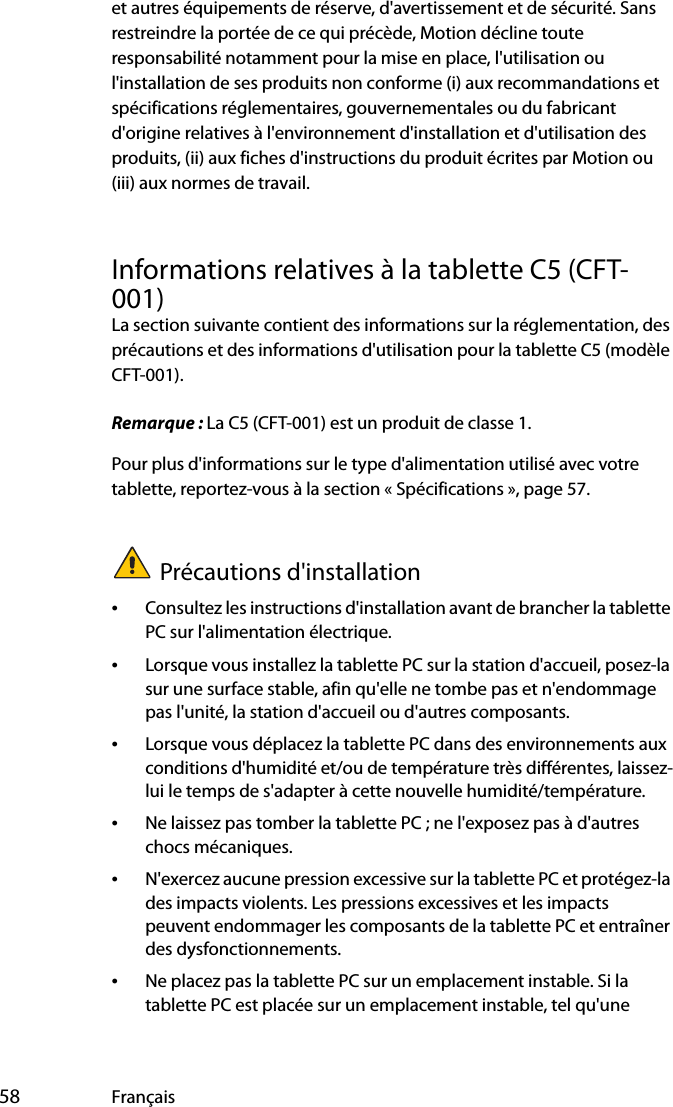
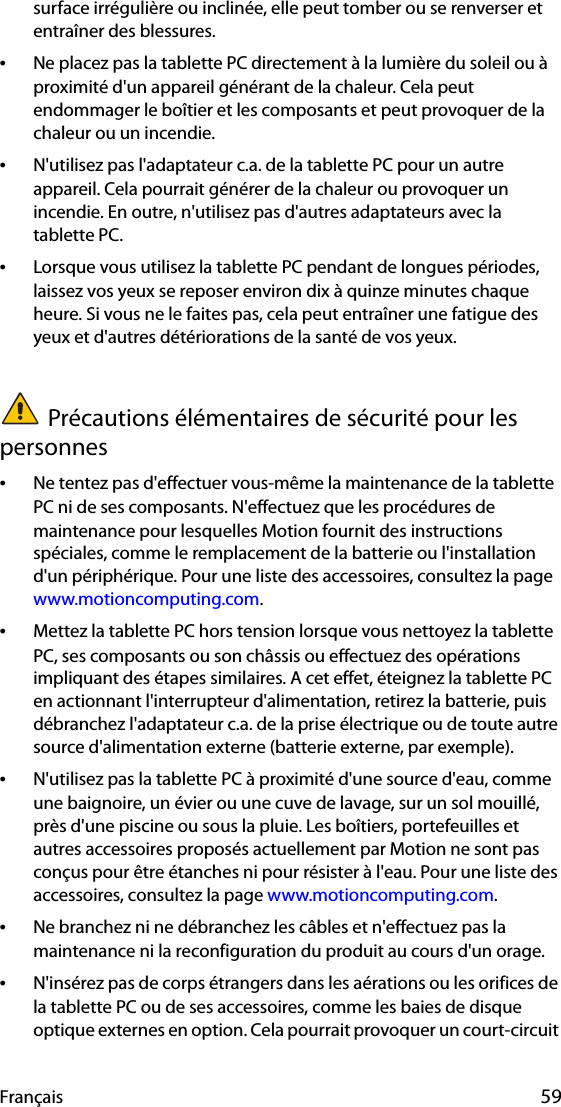
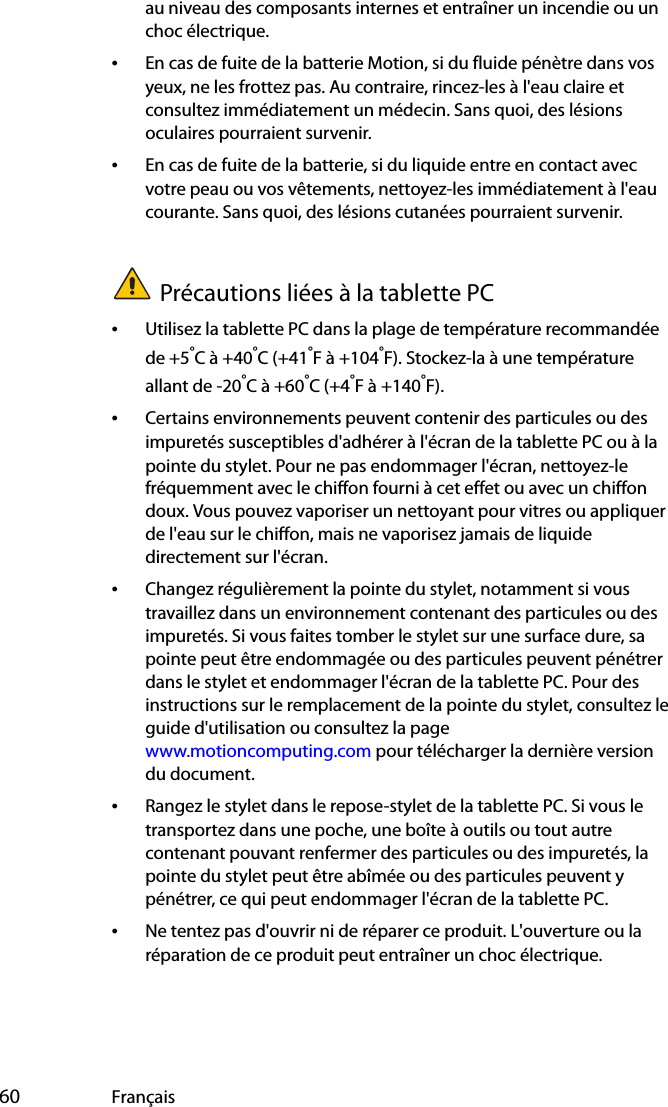
![Français 61Avertissement d'activité dangereuse et à haut risqueCet ordinateur ne doit pas être utilisé comme appareil médical ou dans des situations dangereuses ou à haut risque, y compris, mais sans s'y limiter, l'exploitation de centrales nucléaires, les systèmes de communication ou de navigation aérienne, les hôpitaux et les services médicaux, les appareils de contrôle du trafic aérien, le traitement, le diagnostic ou la surveillance de patients, ou pour tout autre usage qui pourrait susciter des pannes du système informatique et entraîner la mort ou de sérieuses blessures, ou porter gravement atteinte à l'environnement.Avis d'utilisation clinique (C5 [CFT-001] uniquement)La tablette PC est conçue pour être utilisée pour les dossiers, l'identification, la collecte de données patients, etc. La tablette PC n'est pas conçue pour établir un diagnostic, soigner ou surveiller des patients sous suivi médical. La tablette PC ne doit pas être en contact physique ou électrique avec le patient, transférer de l'énergie au patient ou détecter un transfert d'énergie de ou vers le patient.Mise au rebut de la tablette PC•Ne vous débarrassez pas de l'unité avec les déchets généraux.•L'unité contient du mercure dans ses tubes au phosphore. Respectez la réglementation locale pour le recyclage de l'unité.•Si vous ne parvenez pas à localiser un site de mise au rebut, contactez votre revendeur ou Motion Computing.Précautions liées aux câbles électriques et au câble d'alimentation•Les jeux de câbles d'alimentation utilisés dans d'autres pays doivent être conformes aux exigences du pays en question. Utilisez un adaptateur CA et un câble d'alimentation appropriés pour votre pays. Pour plus d'informations sur les exigences liées aux câbles d'alimentation, contactez le revendeur Motion qui vous a vendu le](https://usermanual.wiki/Xplore-Technologies-of-America/HWMSMC5725.Users-Manual-Safety-Info/User-Guide-1079955-Page-61.png)
![62 Françaisproduit ou Motion Computing si vous avez acheté le produit auprès de nos services.•Si la tablette PC ou un accessoire a été livré sans câble d'alimentation, achetez un câble d'alimentation homologué pouvant être utilisé dans votre pays et correspondant aux normes de tension/d'intensité de la tablette PC.•Si vous utilisez une rallonge avec l'adaptateur CA, assurez-vous que l'intensité nominale des produits branchés sur la rallonge ne dépasse pas l'intensité nominale de cette rallonge.•Veillez à positionner votre câble d'alimentation autour des objets pour qu'il ne soit ni coupé ni percé.Précautions liées à l'adaptateur d'alimentation ITE•N'utilisez que l'adaptateur CA et le câble d'alimentation homologués pour cette tablette PC ou ses accessoires. L'utilisation d'un autre type d'adaptateur CA peut entraîner un incendie ou une explosion.•Placez l'adaptateur CA dans un endroit aéré (sur un bureau ou sur le sol, par exemple) lorsque vous l'utilisez pour alimenter la tablette PC ou pour recharger la batterie. Ne couvrez pas l'adaptateur CA avec des papiers ou d'autres objets pouvant gêner le refroidissement et n'utilisez pas l'adaptateur CA lorsqu'il se trouve dans son boîtier de transport.•Assurez-vous qu'aucun objet ne soit posé sur le câble d'alimentation de l'adaptateur CA et que celui-ci ne puisse pas être coincé ni piétiné.•Débranchez les câbles d'alimentation et les câbles électriques en retirant le connecteur et non en tirant sur le câble. Pour retirer le connecteur, maintenez-le bien aligné afin d'éviter de plier les broches. Avant de brancher un câble, assurez-vous que les deux connecteurs sont bien alignés.Pour plus d'informations sur l'adaptateur d'alimentation médical (C5 [CFT-001] uniquement), consultez la section « Précautions liées à l'adaptateur d'alimentation médical (C5 [CFT-001] uniquement) », page 63.](https://usermanual.wiki/Xplore-Technologies-of-America/HWMSMC5725.Users-Manual-Safety-Info/User-Guide-1079955-Page-62.png)
![Français 63Précautions liées à l'adaptateur d'alimentation médical (C5 [CFT-001] uniquement)Les équipements supplémentaires connectés à l'équipement électrique médical doivent respectivement être conformes aux normes IEC ou ISO (p.ex. IEC 60950-1 pour l'équipement de traitement de données). De plus, toutes les configurations doivent respecter les exigences pour les systèmes électriques médicaux (consultez IEC 60601-1 ou la clause 16 de 3Ed. de IEC 60601-1, respectivement). Toute personne connectant un équipement supplémentaire à l'équipement électrique médical configure un système médical et est par conséquent responsable de la compatibilité du système avec les exigences pour les systèmes électriques médicaux. Nous attirons l'attention sur le fait que les réglementations locales priment sur les exigences mentionnées ci-dessus. En cas de doute, consultez votre représentant local ou le service d'entretien technique.Références des normes / directives :•IEC/EN 60601-1+A1+A2 : 1995: 6.8.2.c, 19.2.b, 19.2.c•IEC 60601-1 : 2006: 7.9.2.5•MDD 93/42/EEC : Annexe 1 clause 13.6.c•UL 60601-1, 1re édition•CAN/CSA C22.2 No. 601-1, 1re éditionPrécautions et avertissements liés à la batterieRéférence de la batterie : MC5450BPTension : 11,1 V c.c., 4000 mAh•La tablette PC est munie d'une batterie interne lithium ion (Li-ion). Remplacez la batterie interne uniquement par une batterie Motion ou par un équivalent approuvé par Motion, afin d'éviter tout risque d'incendie ou d'explosion pouvant entraîner des dommages corporels.•Si vous utilisez une batterie externe pour alimenter votre tablette PC, assurez-vous d'utiliser uniquement le produit d'un autre fabricant recommandé par Motion. L'utilisation d'une batterie externe non recommandée par Motion peut entraîner une surchauffe de la tablette PC, une émission de fumée, une explosion](https://usermanual.wiki/Xplore-Technologies-of-America/HWMSMC5725.Users-Manual-Safety-Info/User-Guide-1079955-Page-63.png)
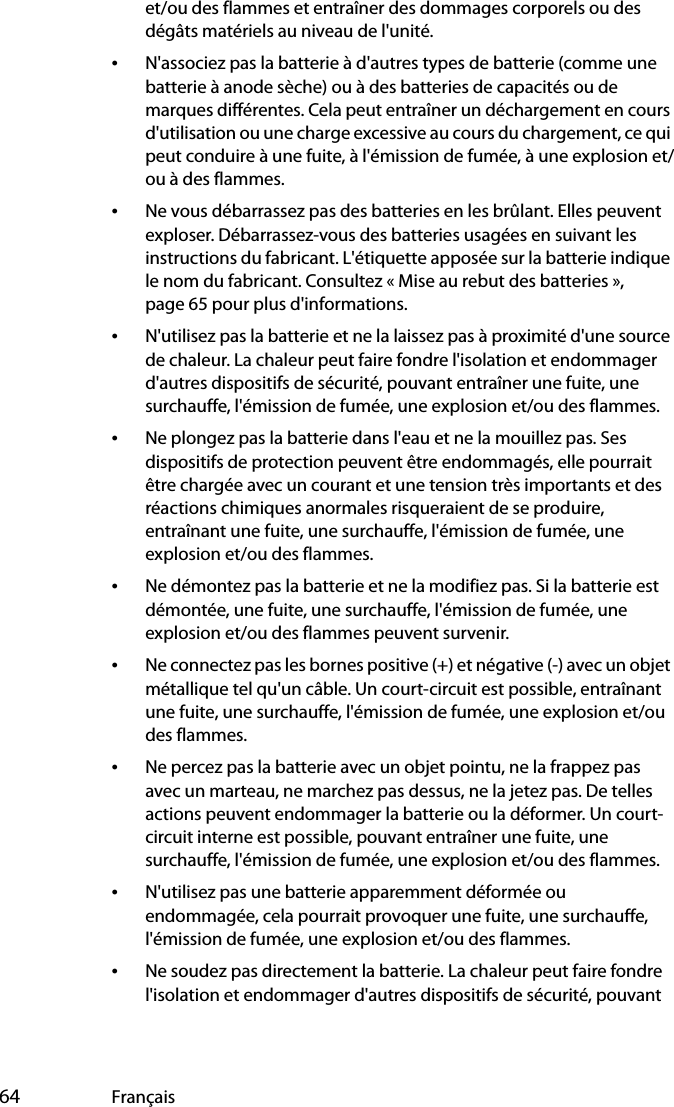
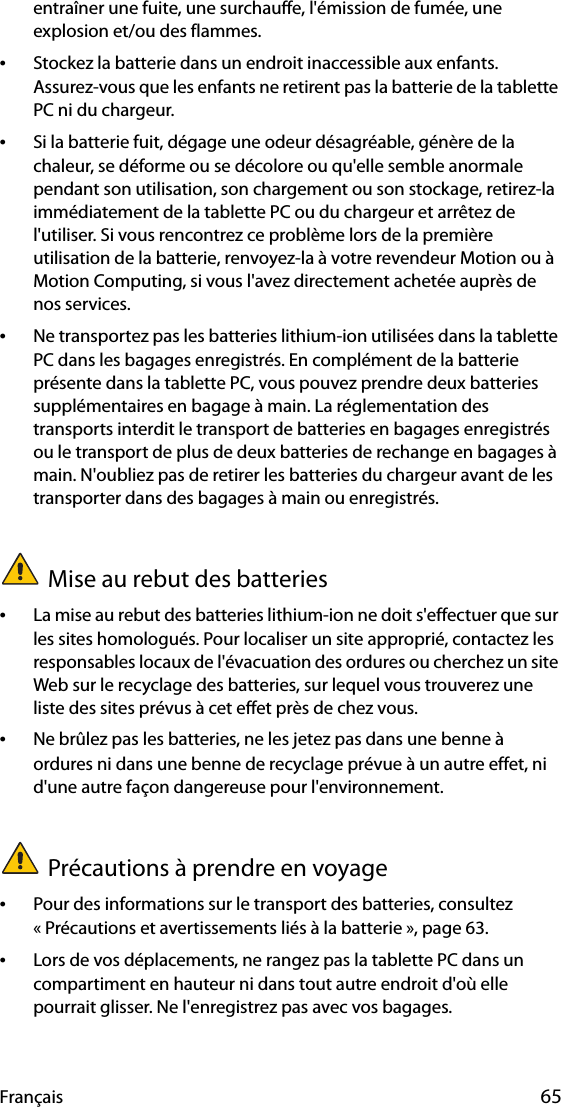
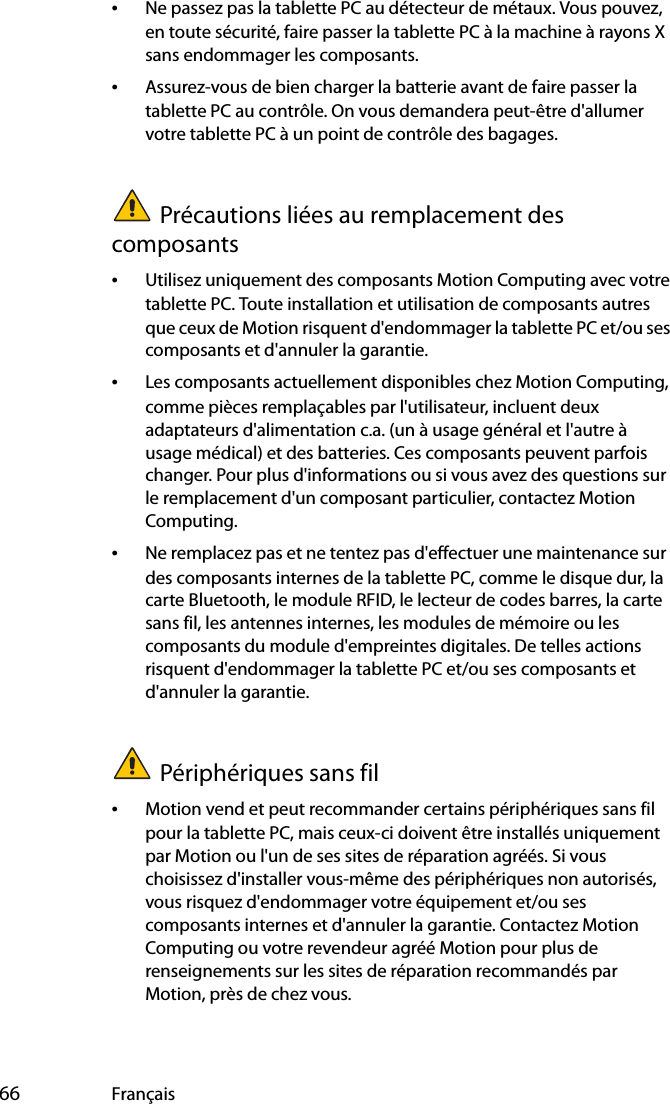
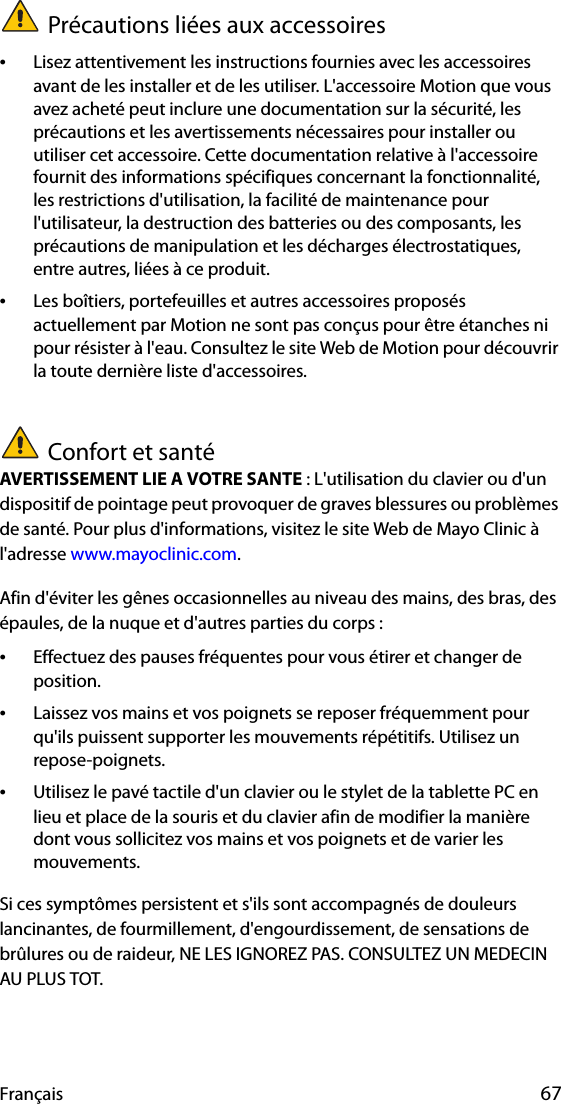
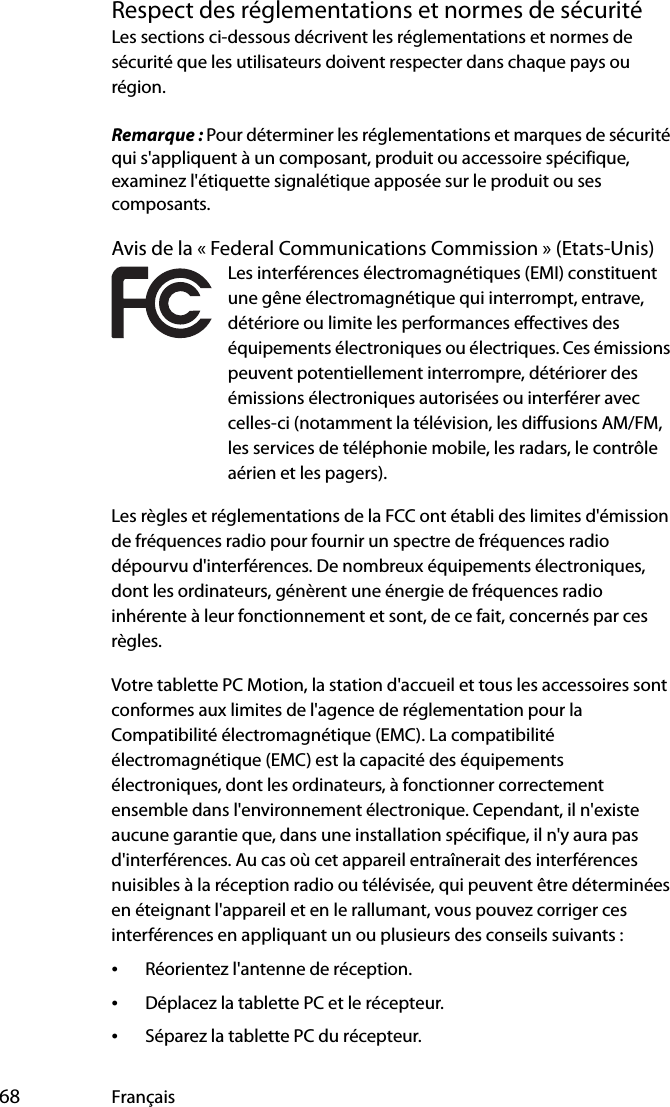
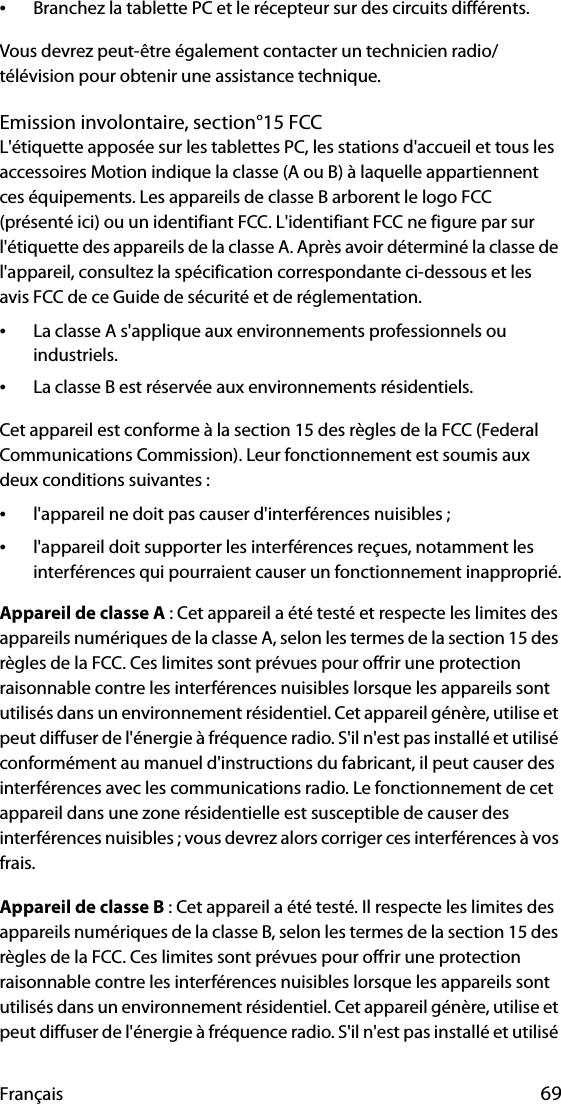
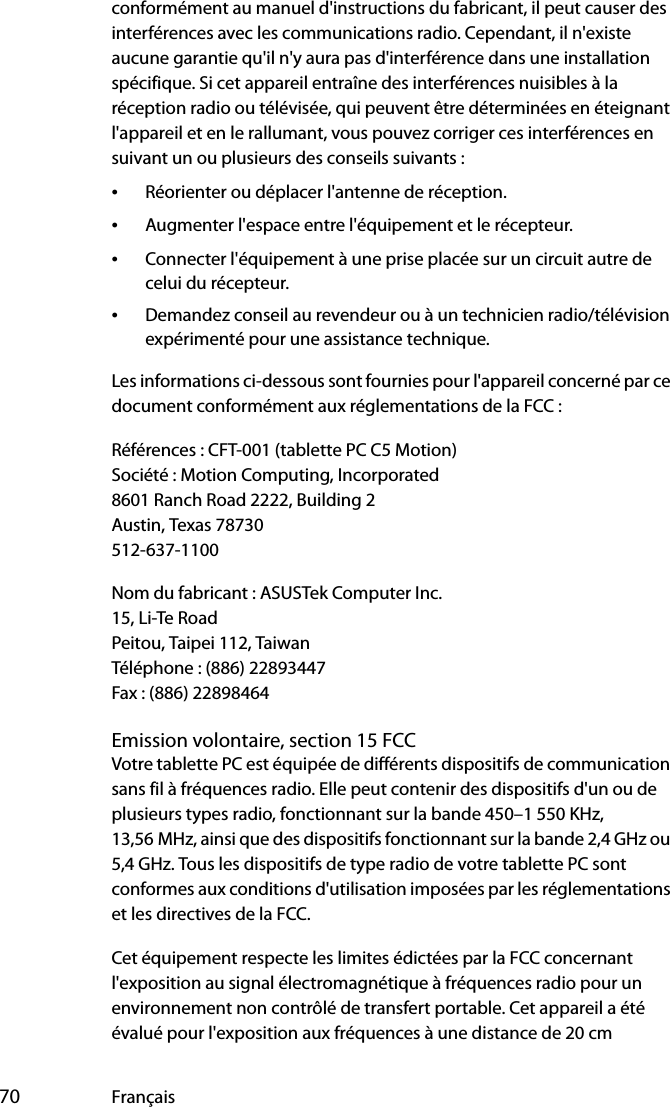
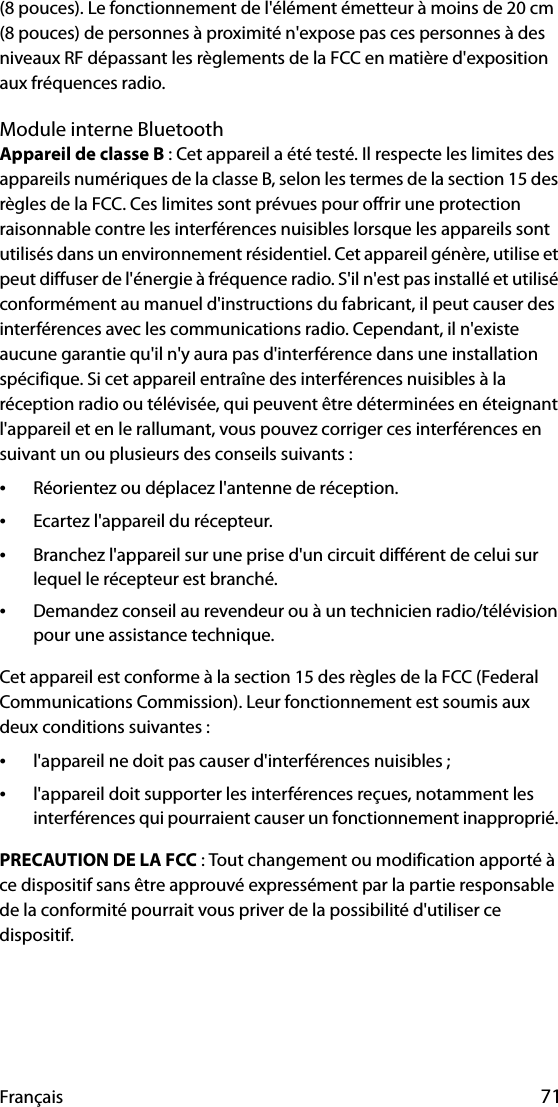
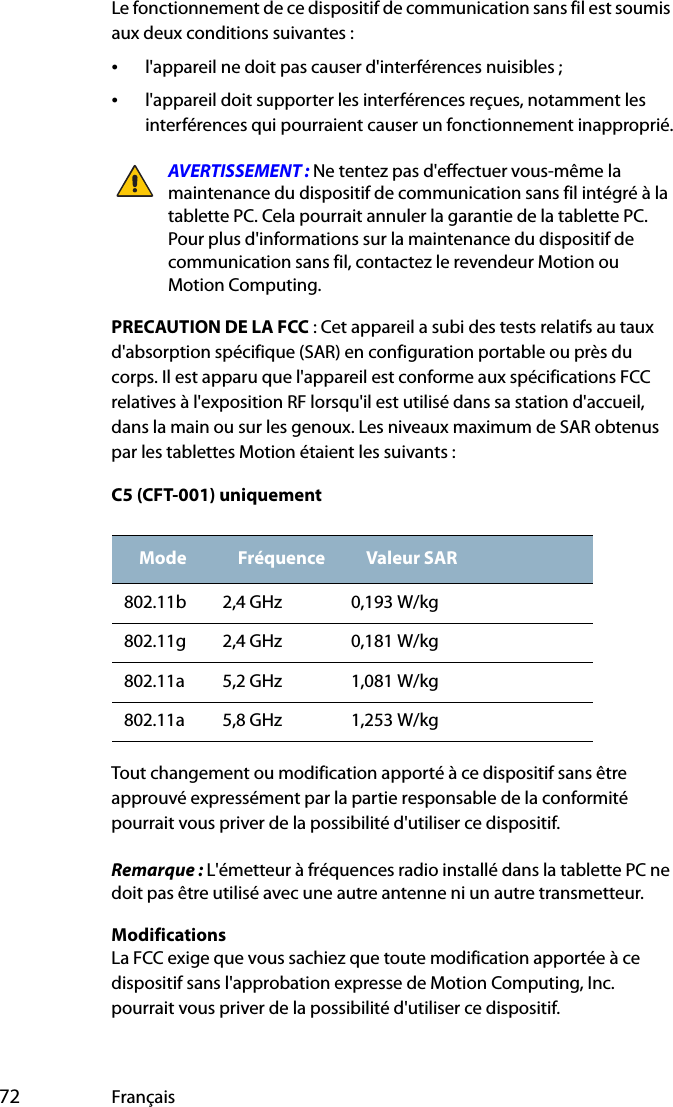
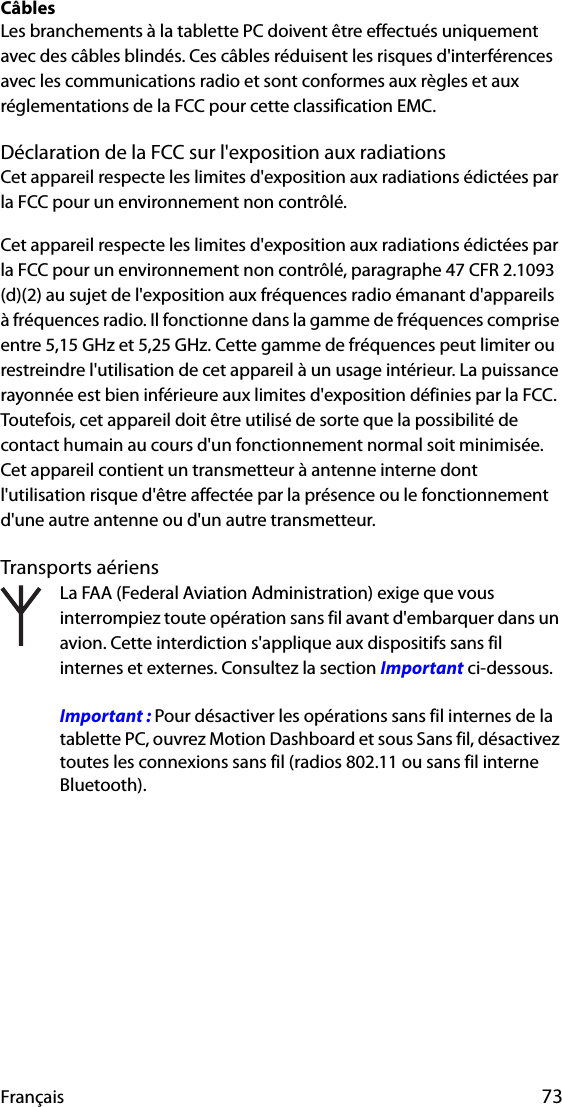
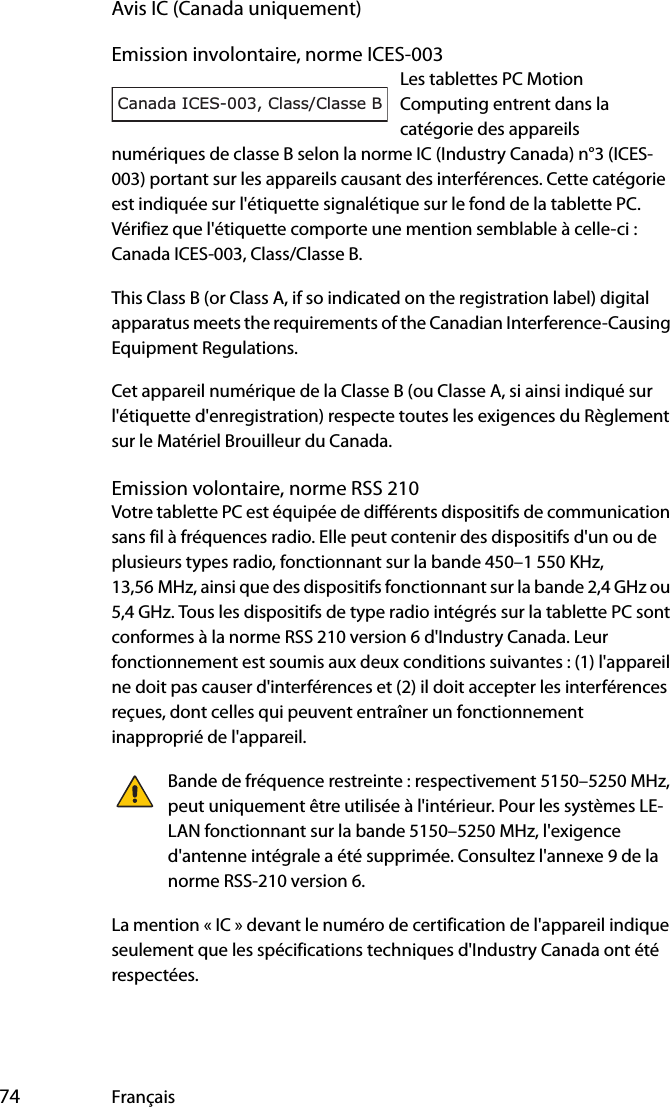
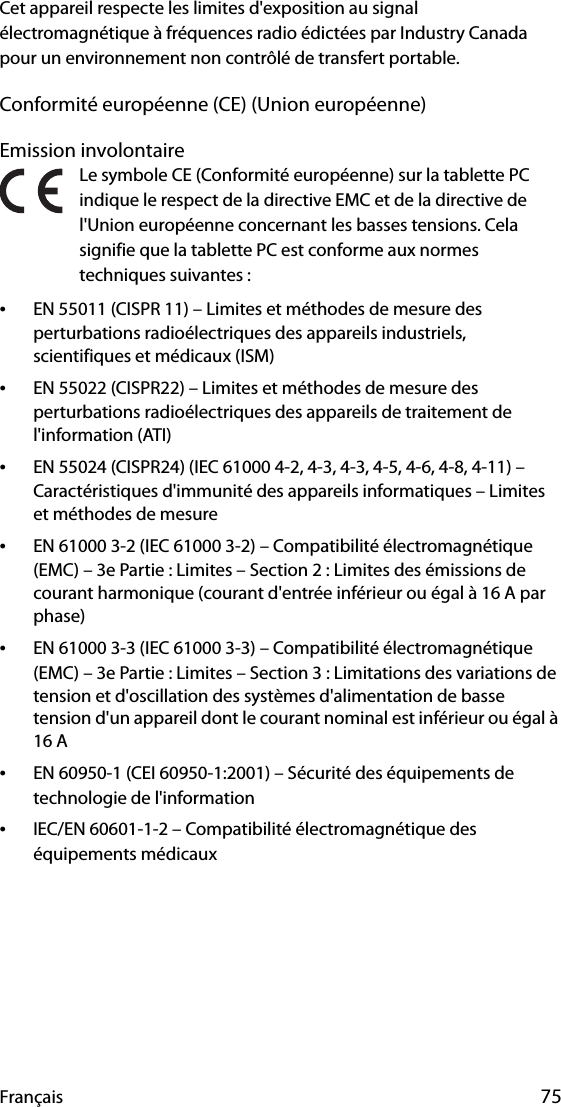
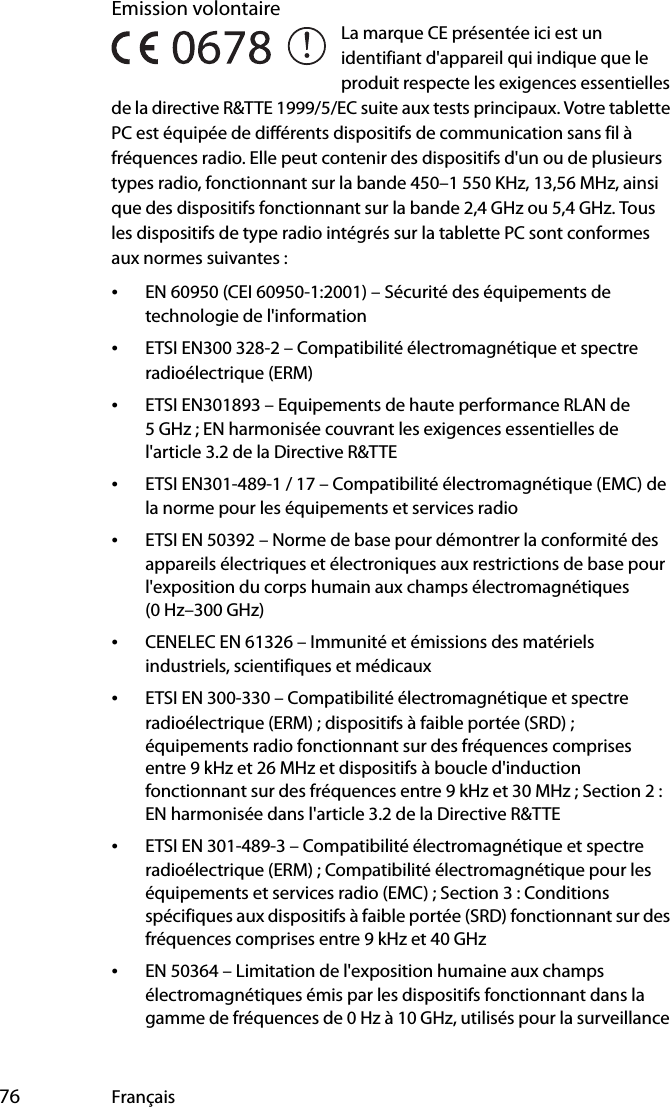
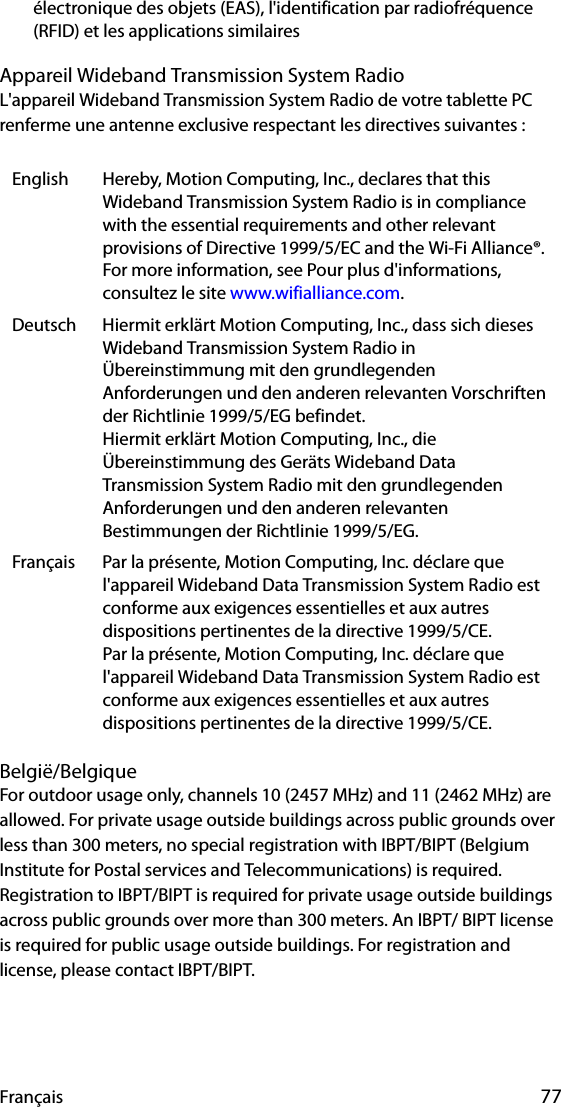
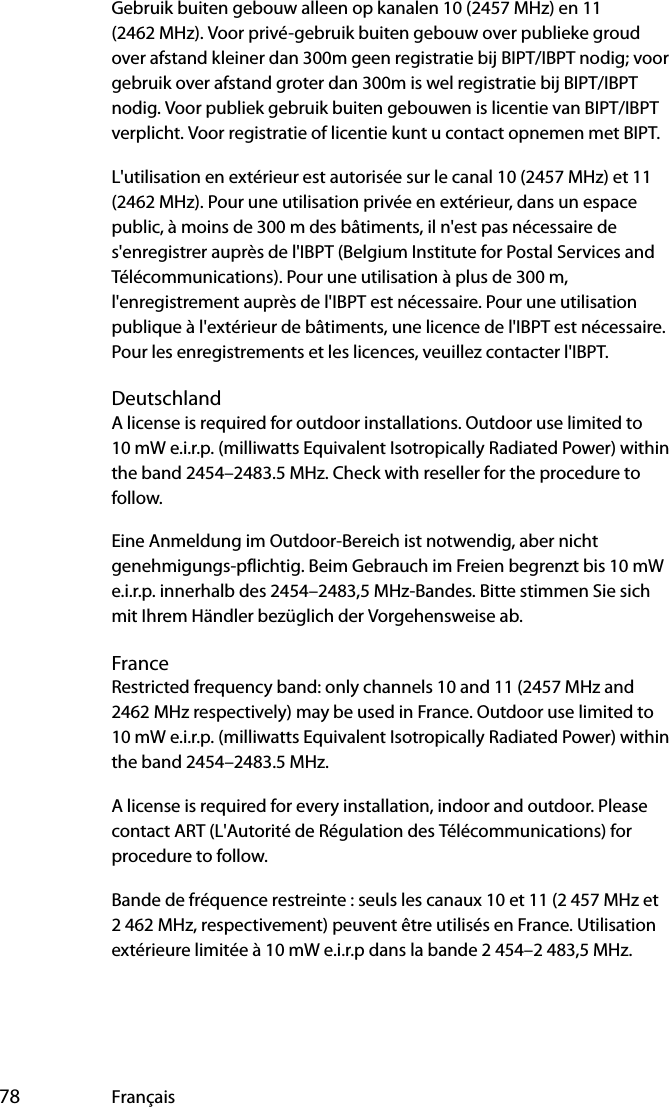
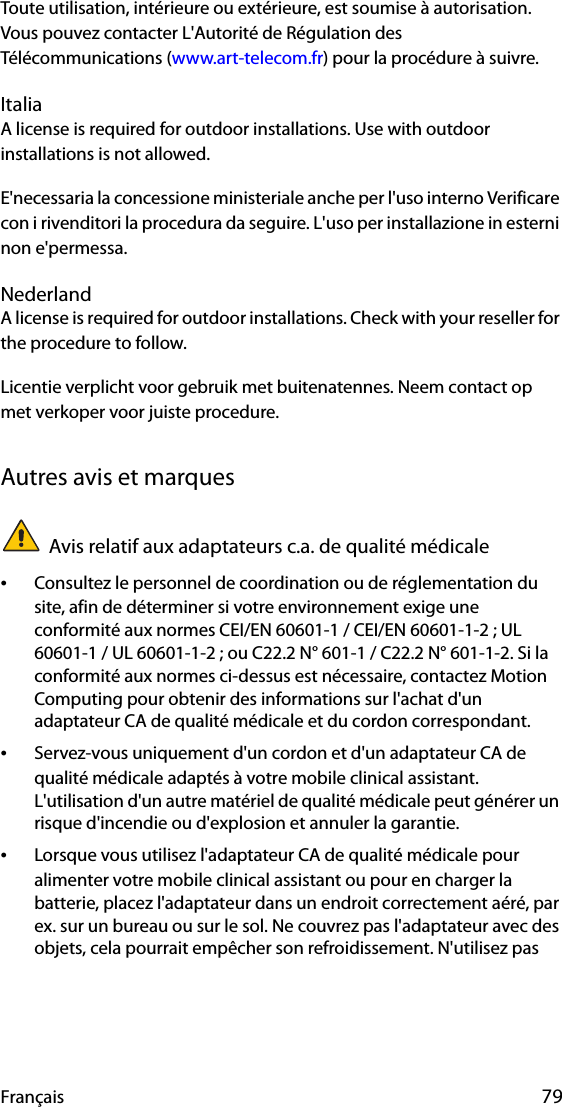
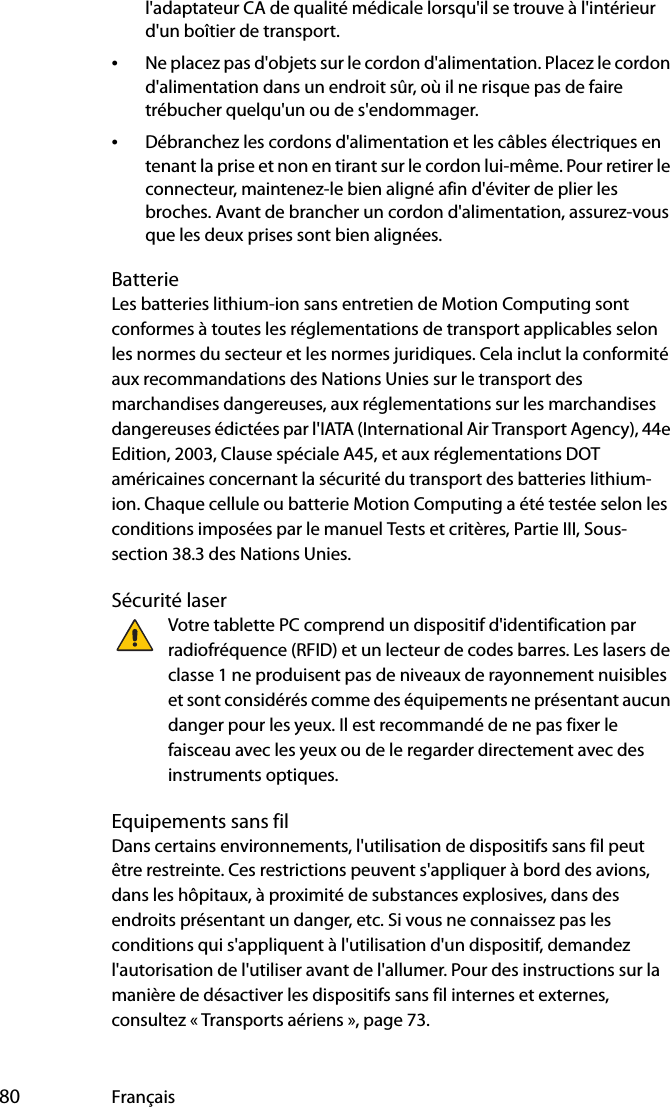
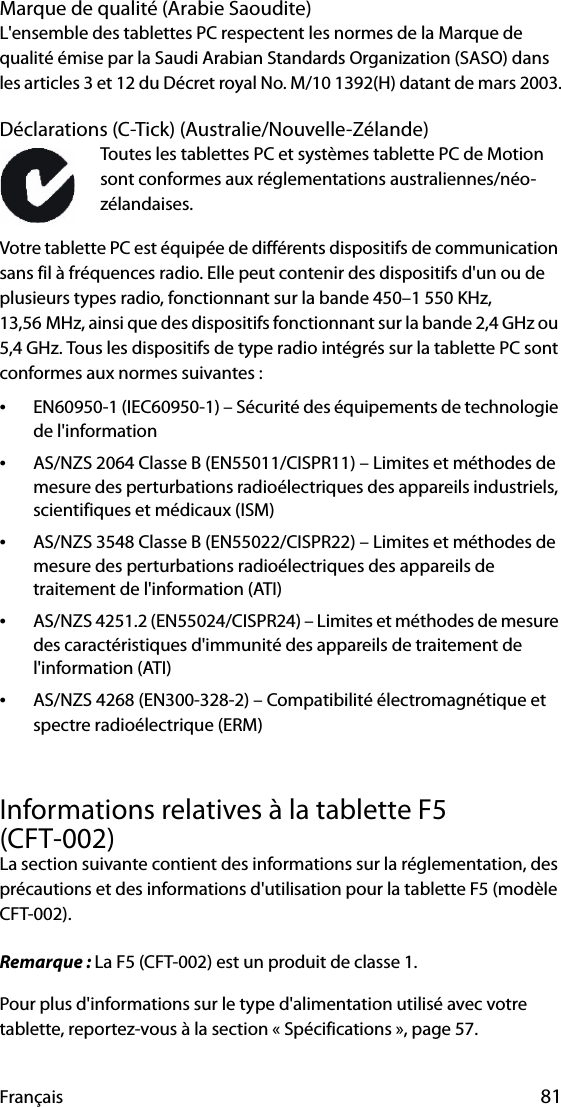
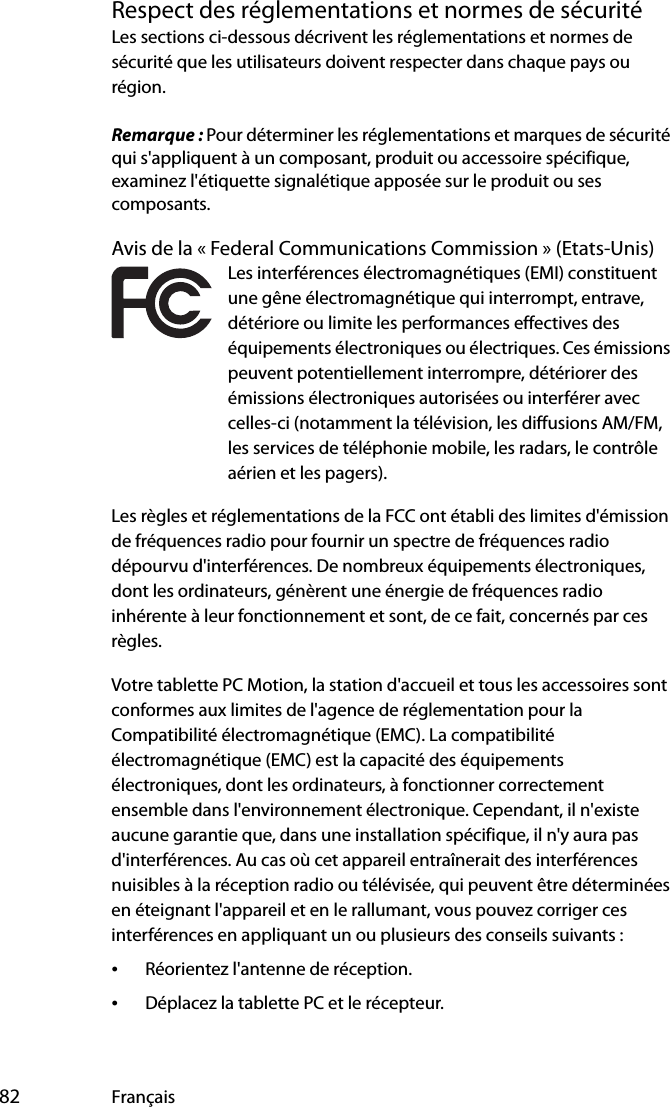
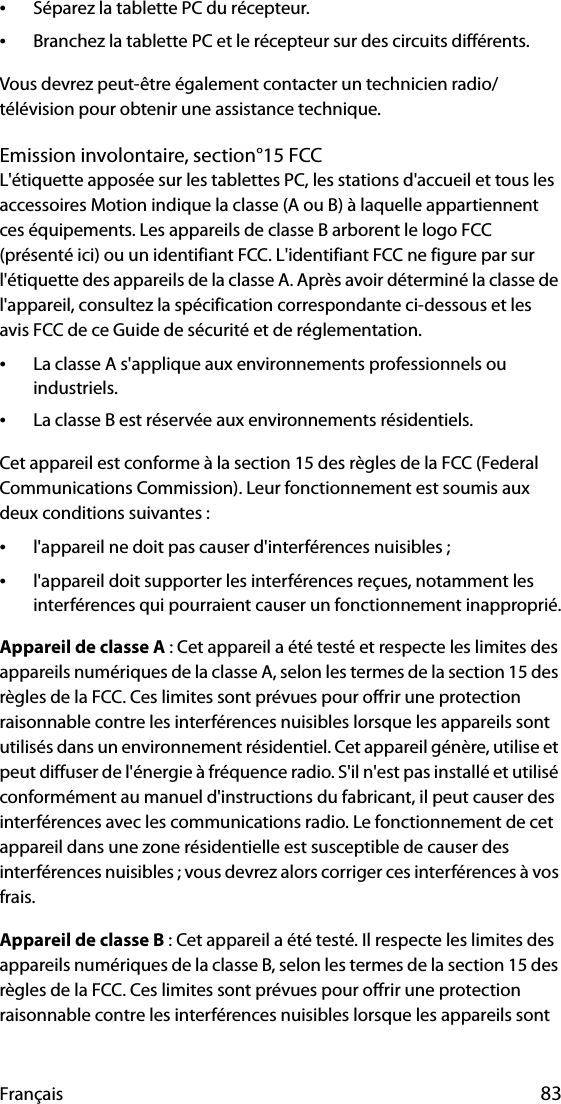
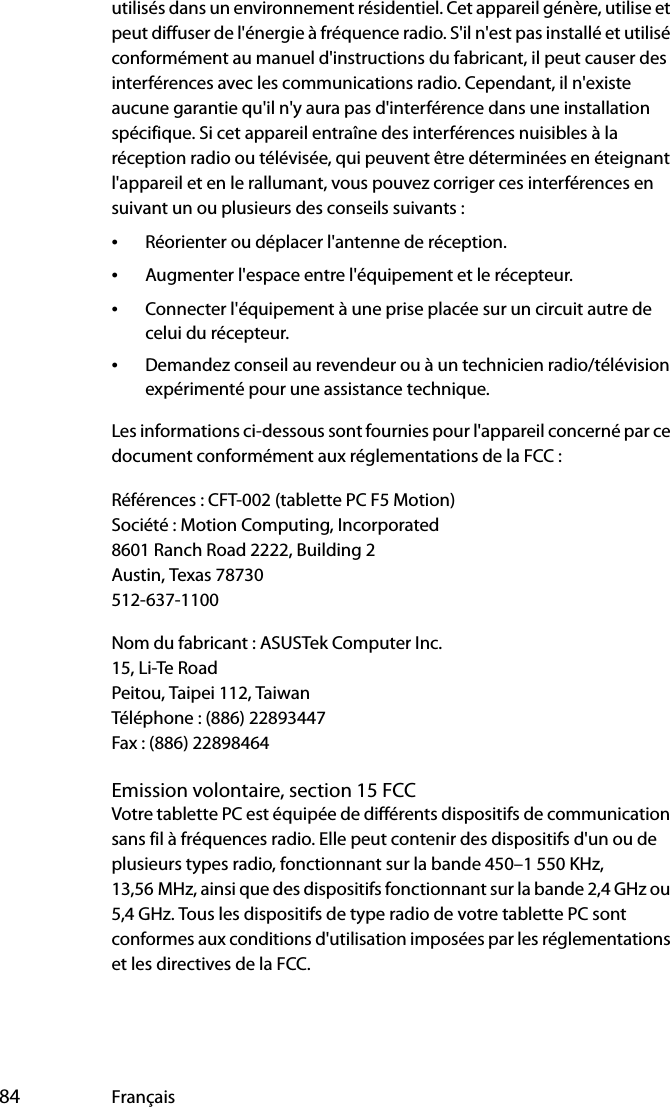
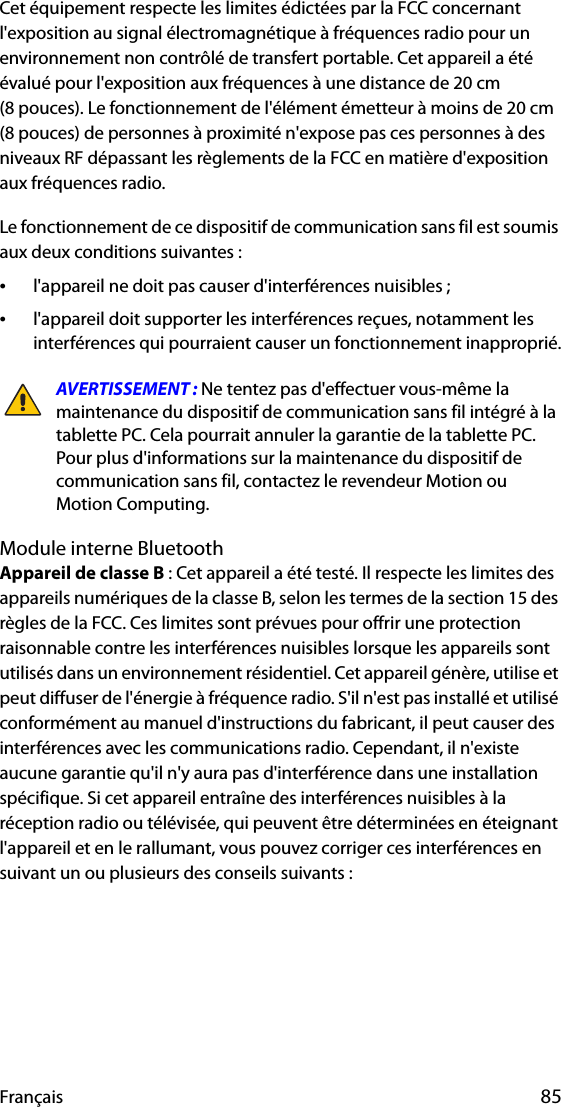
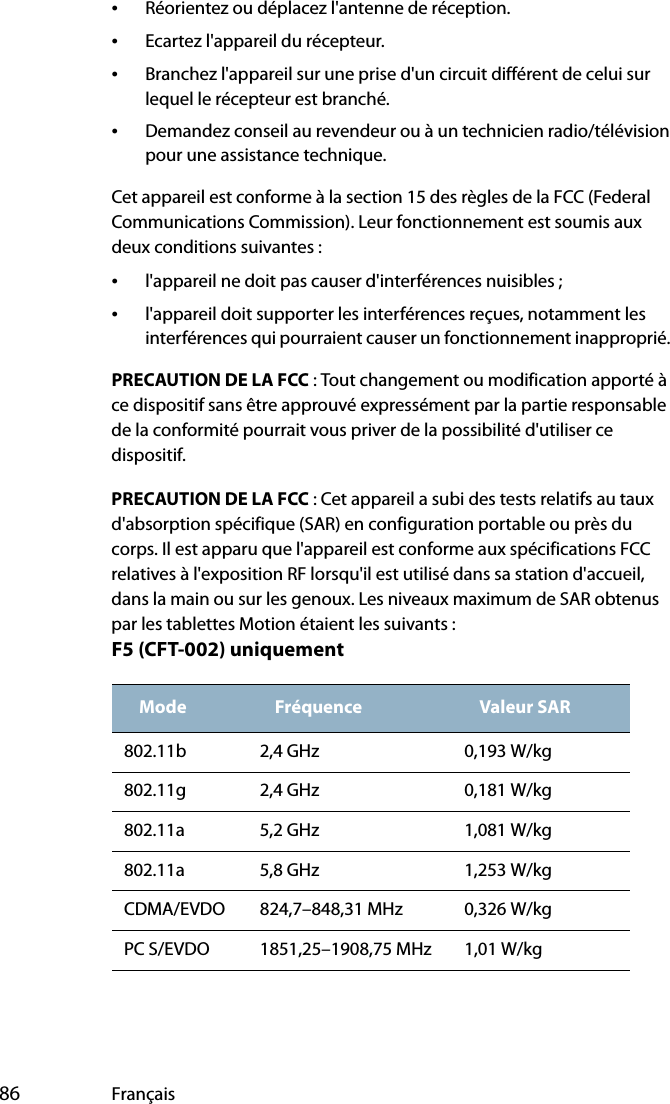
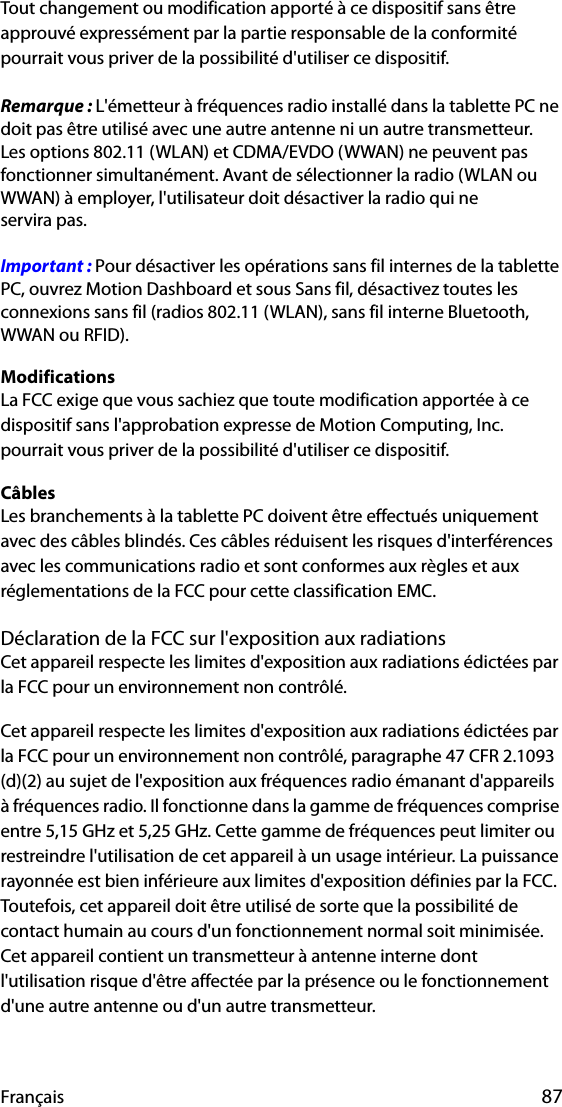
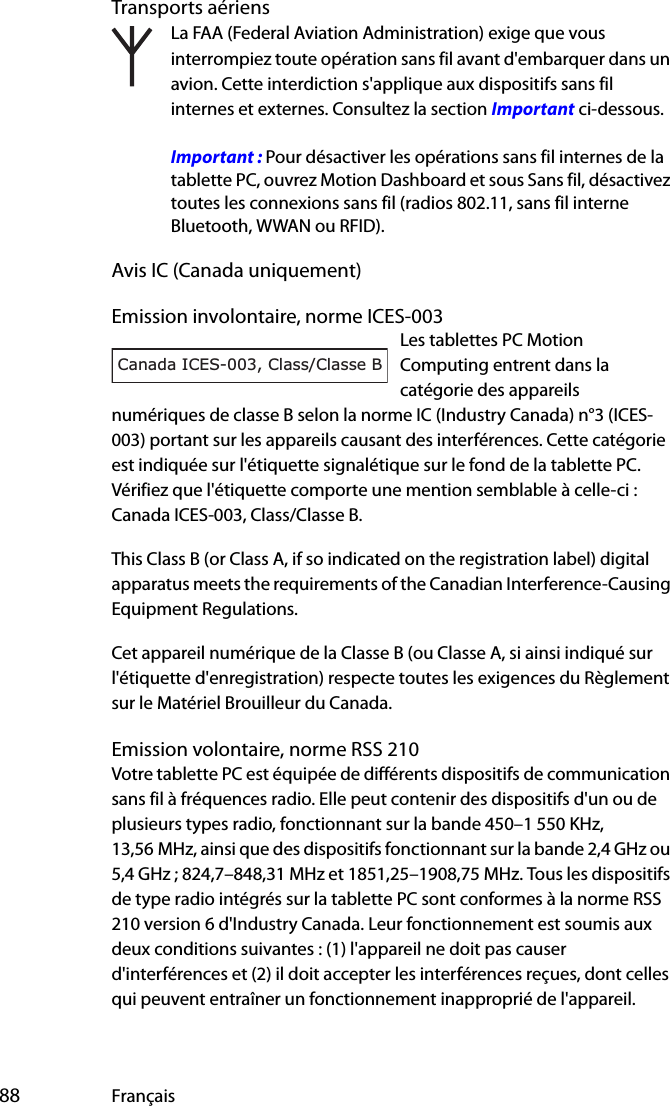
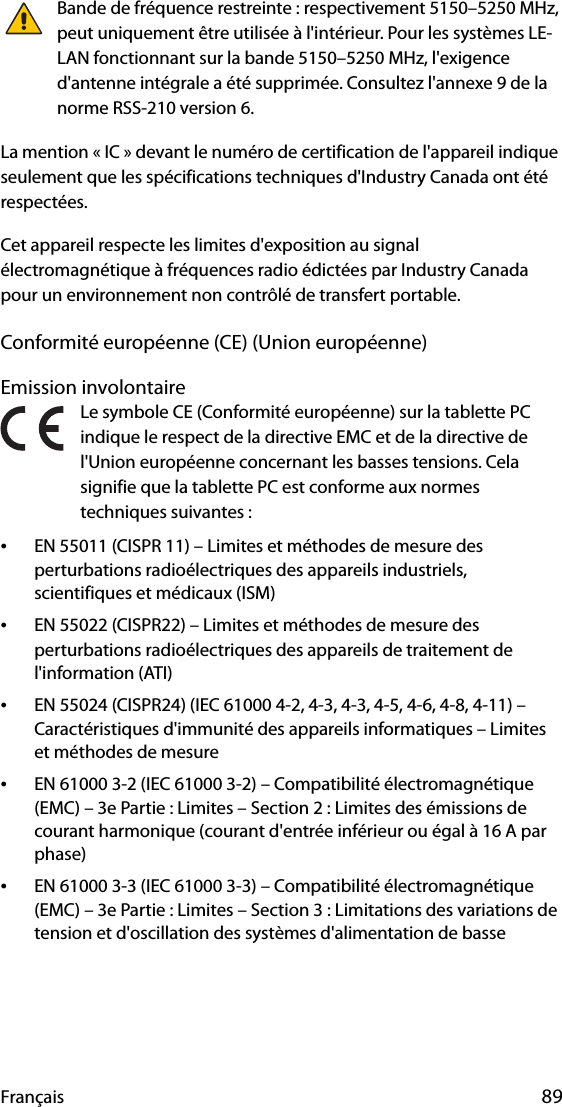
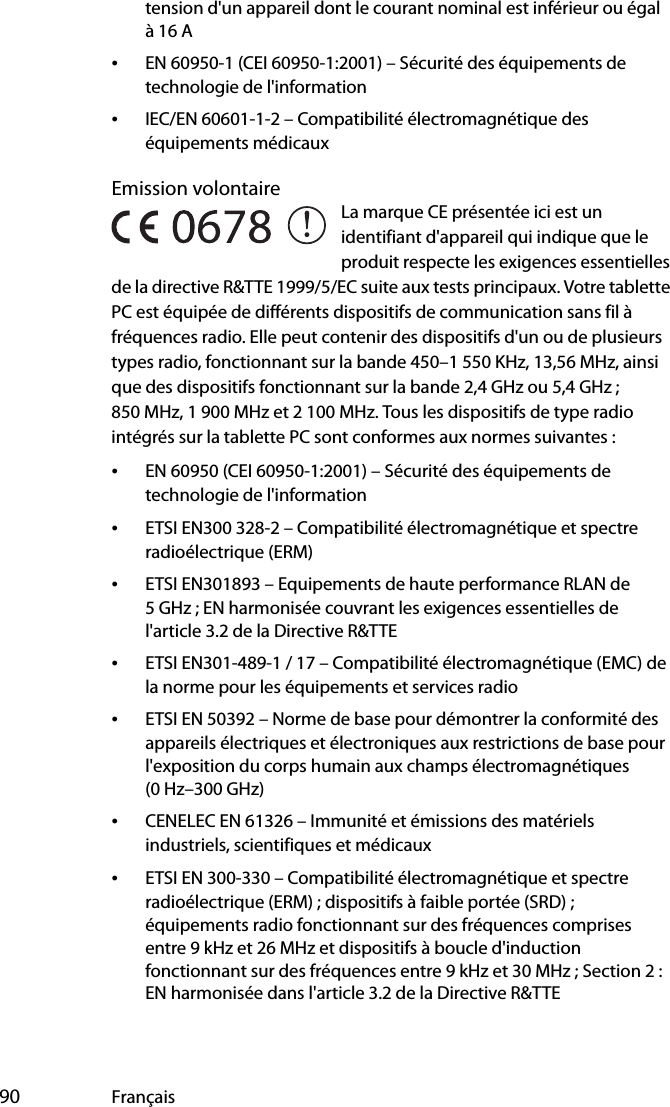
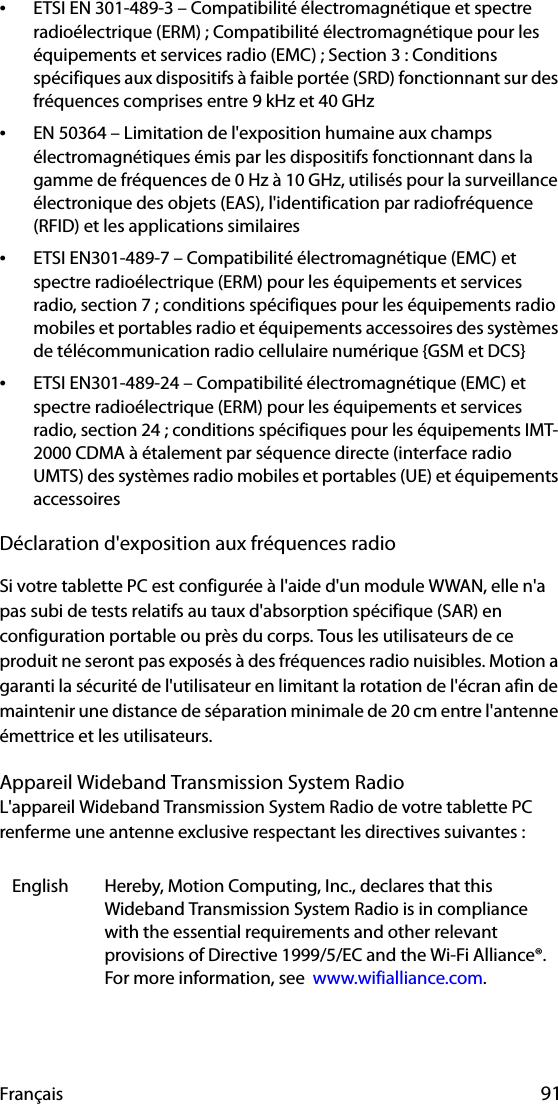
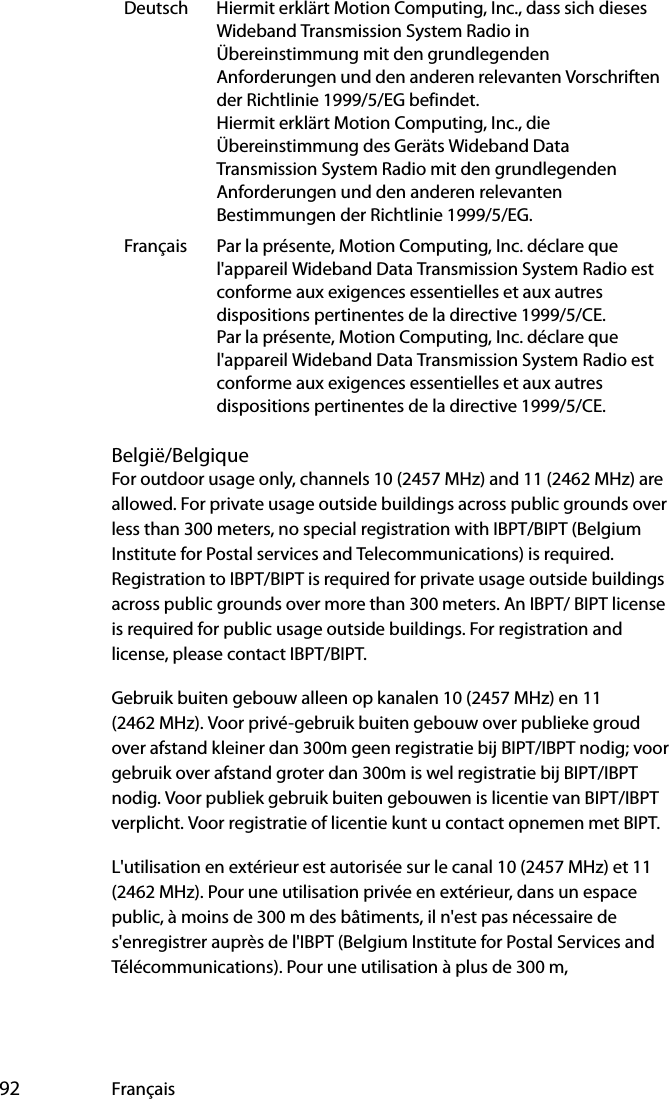
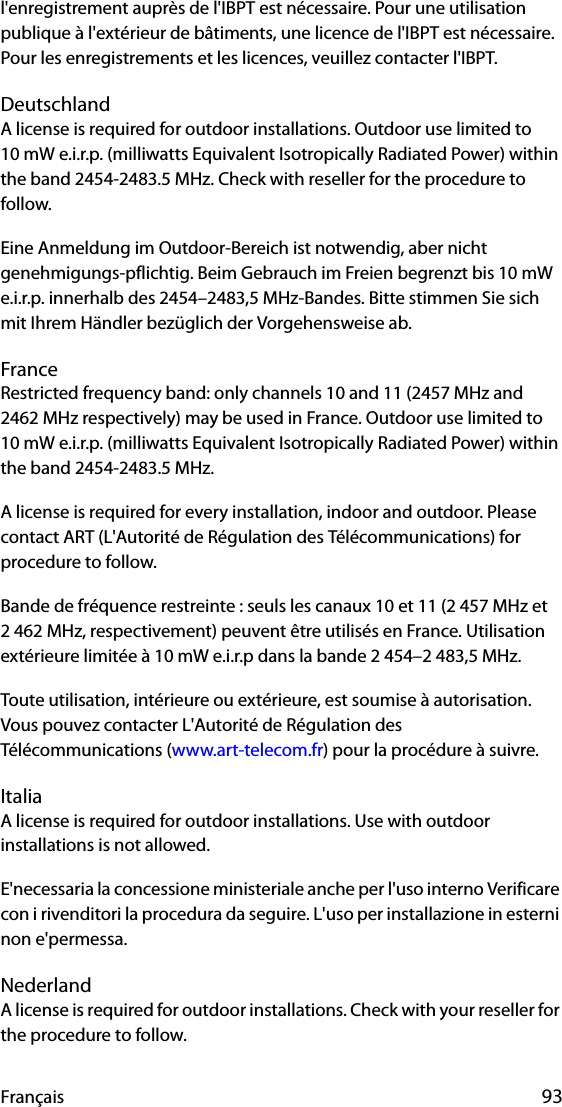
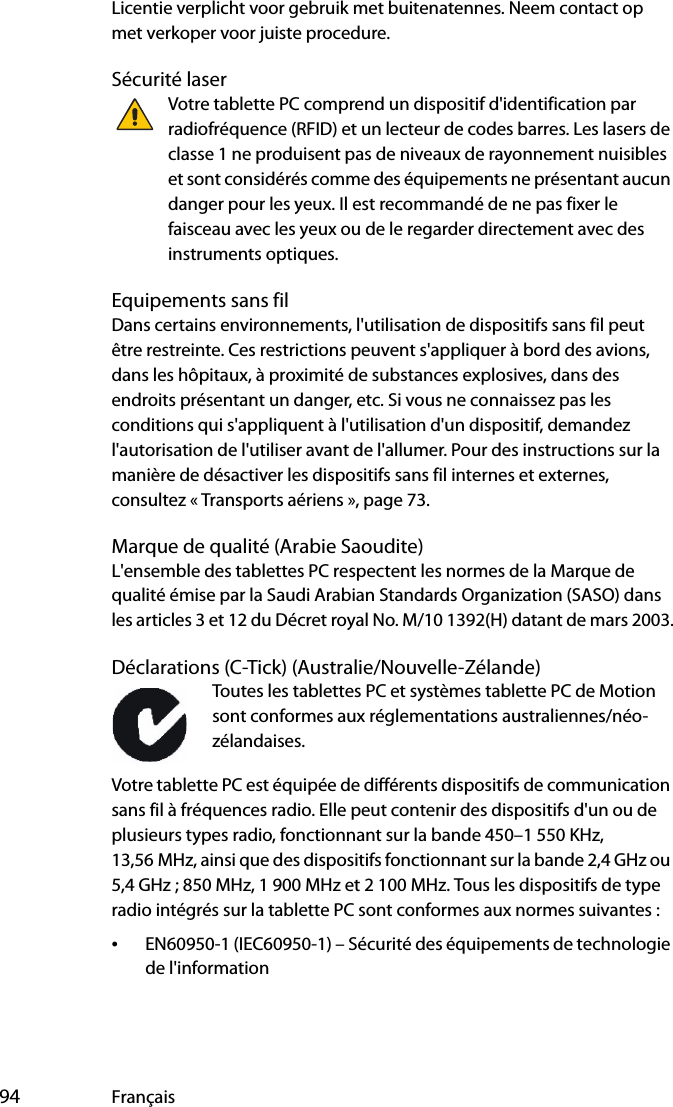
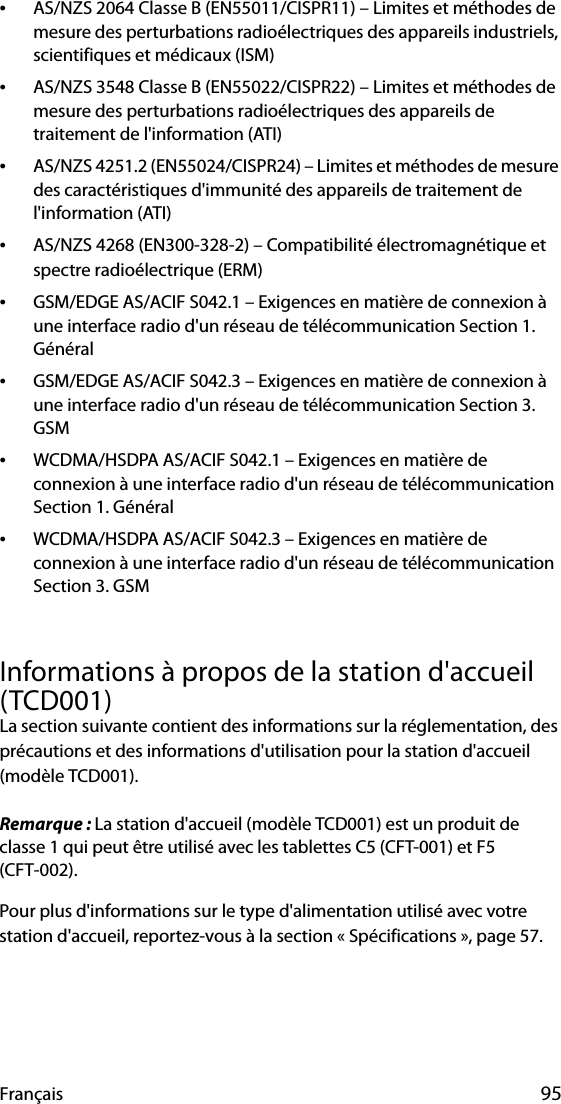
![96 FrançaisPrécautions d'installation•Consultez les instructions d'installation avant de brancher la station d'accueil sur l'alimentation électrique.•Ne laissez pas tomber la station d'accueil ; ne l'exposez pas à d'autres chocs mécaniques.•N'exercez aucune pression excessive sur la station d'accueil et protégez-la des impacts violents. Les pressions excessives et les impacts peuvent endommager les composants de la station d'accueil et entraîner des dysfonctionnements.•Ne placez pas la station d'accueil sur un emplacement instable. Si la station d'accueil est placée sur un emplacement instable, tel qu'une surface irrégulière ou inclinée, elle peut tomber ou se renverser et entraîner des blessures.•Ne placez pas la station d'accueil directement à la lumière du soleil ou à proximité d'un appareil générant de la chaleur. Cela peut endommager le boîtier et les composants et peut provoquer de la chaleur ou un incendie.•N'utilisez pas l'adaptateur c.a. de la tablette PC pour un autre appareil. Cela pourrait générer de la chaleur ou provoquer un incendie. En outre, n'utilisez pas d'autres adaptateurs avec la station d'accueil.Avis d'utilisation de la Clinical (C5 [CFT-001] uniquement)La station d'accueil est destinée à charger la tablette PC et à fournir une connectivité à différents périphériques. La station d'accueil n'est pas conçue pour établir un diagnostic, soigner ou surveiller des patients sous suivi médical. La station d'accueil ne doit pas être en contact physique ou électrique avec le patient, transférer de l'énergie au patient ou détecter un transfert d'énergie de ou vers le patient.Précautions élémentaires de sécurité pour les personnes•Ne tentez pas d'effectuer vous-même la maintenance de la station d'accueil ni de ses composants.](https://usermanual.wiki/Xplore-Technologies-of-America/HWMSMC5725.Users-Manual-Safety-Info/User-Guide-1079955-Page-96.png)
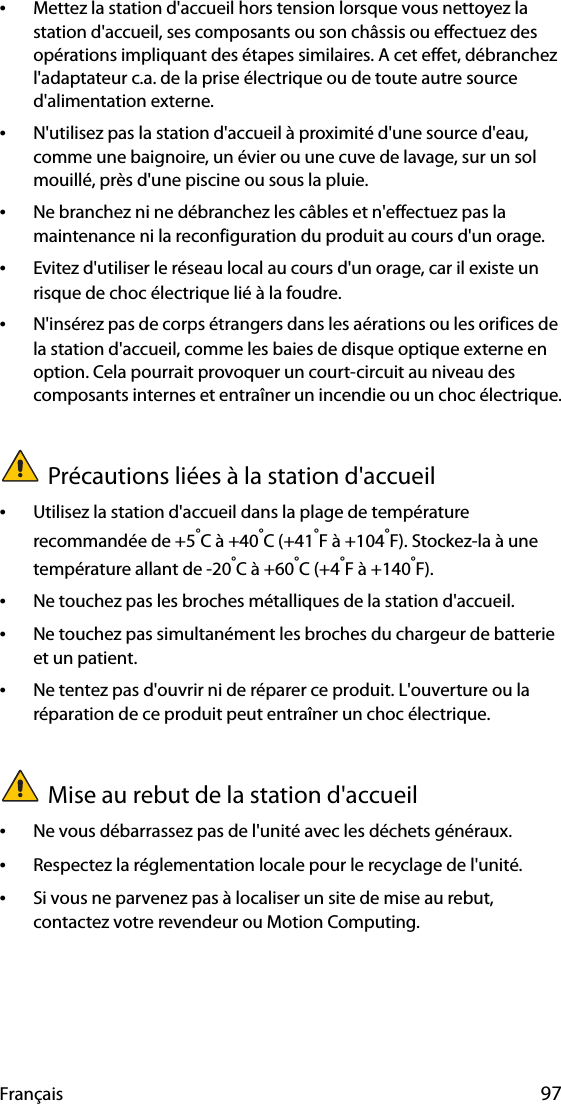
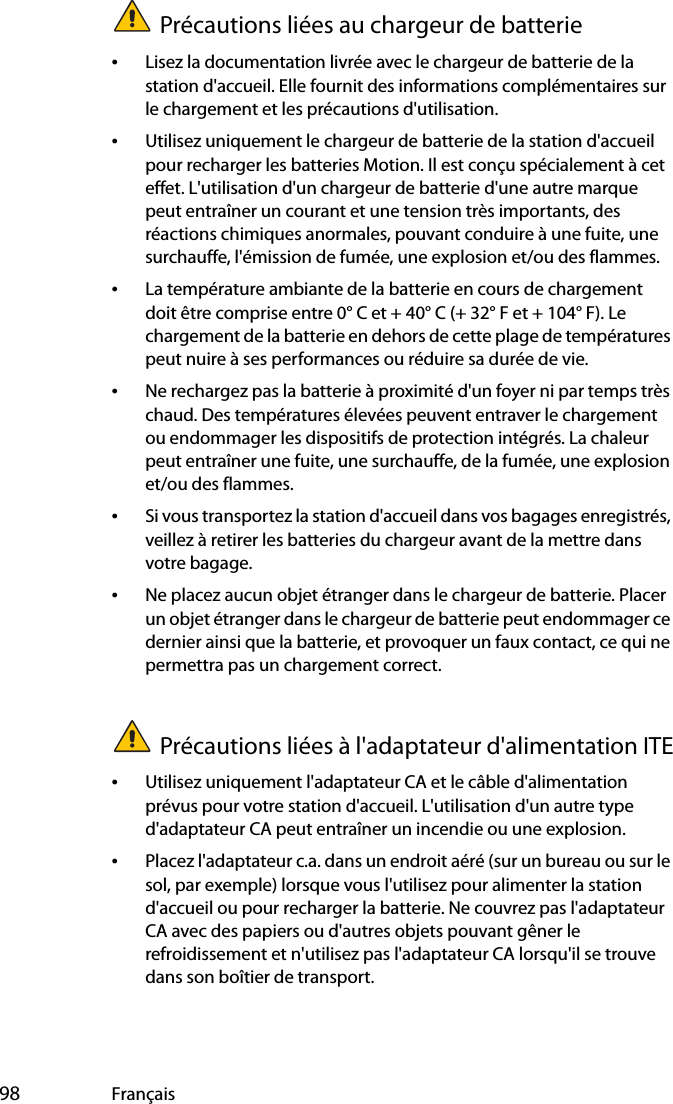
![Français 99•Assurez-vous qu'aucun objet ne soit posé sur le câble d'alimentation de l'adaptateur CA et que celui-ci ne puisse pas être coincé ni piétiné.•Débranchez les câbles d'alimentation et les câbles électriques en retirant le connecteur et non en tirant sur le câble. Pour retirer le connecteur, maintenez-le bien aligné afin d'éviter de plier les broches. Avant de brancher un câble, assurez-vous que les deux connecteurs sont bien alignés.Pour plus d'informations sur l'adaptateur d'alimentation médical, consultez la section « Précautions liées à l'adaptateur d'alimentation médical (C5 [CFT-001] uniquement) ».Précautions liées à l'adaptateur d'alimentation médical (C5 [CFT-001] uniquement)Les équipements supplémentaires connectés à l'équipement électrique médical doivent respectivement être conformes aux normes IEC ou ISO (p.ex. IEC 60950 pour l'équipement de traitement de données). De plus, toutes les configurations doivent respecter les exigences pour les systèmes électriques médicaux (consultez IEC 60601-1 ou la clause 16 de 3Ed. de IEC 60601-1, respectivement). Toute personne connectant un équipement supplémentaire à l'équipement électrique médical configure un système médical et est par conséquent responsable de la compatibilité du système avec les exigences pour les systèmes électriques médicaux. Nous attirons l'attention sur le fait que les réglementations locales priment sur les exigences mentionnées ci-dessus. En cas de doute, consultez votre représentant local ou le service d'entretien technique.Références des normes / directives :•IEC 60601-1+A1+A2 : 1995: 6.8.2.c, 19.2.b, 19.2.c•IEC 60601-1 : 2006: 7.9.2.5•MDD 93/42/EEC : Annexe 1 clause 13.6.c•UL 60601-1, 1re édition•CAN/CSA C22.2 No. 601-1, 1re édition](https://usermanual.wiki/Xplore-Technologies-of-America/HWMSMC5725.Users-Manual-Safety-Info/User-Guide-1079955-Page-99.png)
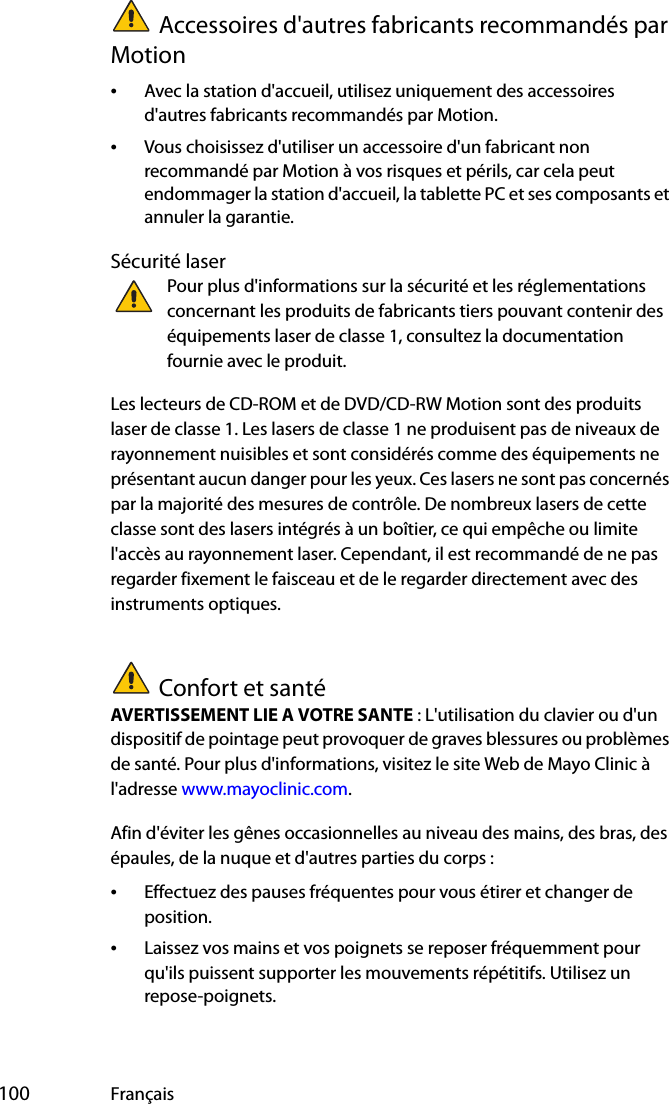
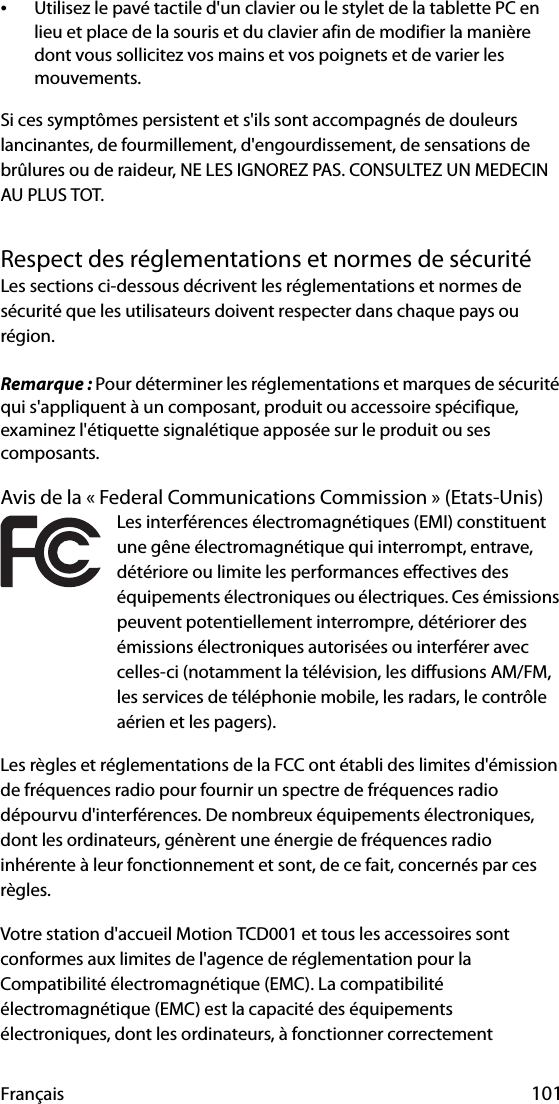
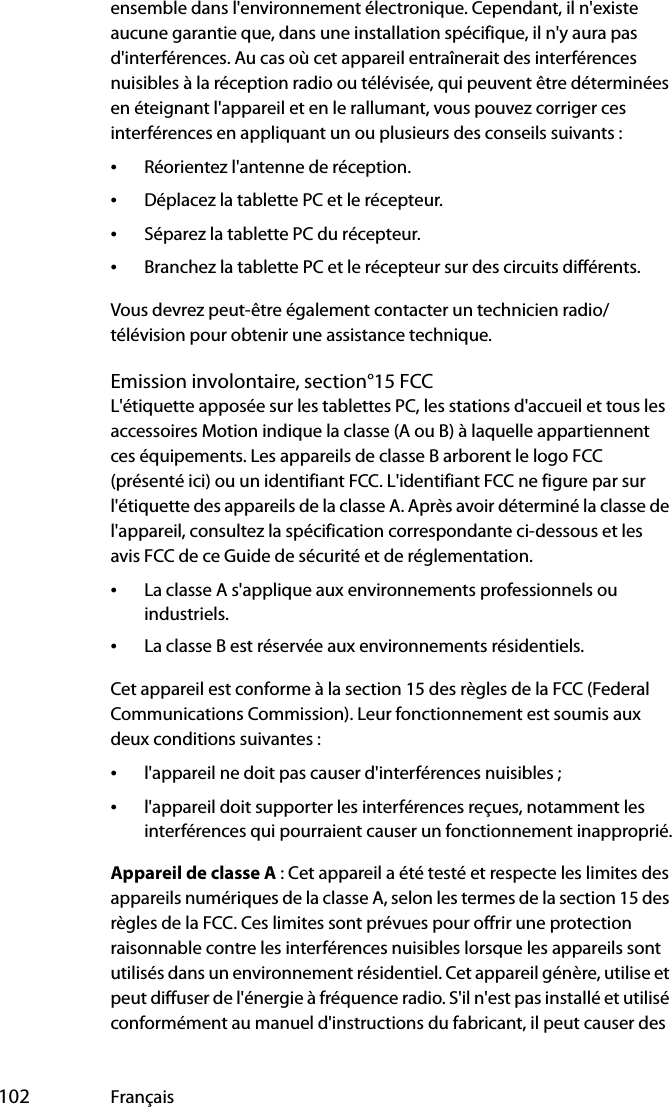
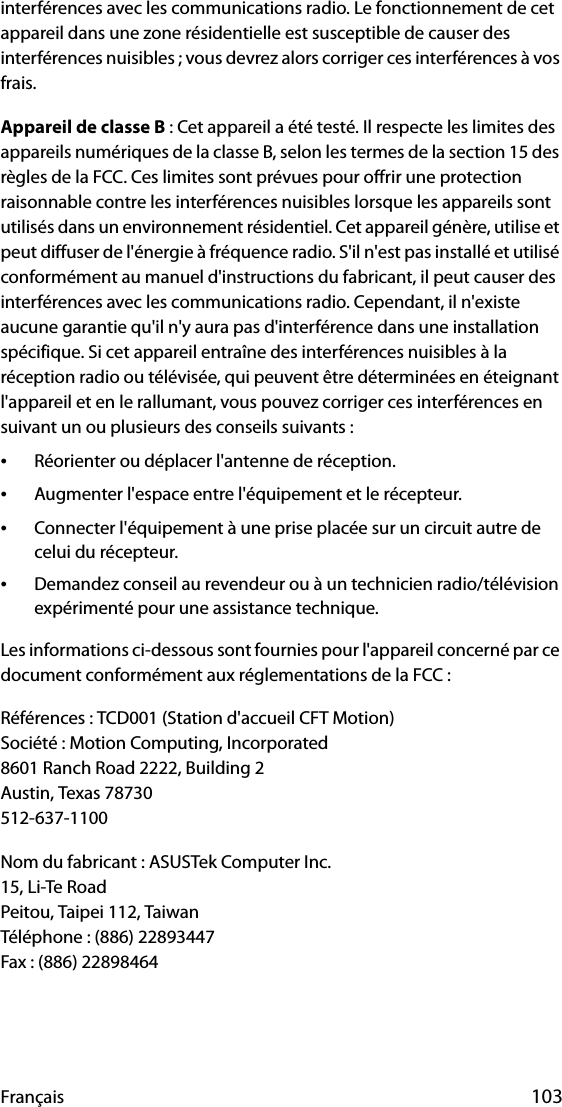
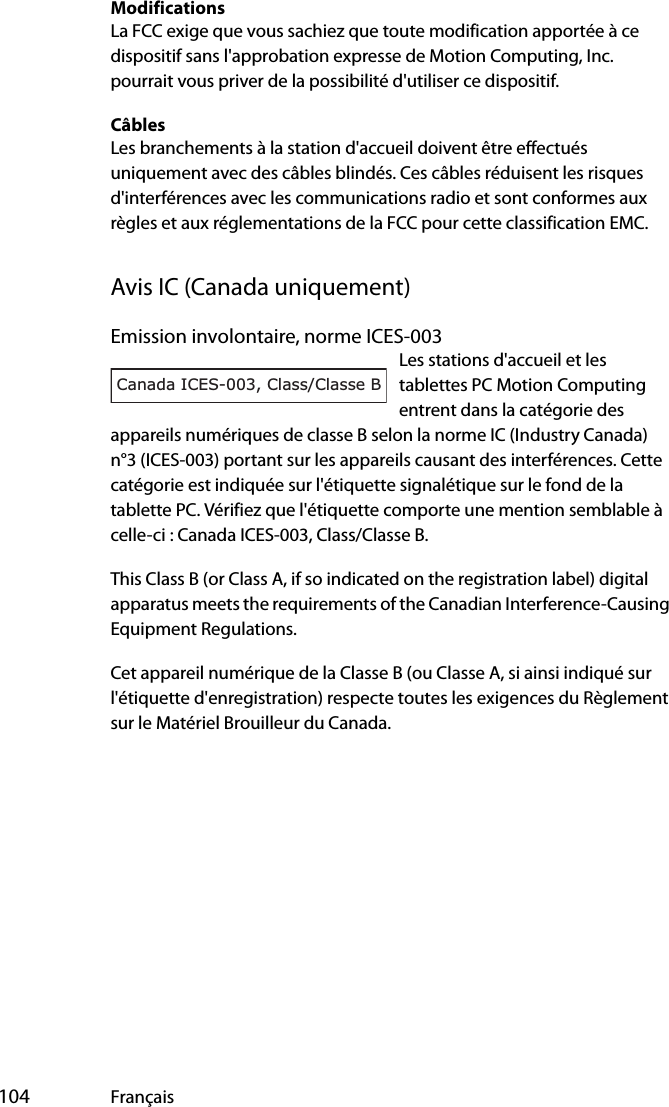
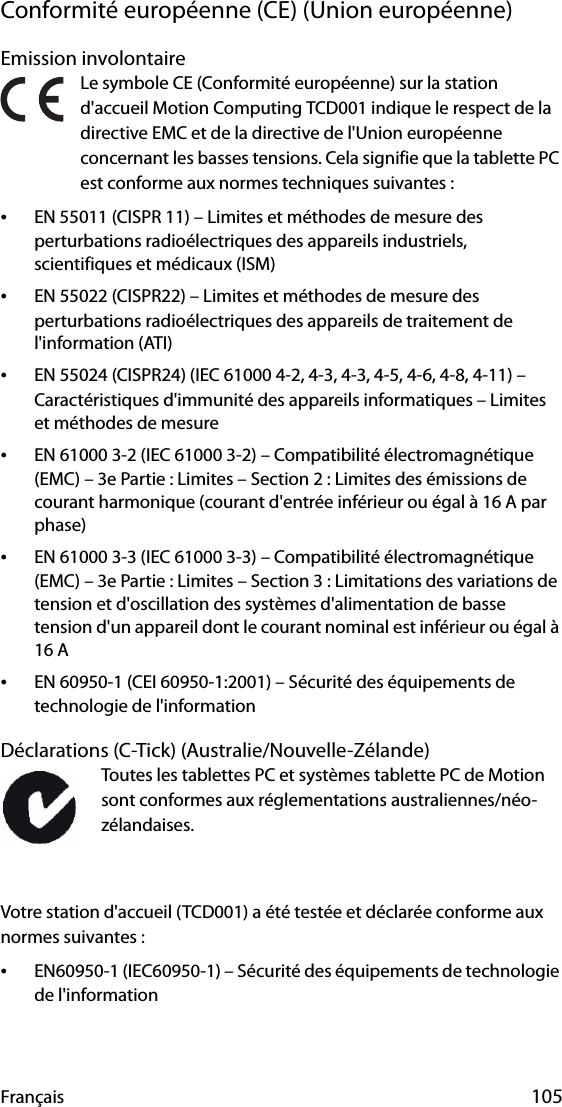
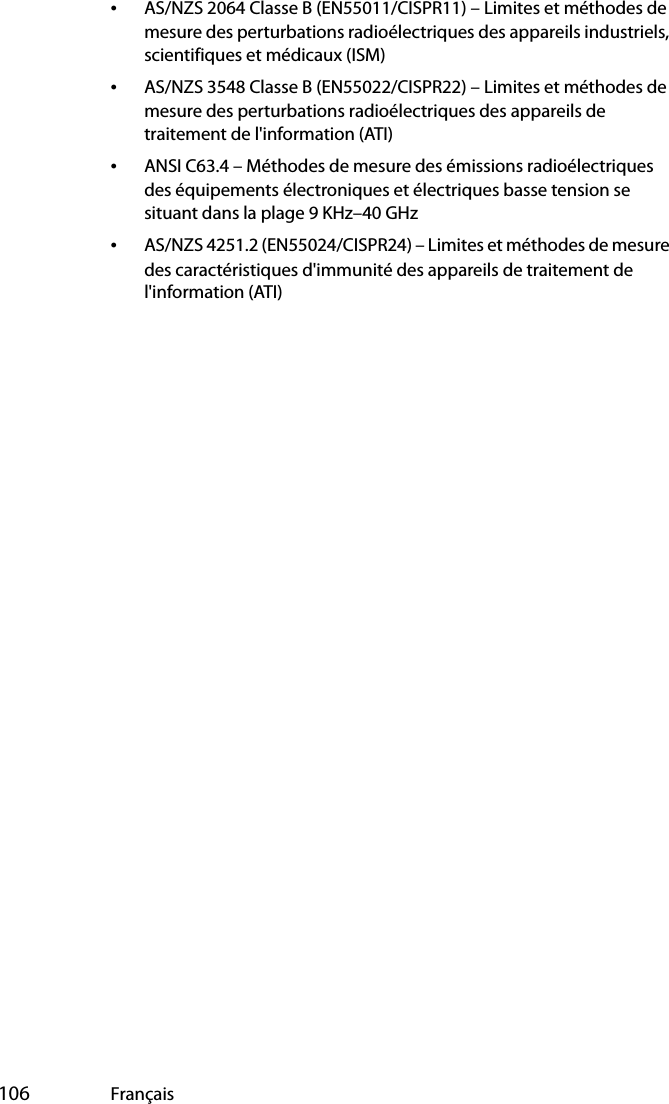
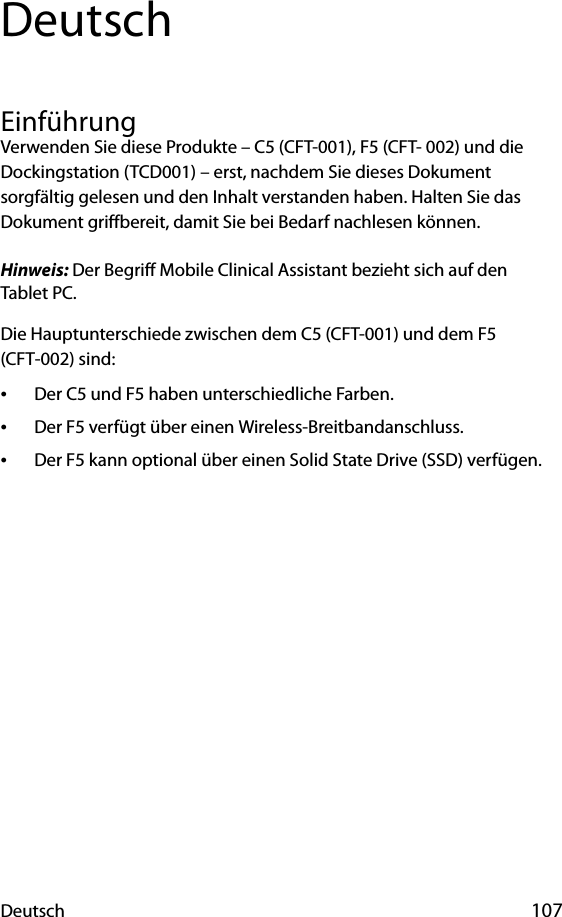
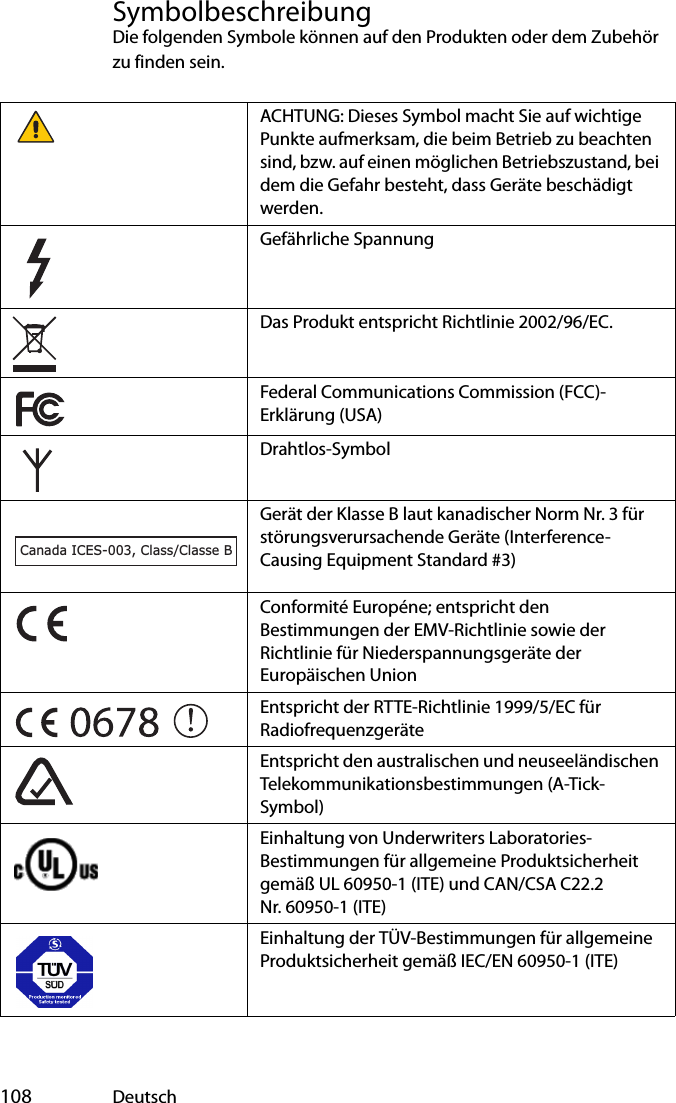
![Deutsch 109SpezifikationenProduktsicherheitshinweiseMotion Tablet PCs und Zubehör sind so konstruiert, um Ihre Sicherheit zu optimieren, Belastungen zu mindern und den Anforderungen der Tragbarkeit zu widerstehen. Um Verletzungen oder Beschädigungen am Gerät zu vermeiden, sollten Sie die folgenden Sicherheitsvorkehrungen befolgen.Haftungsausschluss bei Montage und Installation des ProduktsMotion Computing übernimmt unter keinem Haftungskonzept (einschließlich und ohne Einschränkung vertraglich, durch unerlaubte Handlung oder gesetzlich festgelegt) die Haftung für jeglichen Verlust, Beschädigung, Personenschäden oder anderen Schaden jeglicher anderer Natur (einschließlich und ohne Einschränkung direkter, spezieller, zufälliger oder Folgeschäden), der direkt oder indirekt durch unsachgemäße Lagerung, Installation oder Benutzung der Produkte von Motion Computing oder sämtlicher anderer Anwendungen auftritt. Um Produkte von Motion sicher zu installieren und zu nutzen, muss vollste Rücksicht genommen werden auf Insassen, Systeme (z. B. auf die Lage von Treibstoffleitungen, Navigationssystemen, Bremsleitungen, elektrische, Antriebs- und andere Systeme), Airbags und andere Sicherungs- ,Warnungs- oder Schutzeinrichtungen. Ohne Einschränkung des Vorgenannten schließt Motion jegliche Verantwortung für die Temperatur Ein Aus (Lagerung/Transport)Temperatur 5–40 °C -20–60 °CLuftfeuchtigkeit 20–80 % RH 10–90 % RHLuftdruck 697–1060 hPa 187–1060 hPaNetzteil (ITE) Delta Electronics, ADP-50HH Rev. BEingabe: 1,5 A, 100–240 V Wechselstrom, 50–60 Hz. Ausgabe 19 V Gleichstrom, 2,64 A. Netzadapter gemäß UL 60950-1, CAN/CSA C22.2 Nr. 60950-1,IEC/EN 60950-1 NetzteilSinpro M/N: MPU50-107(nur für C5 [CFT-001])Eingabe: 1,35 A, 100–240 V Wechselstrom, 47–63 Hz. Ausgabe 19 V Gleichstrom, 2,63 A. Netzadapter gemäß UL60601-1, CAN/CSA C22.2 Nr. 601-1,](https://usermanual.wiki/Xplore-Technologies-of-America/HWMSMC5725.Users-Manual-Safety-Info/User-Guide-1079955-Page-109.png)
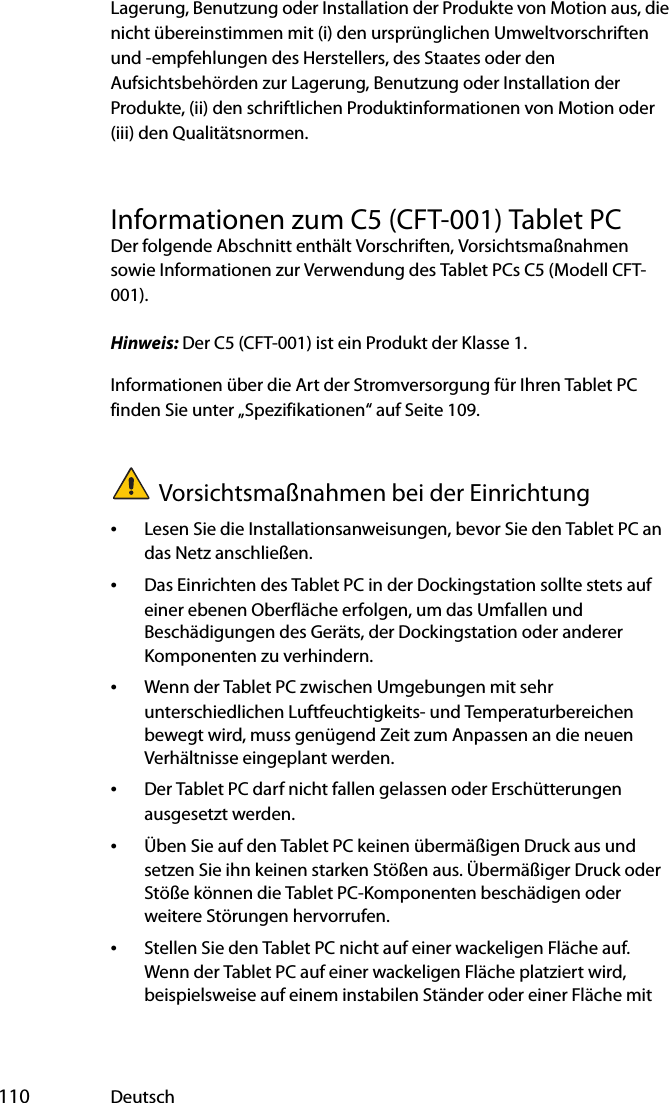
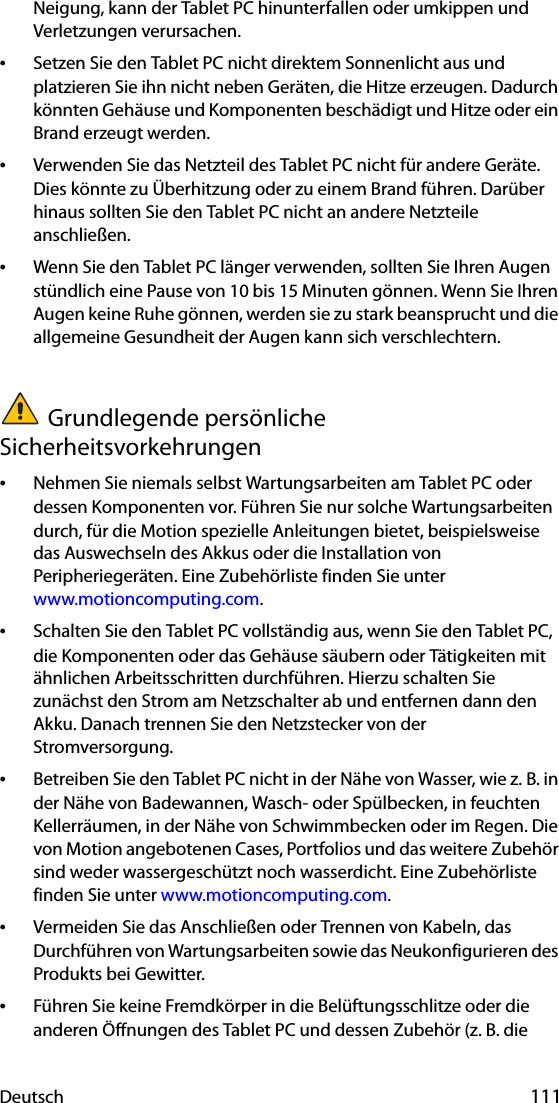
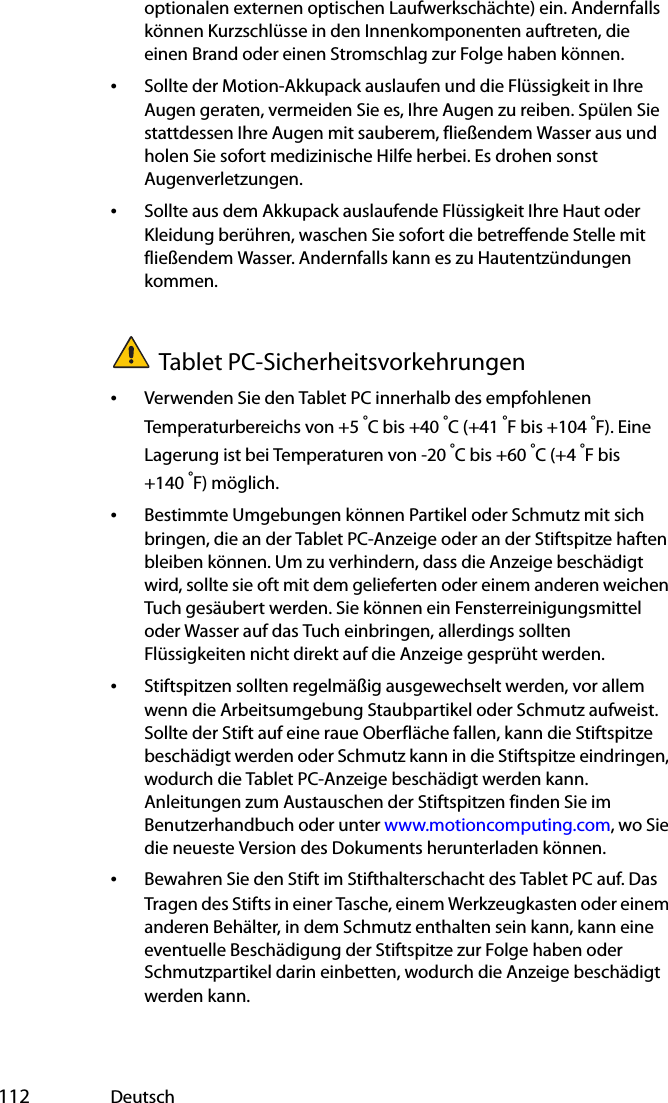
![Deutsch 113•Öffnen Sie dieses Produkt nicht und versuchen Sie nicht, Wartungsarbeiten daran durchzuführen. Das Öffnen des Produkts bzw. das Durchführen von Wartungsarbeiten kann einen Stromschlag zur Folge haben.Warnung zu gefährlichen oder mit hohem Risiko behafteten HandlungenDieses Computersystem wurde nicht zum Einsatz als medizinisches Gerät oder zur Benutzung bei gefährlichen oder mit hohem Risiko behafteten Handlungen konzipiert, wie beispielsweise dem Betrieb von Kernkraftanlagen, von Flugnavigations- oder Flugkommunikations-systemen, von Krankenhausabläufen oder medizinischen Vorgängen, von Flugsicherungsgeräten, der Behandlung, der Diagnose oder der Überwachung von Patienten oder jeglicher weitere Einsatz, in dem das Versagen des Computersystems zum Tode, zu Verletzungen oder zu ernsten Umweltschäden führen könnte.Hinweis zum klinischen Einsatz (nur für C5 [CFT-001])Der Tablet PC ist für das Erfassen von Patientendaten, deren Identifikation, das Verwalten von Datensätzen usw. bestimmt. Er ist jedoch nicht für die Diagnose, die Behandlung oder die Überwachung von Patienten gedacht, die unter medizinischer Aufsicht stehen. Der Tablet PC sollte weder physisch noch elektrisch direkten Kontakt zum Patienten haben, Energie auf den Patienten übertragen oder Energieübertragungen an oder vom Patienten feststellen.Tablet PC-Entsorgung•Entsorgen Sie das Gerät nicht mit dem Hausmüll.•Die Leuchtstoffröhren des Geräts enthalten Quecksilber. Befolgen Sie die lokalen Vorschriften zur Entsorgung des Geräts.•Wenn Sie keine Abgabestelle finden können, wenden Sie sich an Ihren Händler oder an Motion Computing.](https://usermanual.wiki/Xplore-Technologies-of-America/HWMSMC5725.Users-Manual-Safety-Info/User-Guide-1079955-Page-113.png)
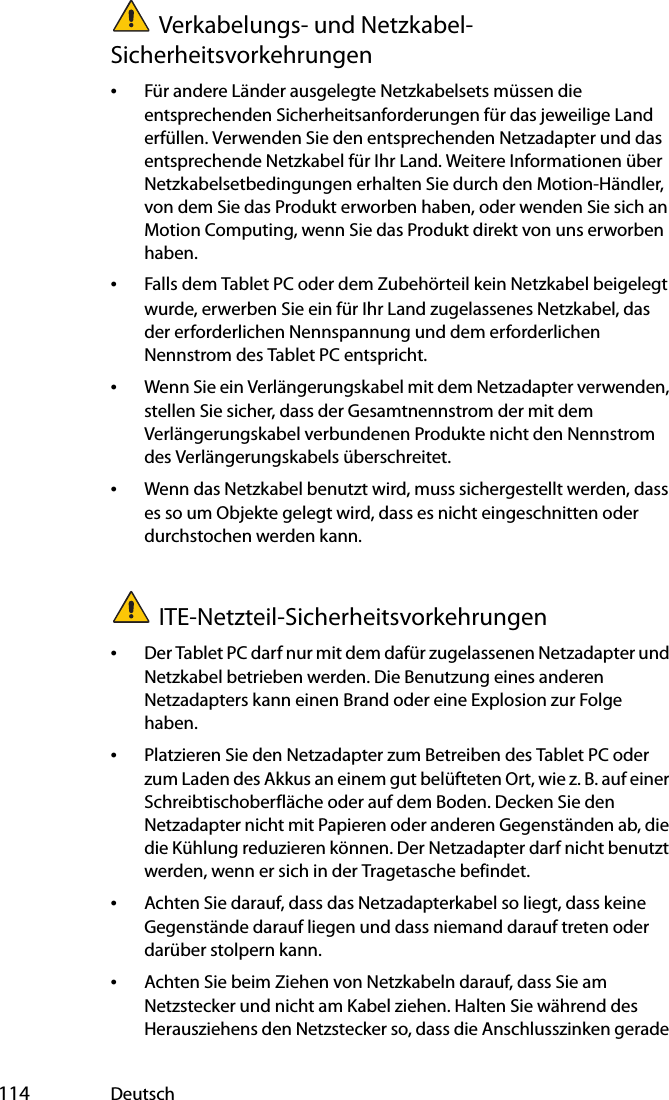
![Deutsch 115ausgerichtet sind, um Verbiegungen zu vermeiden. Vergewissern Sie sich vor dem Anschluss eines Kabels, dass beide Anschlüsse richtig ausgerichtet sind.Weitere Informationen zum Netzteil für den medizinischen Einsatz (nur für C5 [CFT-001]) finden Sie unter „Sicherheitsvorkehrungen zum Netzteil für den medizinischen Einsatz (nur für C5 [CFT-001])“ auf Seite 115.Sicherheitsvorkehrungen zum Netzteil für den medizinischen Einsatz (nur für C5 [CFT-001])Zusatzgeräte, die an medizinische elektrische Geräte angeschlossen werden, müssen den jeweiligen IEC- oder ISO-Standards entsprechen (z. B. IEC 60950-1 für Datenverarbeitungsgerät). Darüber hinaus müssen alle Konfigurationen den Anforderungen für medizinische elektrische Anlagen entsprechen (siehe IEC 60601-1 bzw. Paragraf 16 der 3Ed. von IEC 60601-1). Jeder Benutzer, der Zusatzgeräte an medizinische elektrische Geräte anschließt, konfiguriert eine medizinische Anlage und ist daher dafür verantwortlich, dass die Anlage den Anforderungen für medizinische elektrische Anlagen entspricht. Hierbei ist zu beachten, dass die örtlichen Bestimmungen Vorrang vor den oben genannten Anforderungen haben. Wenden Sie sich im Zweifelsfall an Ihren Vertreter vor Ort oder an den technischen Kundendienst.Geltende Standards/Richtlinien:•IEC/EN 60601-1+A1+A2: 1995: 6.8.2.c, 19.2.b, 19.2.c•IEC 60601-1: 2006: 7.9.2.5•MDD 93/42/EEC: Anhang 1 Paragraf 13.6.c•UL 60601-1, erste Ausgabe•CAN/CSA C22.2 Nr. 601-1, erste AusgabeAkkupack-Warnungen und SicherheitsvorkehrungenAkkupack-Modellnummer: MC5450BPEinstufung: 11,1 V Gleichstrom; 4000 mAh.•Der Tablet PC enthält einen internen Lithiumionen (Li-Ionen)-Akkupack. Ersetzen Sie den internen Akkupack nur mit einem](https://usermanual.wiki/Xplore-Technologies-of-America/HWMSMC5725.Users-Manual-Safety-Info/User-Guide-1079955-Page-115.png)
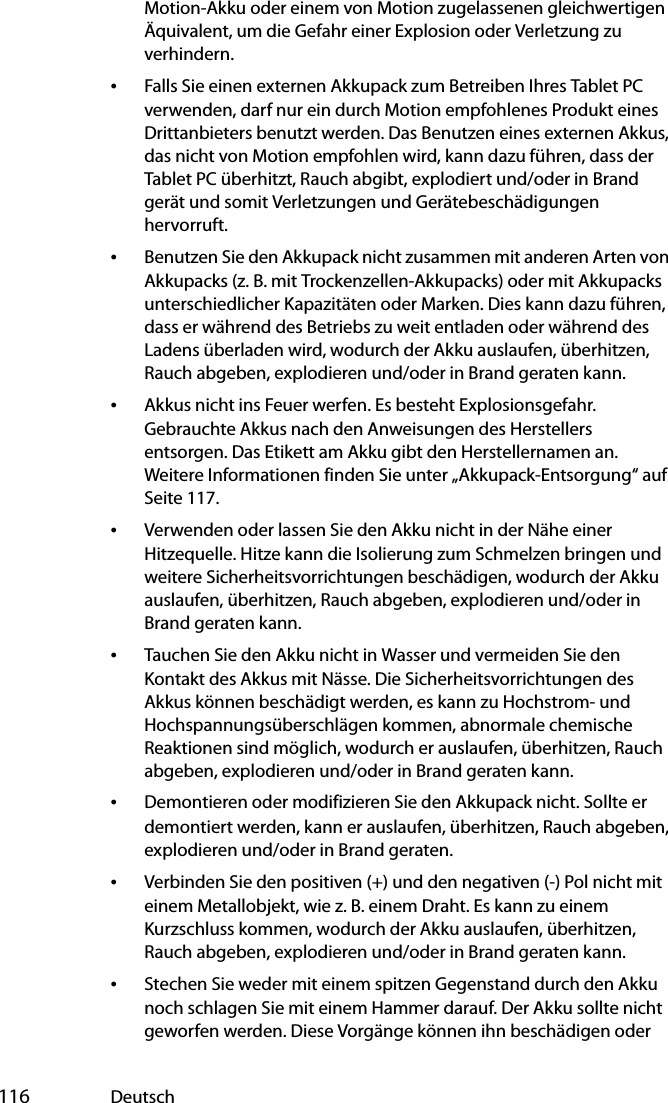
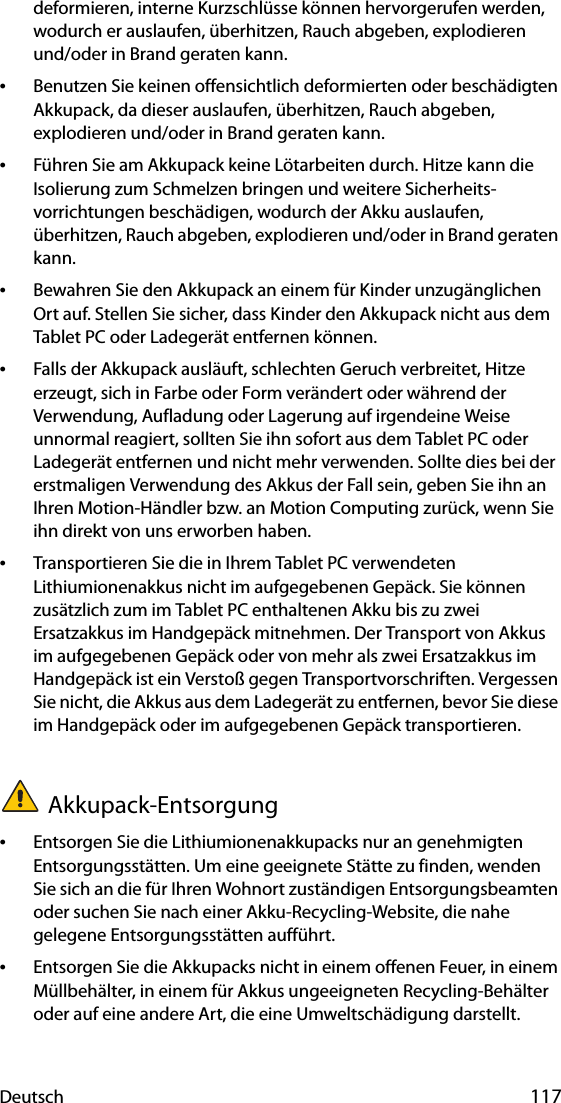
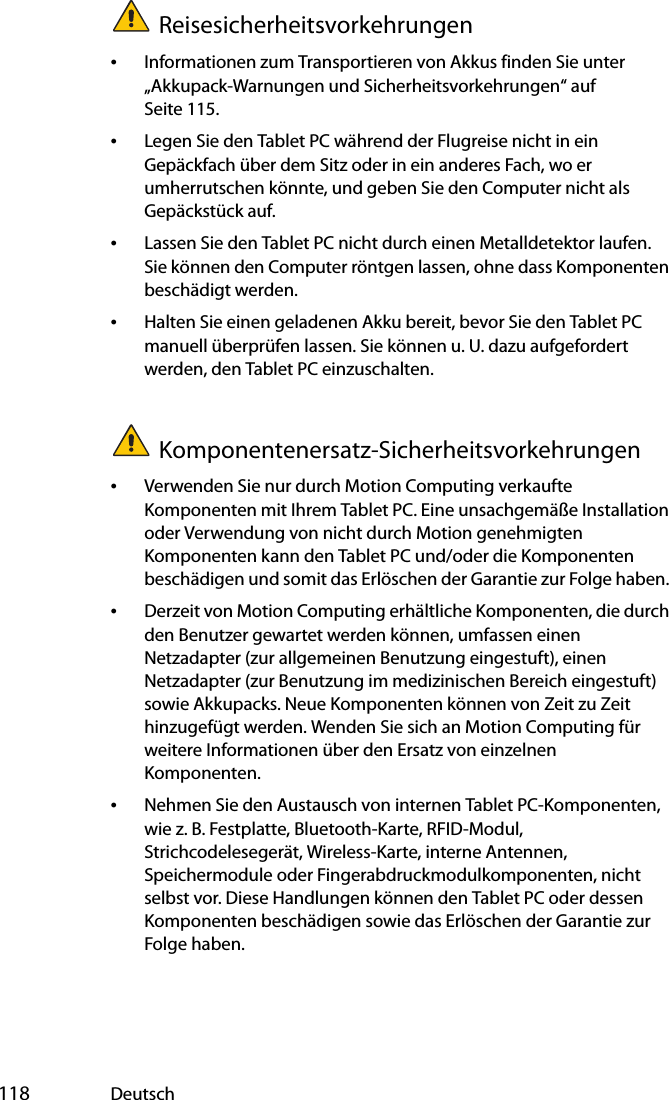
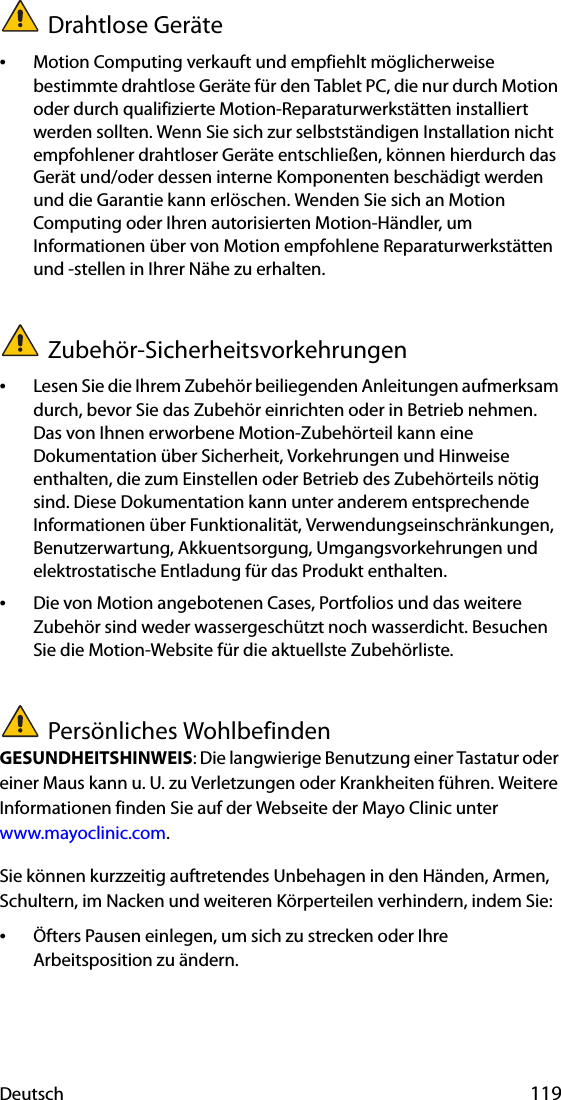
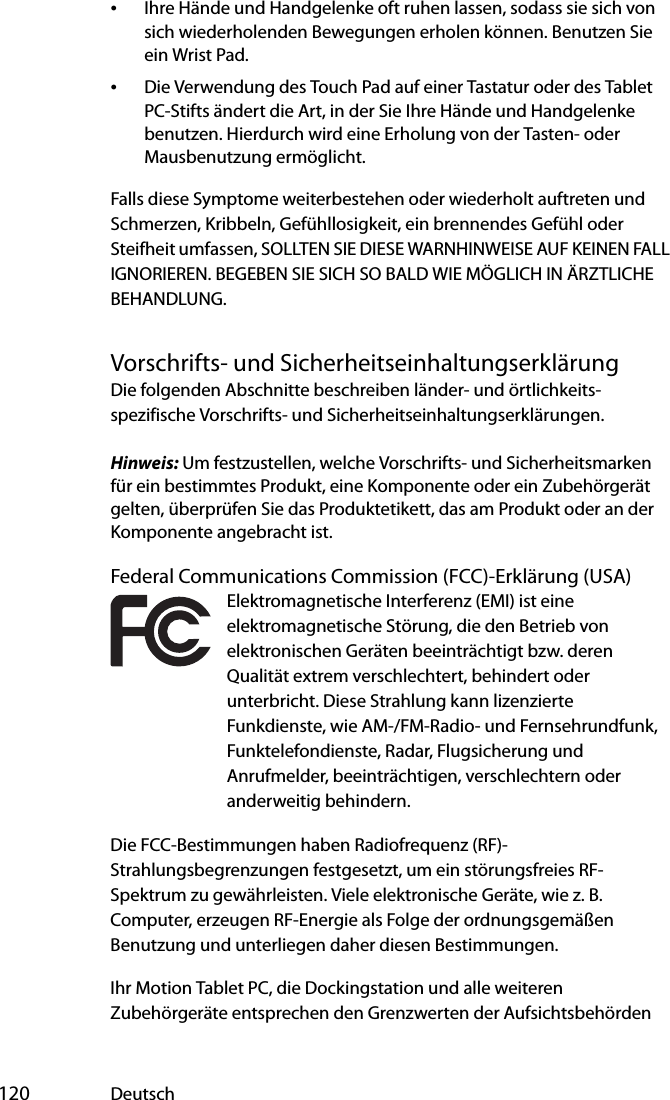
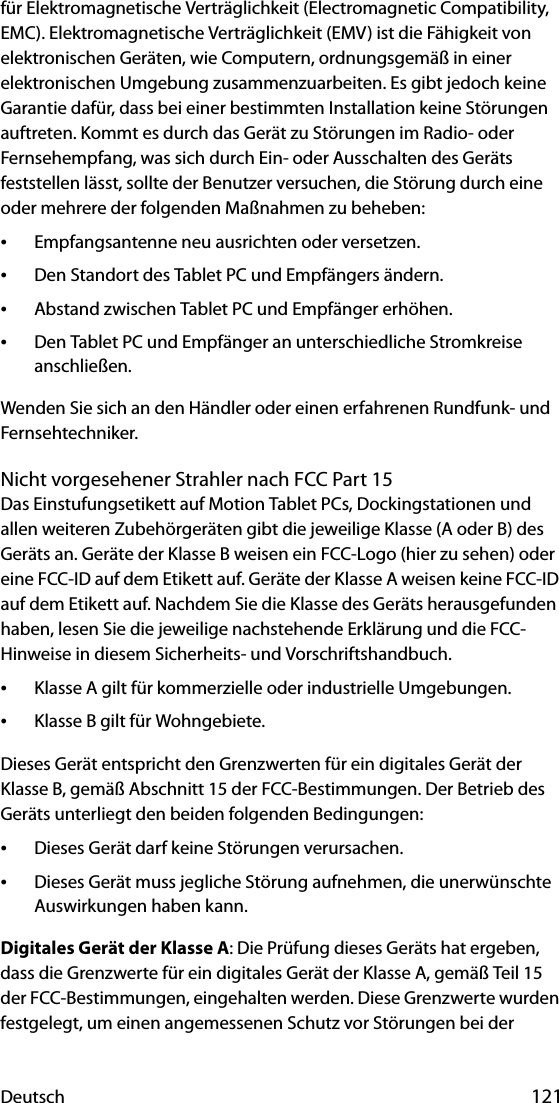
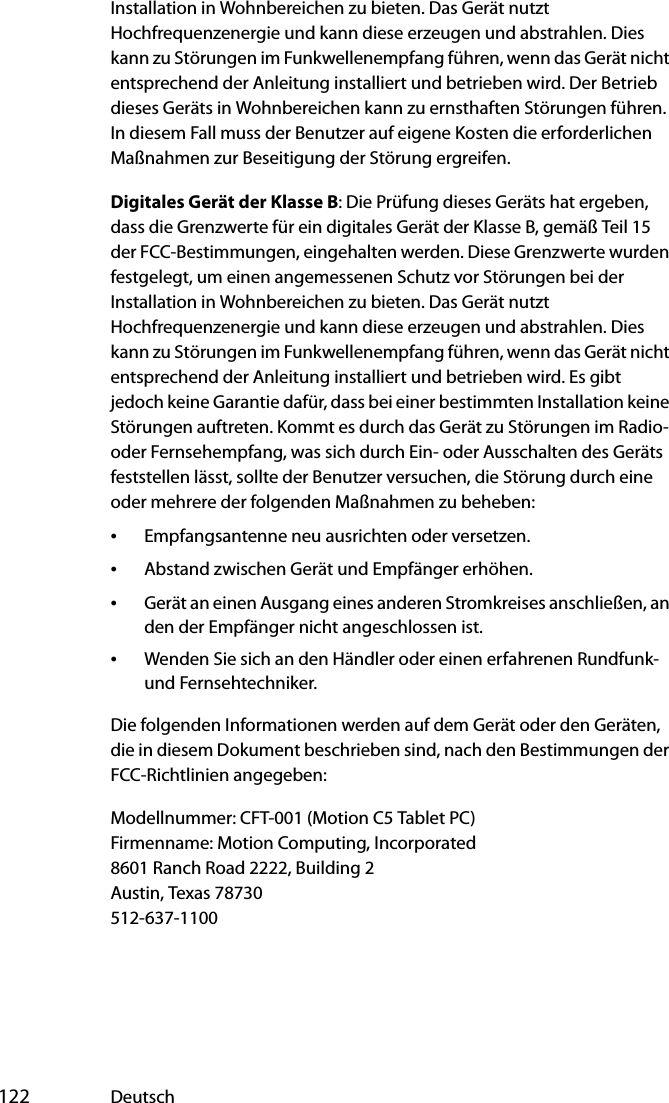
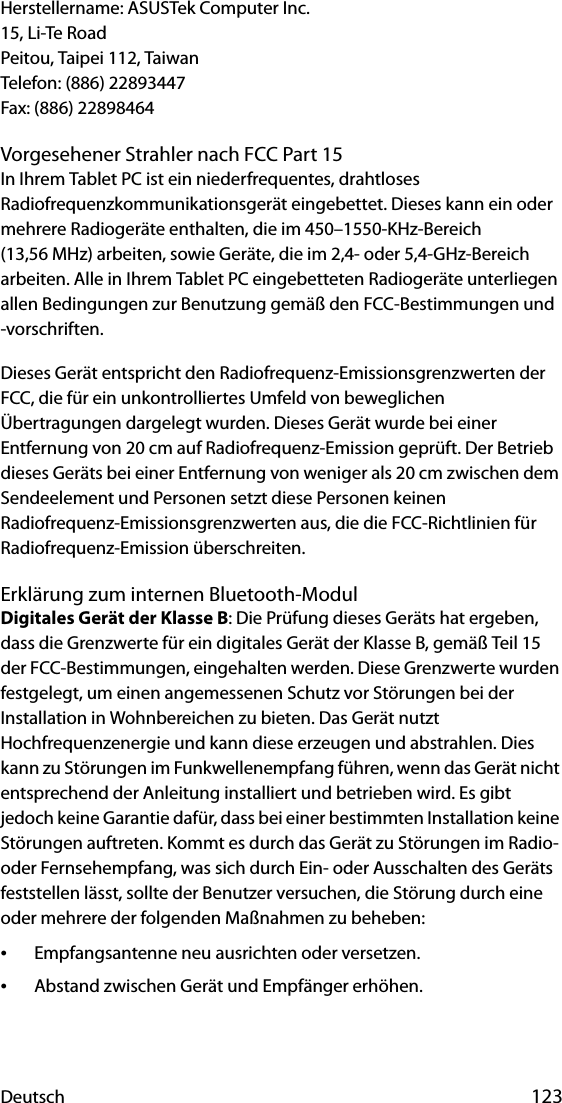
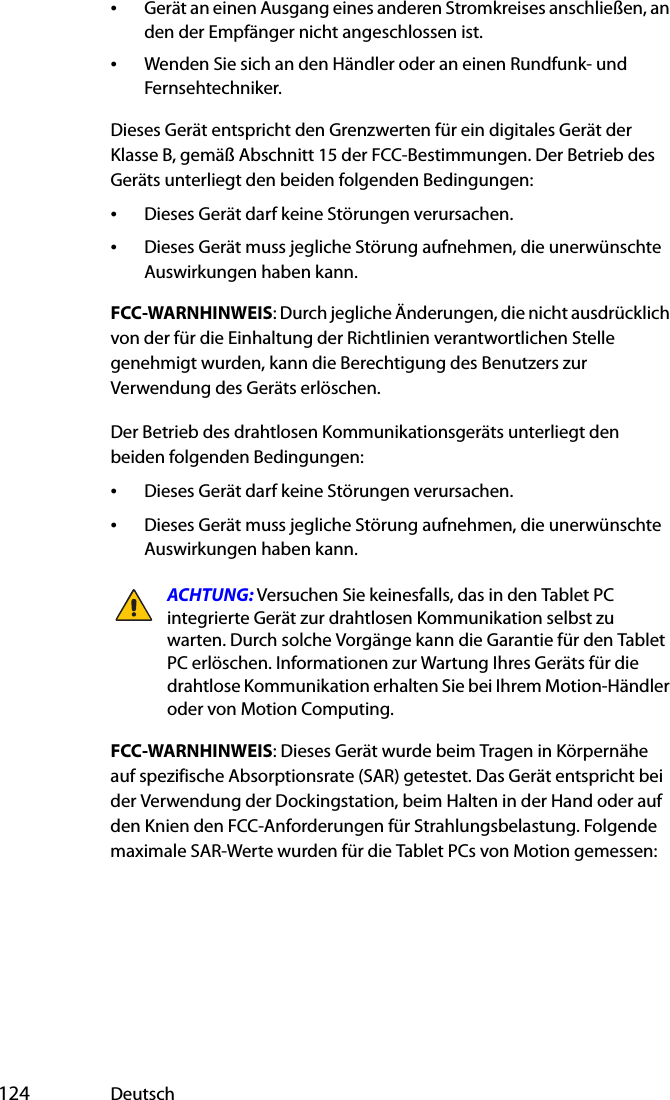
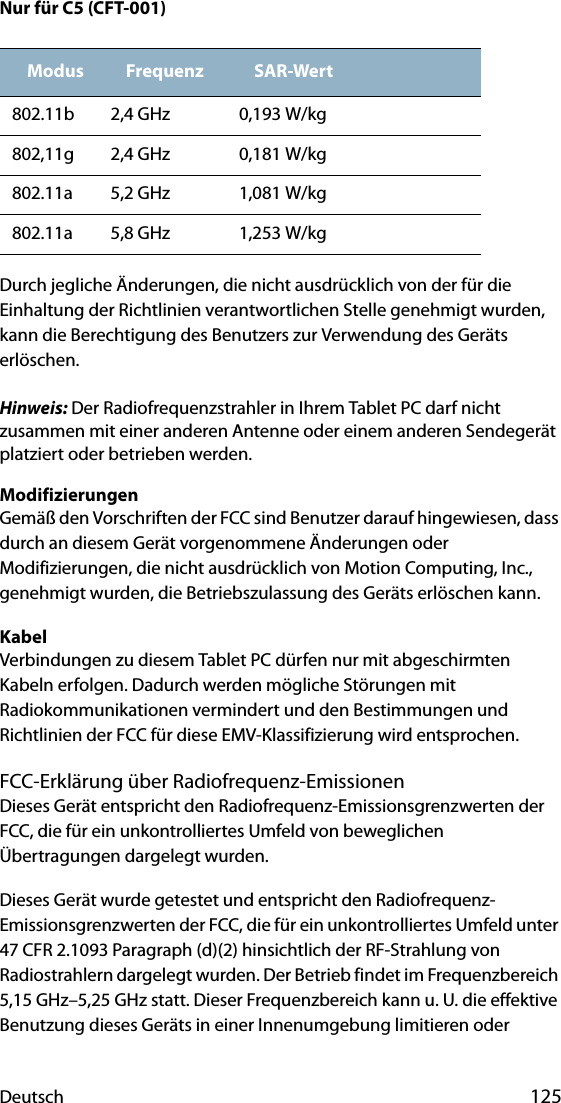
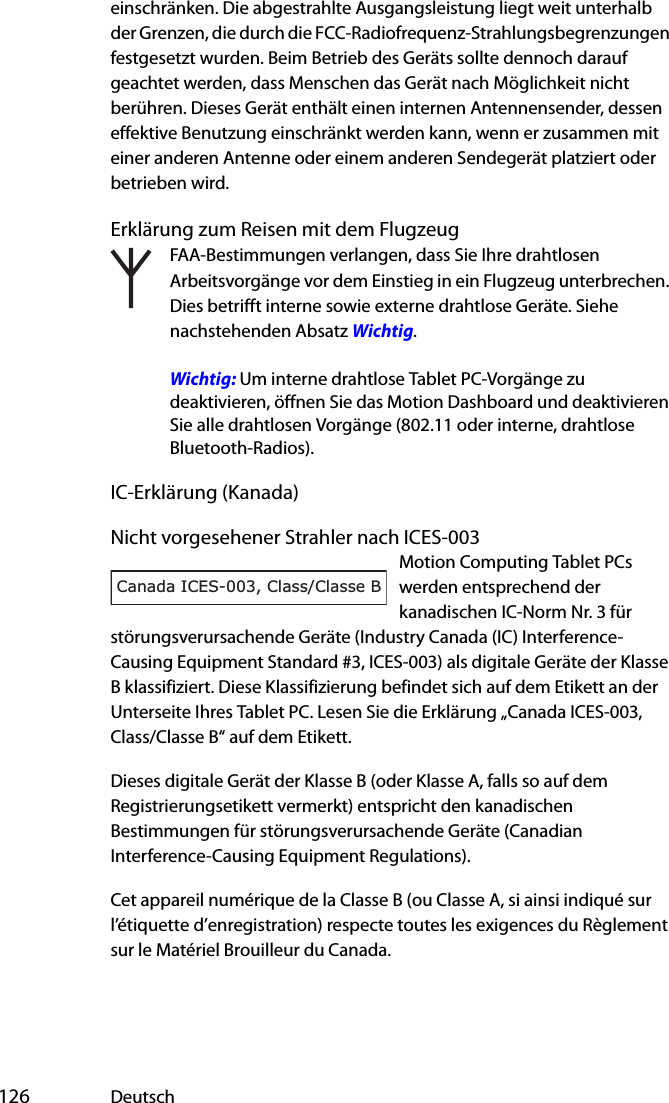
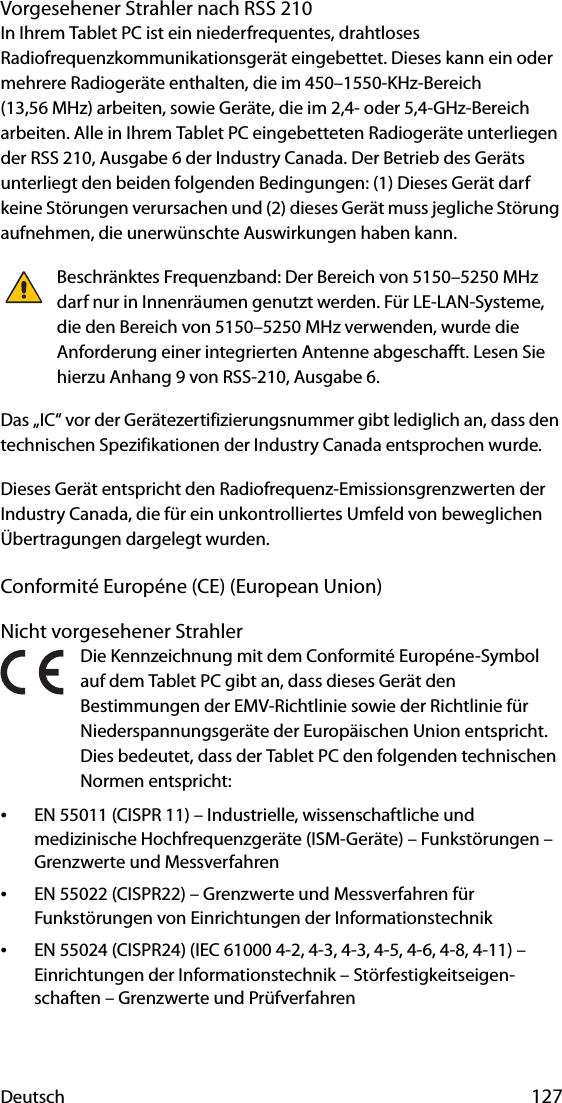
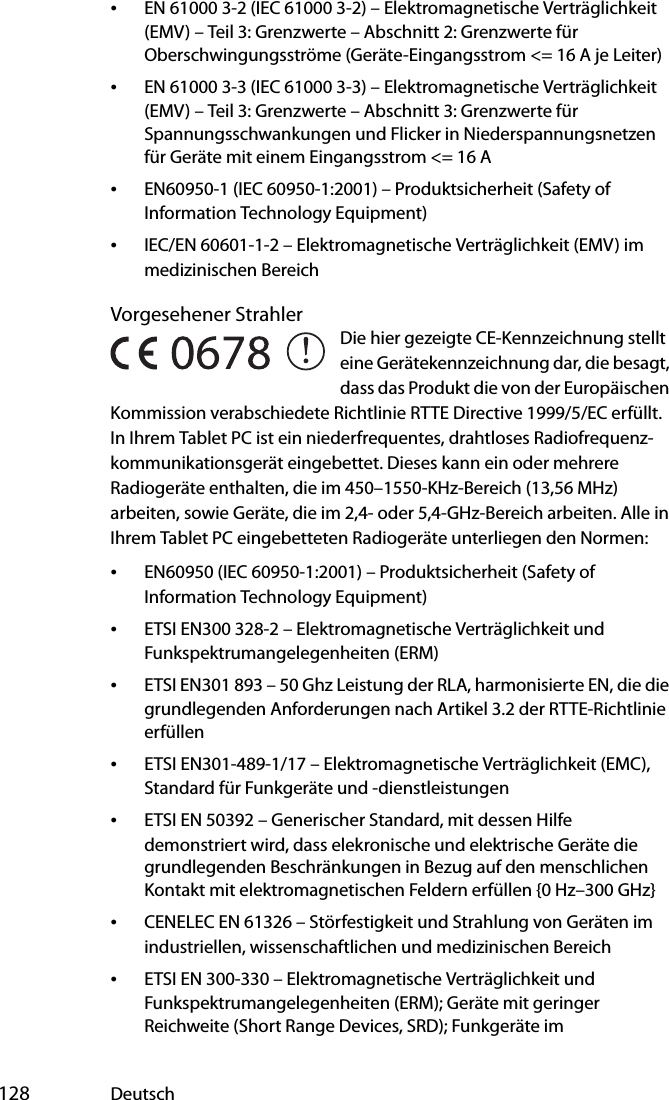
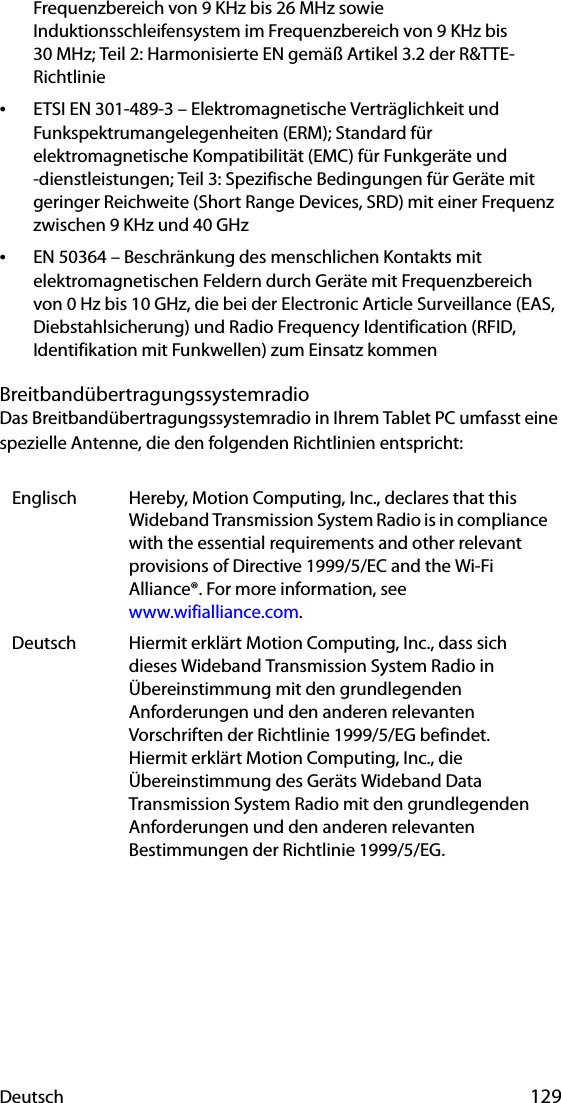
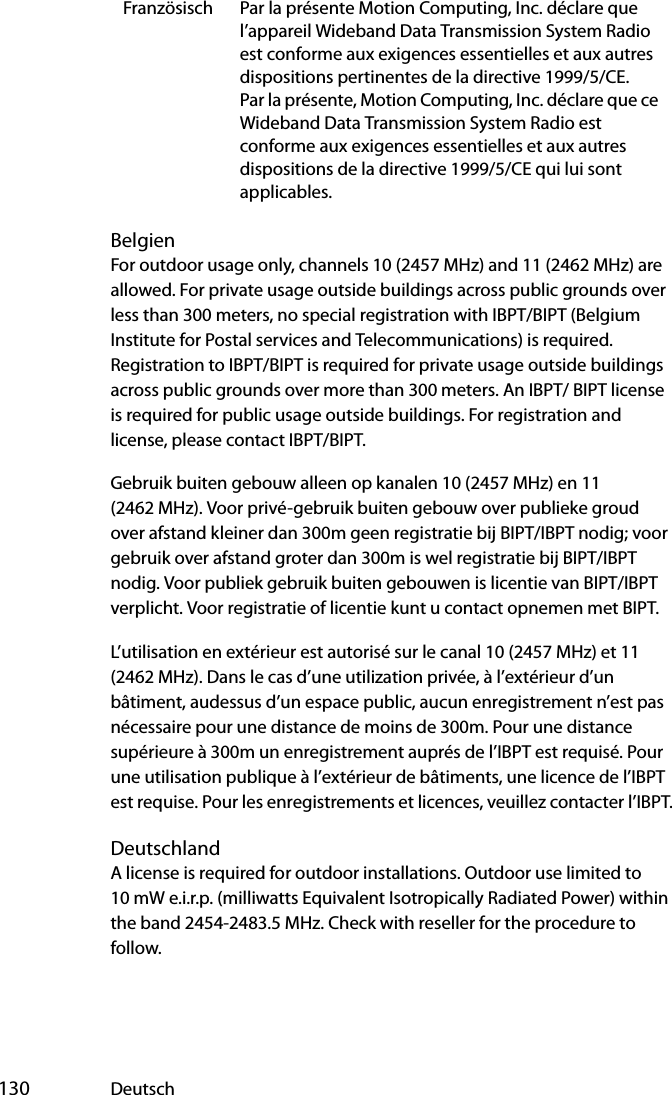
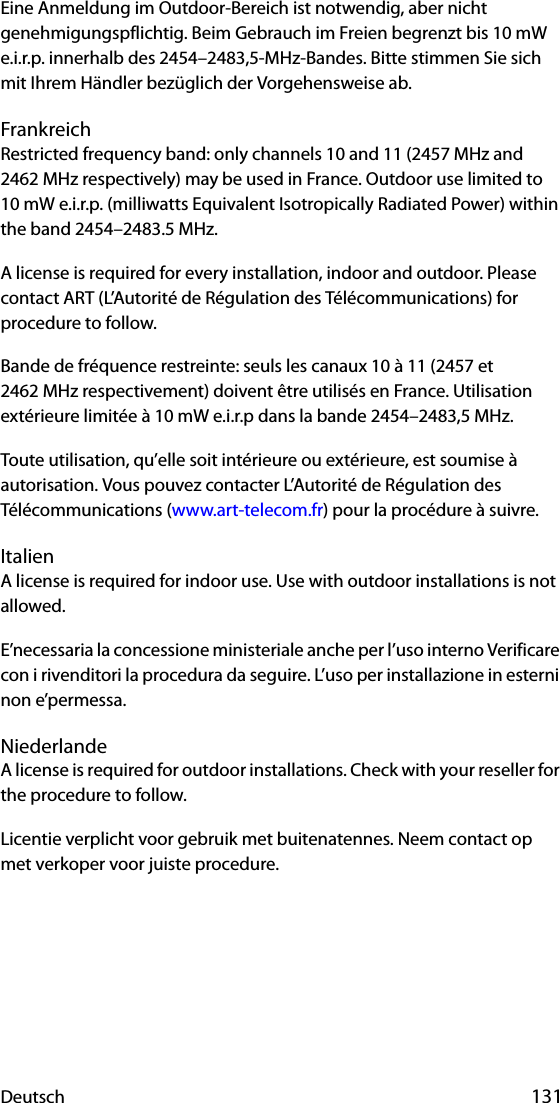
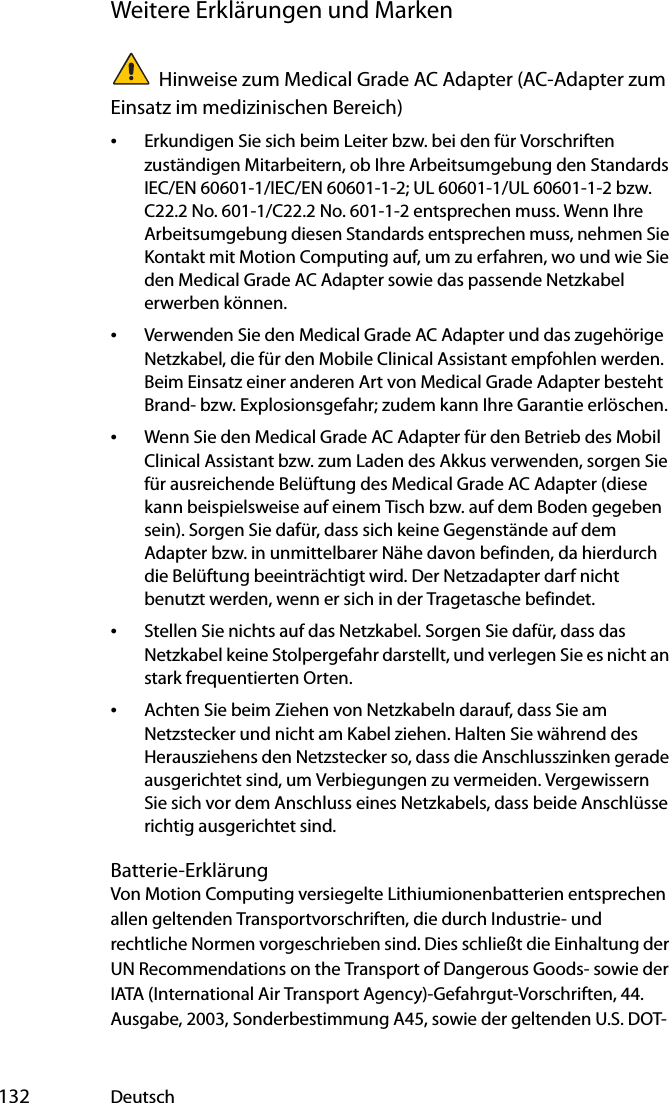
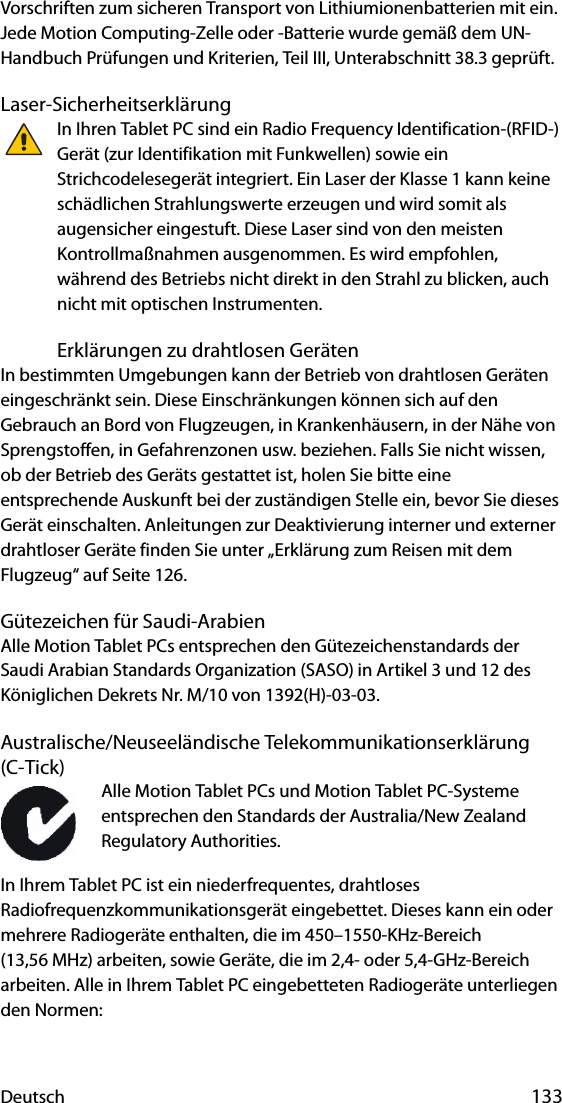
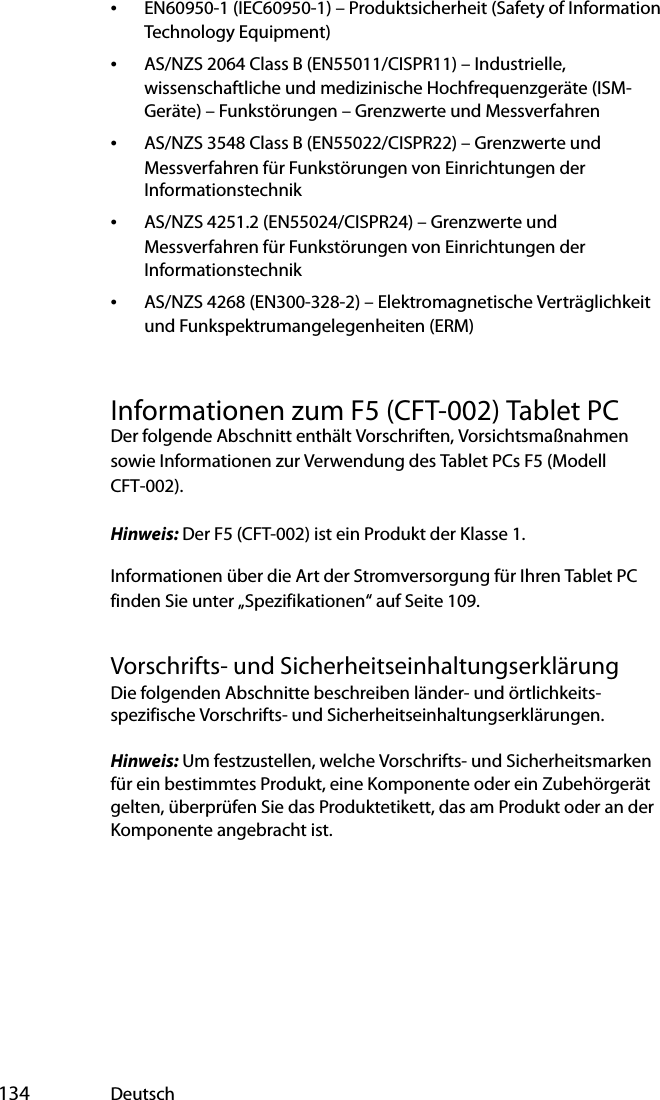
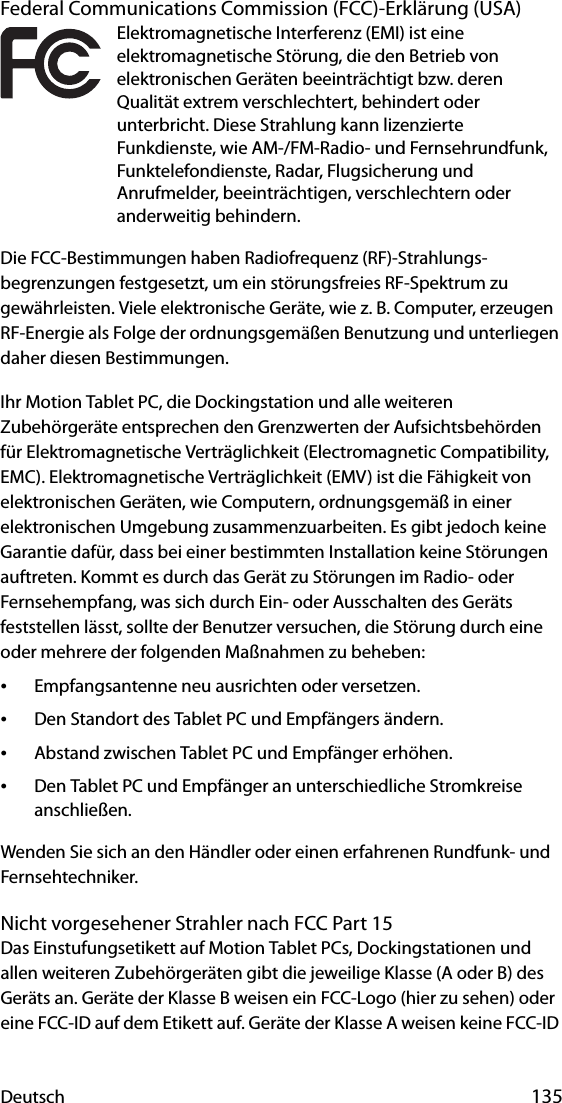
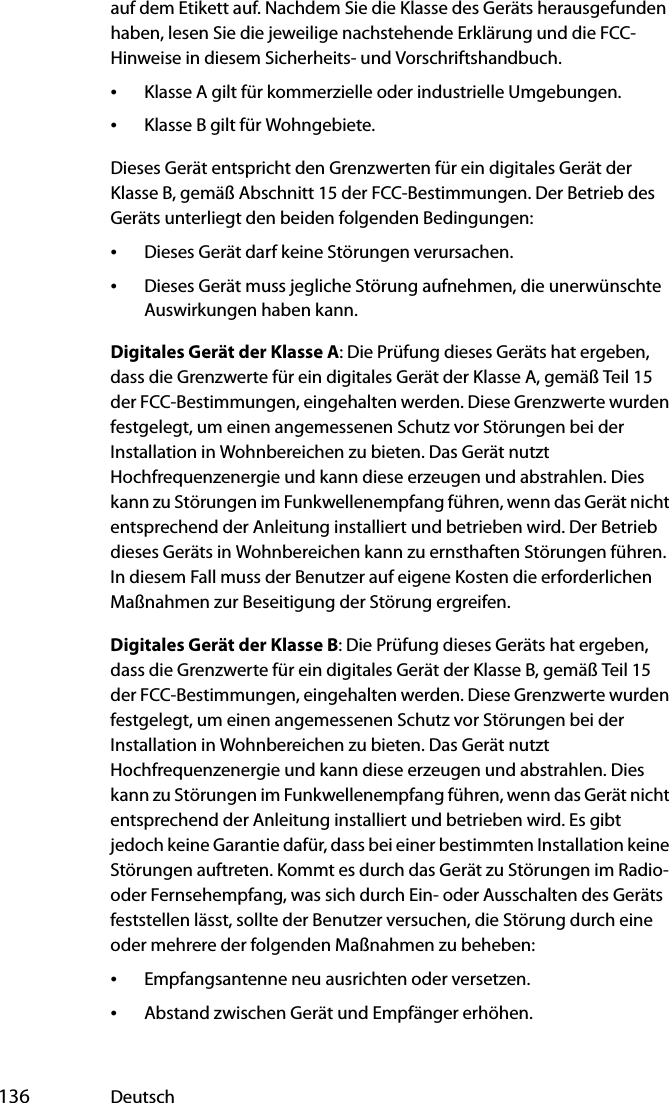
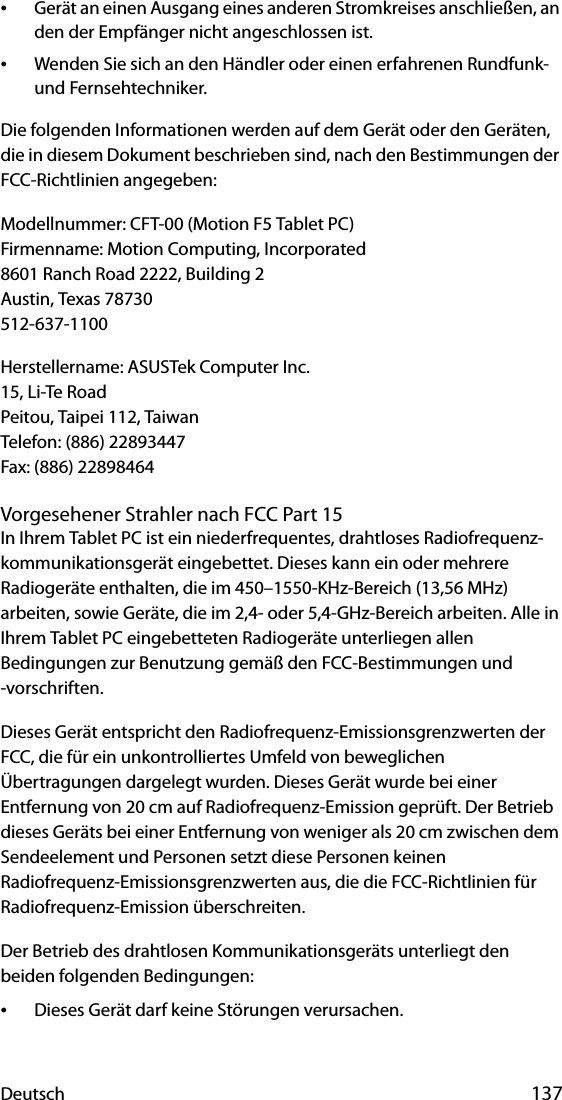
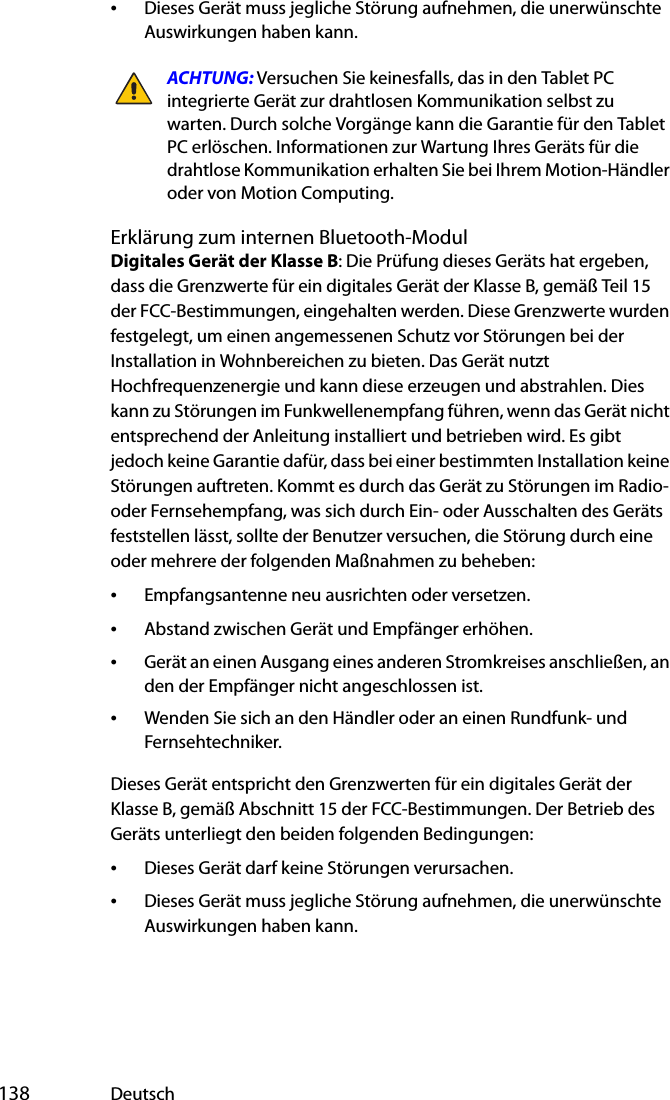
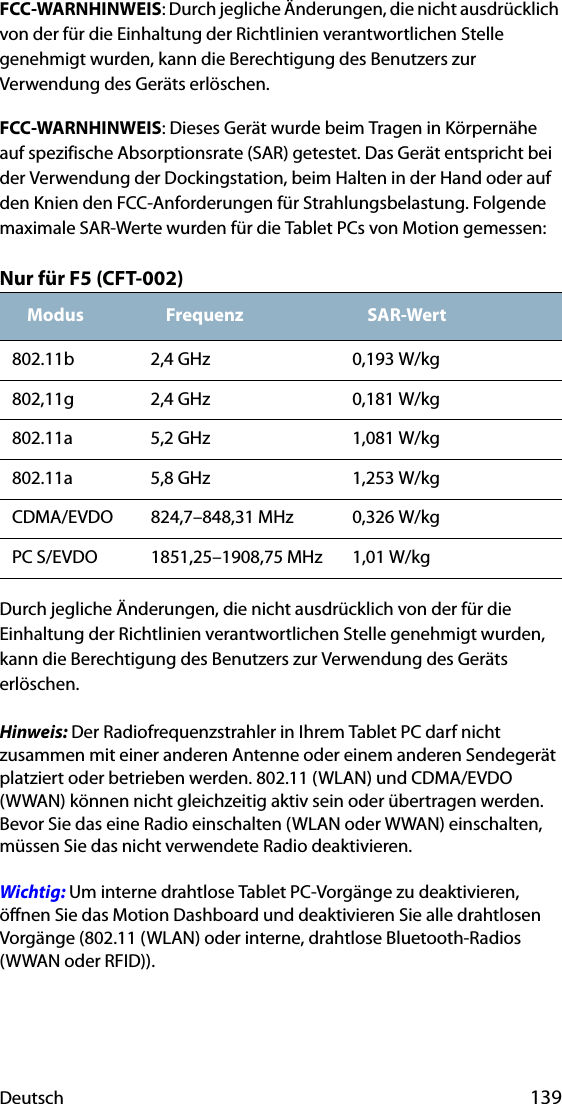
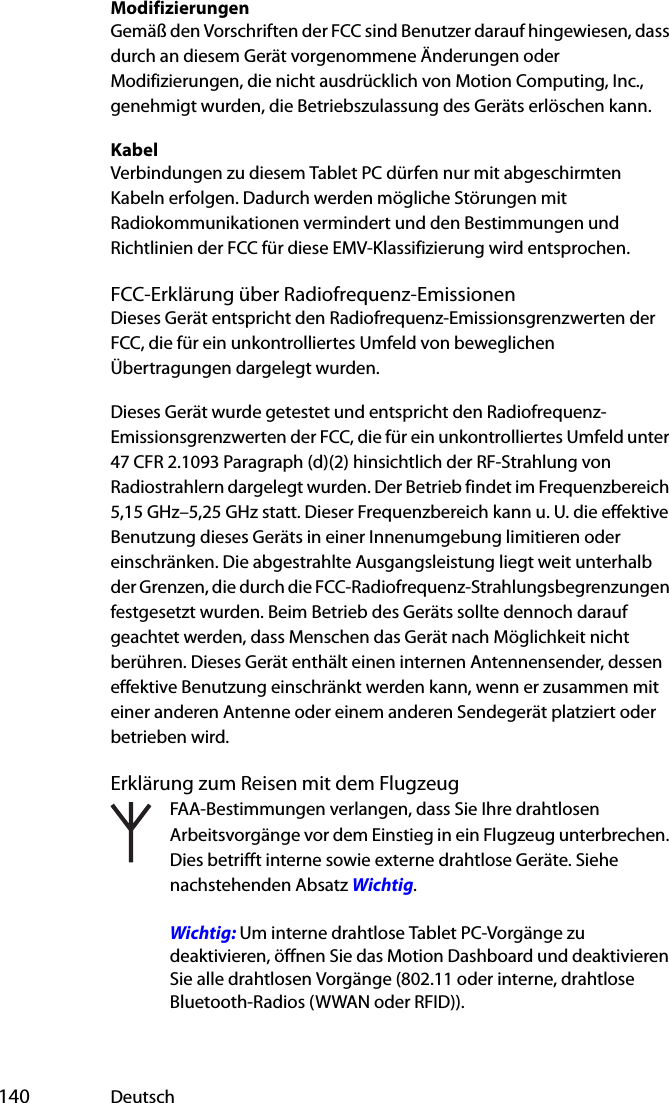
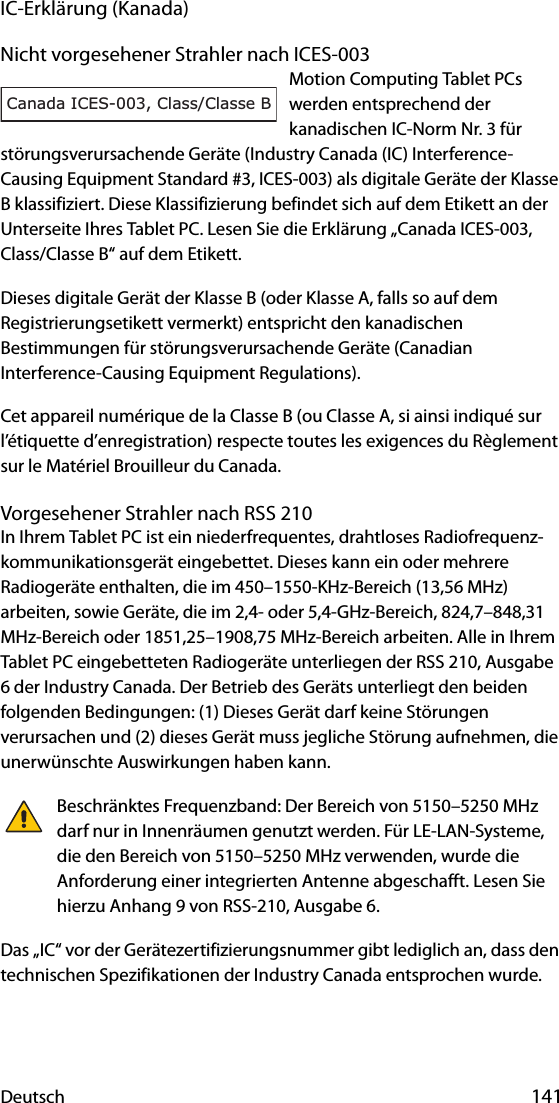
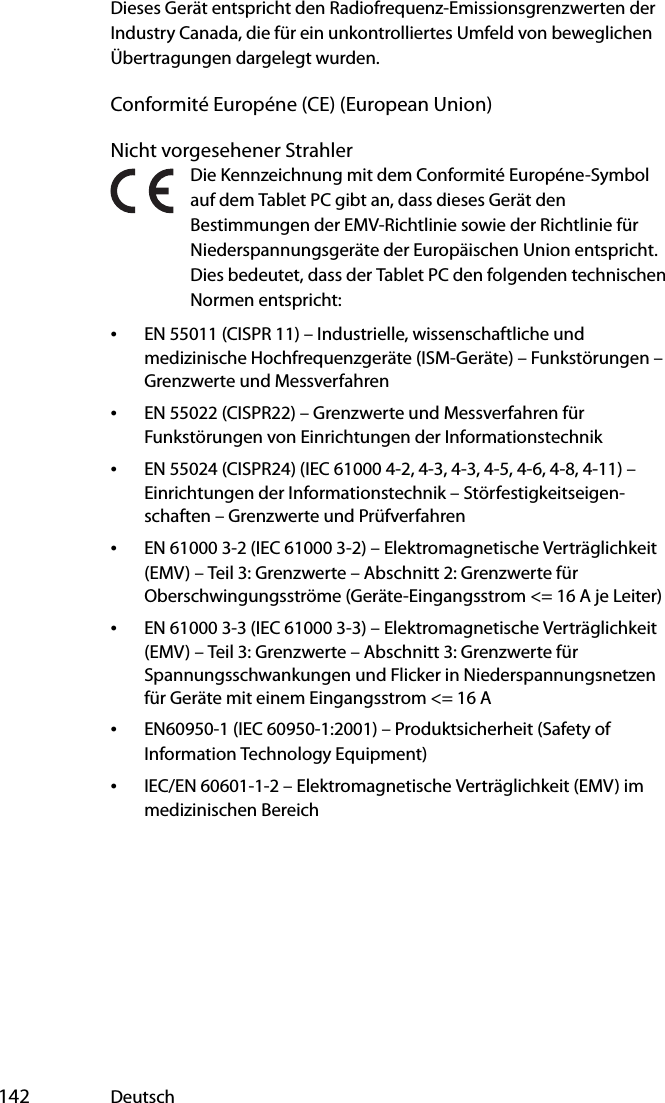
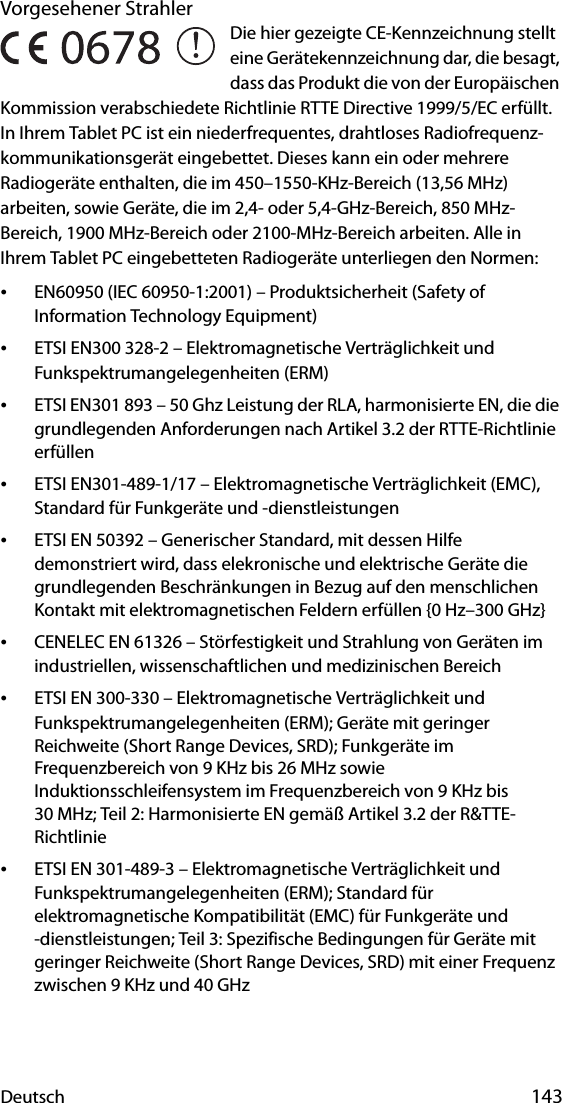
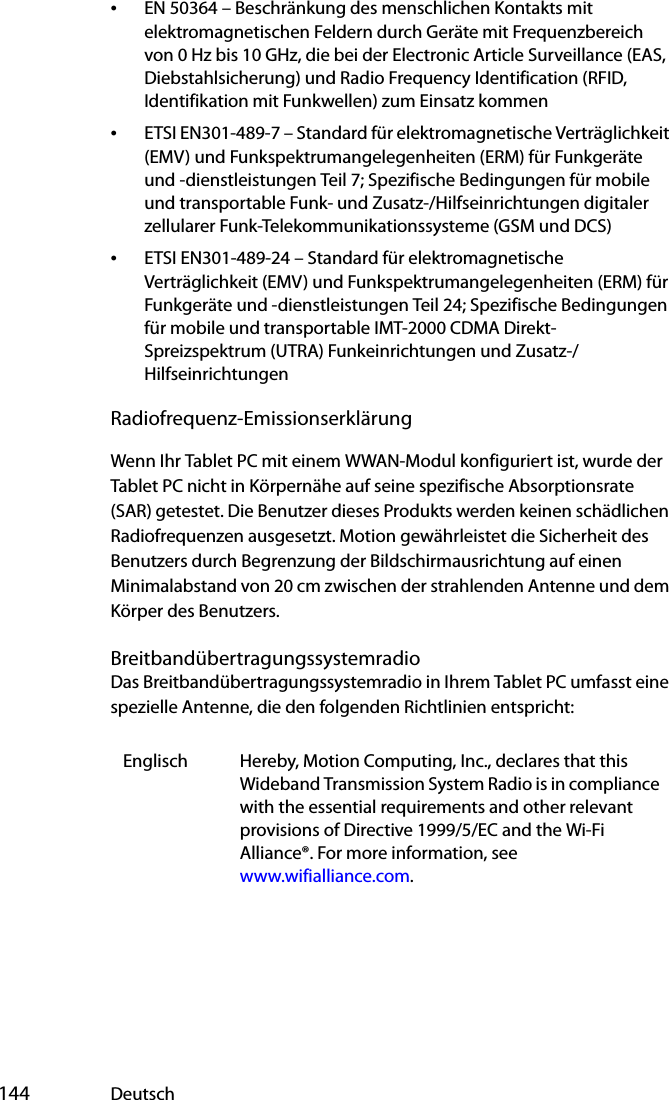
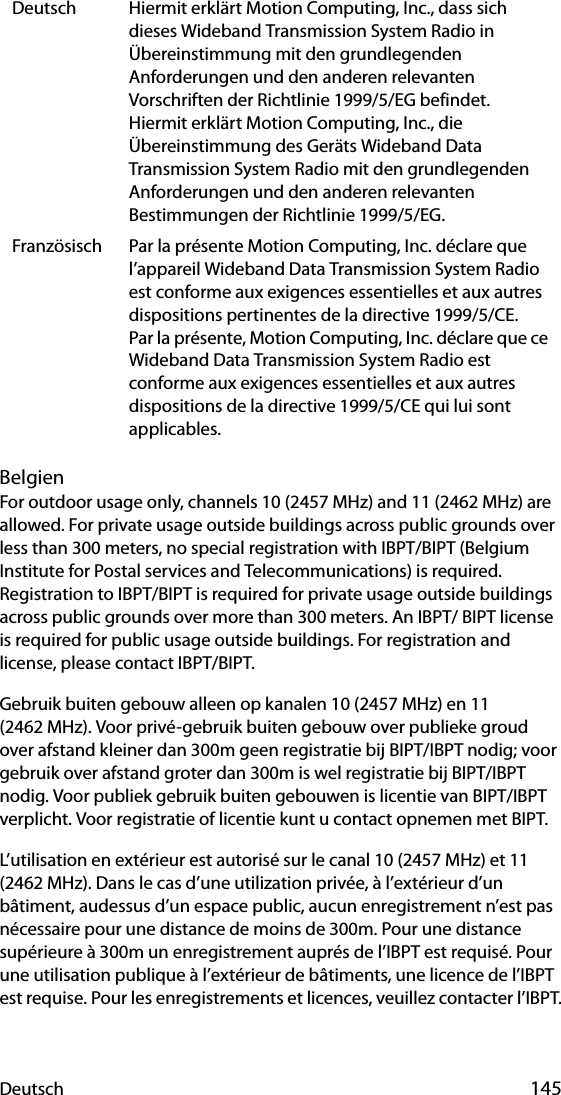
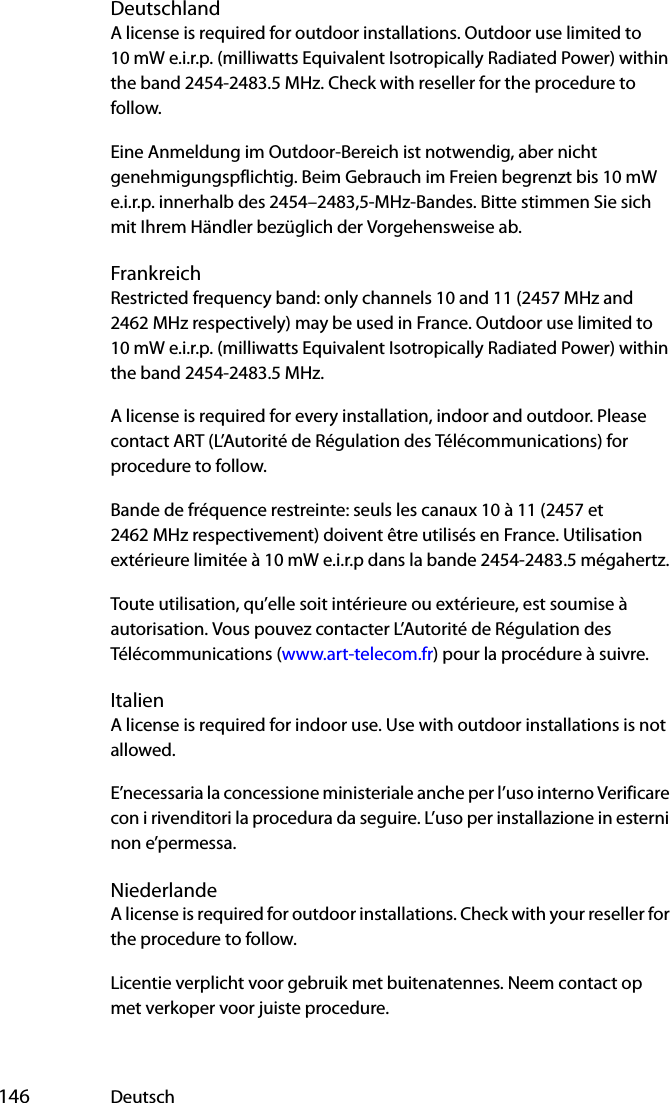
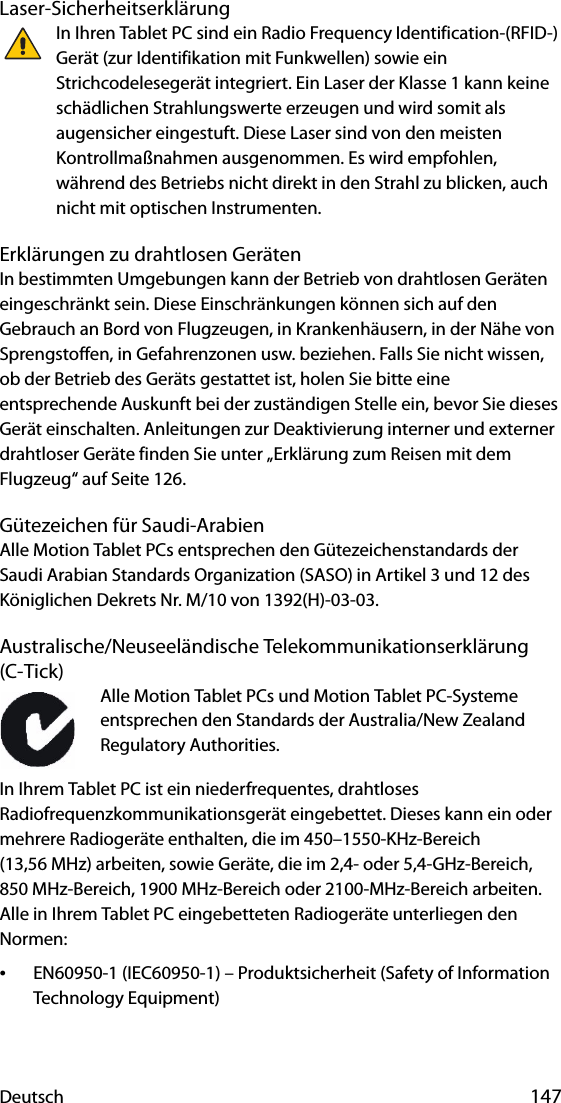
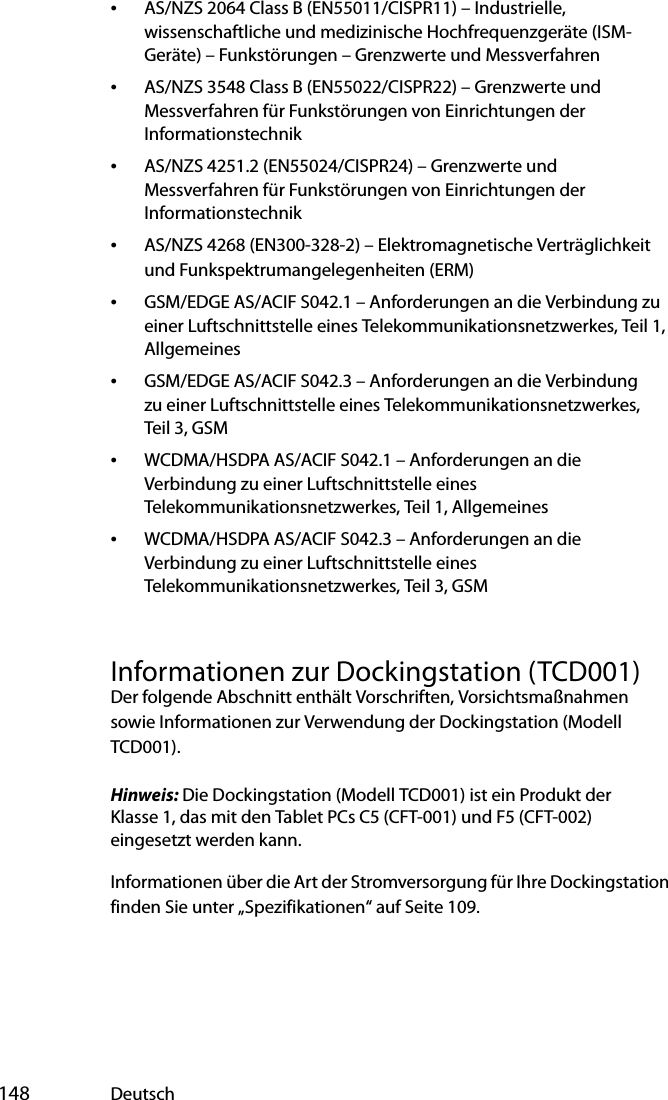
![Deutsch 149Vorsichtsmaßnahmen bei der Einrichtung•Lesen Sie die Installationsanweisungen, bevor Sie die Dockingstation an das Netz anschließen.•Die Dockingstation darf nicht fallen gelassen oder Erschütterungen ausgesetzt werden.•Üben Sie auf die Dockingstation keinen übermäßigen Druck aus und setzen Sie sie keinen starken Stößen aus. Übermäßiger Druck oder Stöße können die Dockingstation-Komponenten beschädigen oder weitere Störungen hervorrufen.•Stellen Sie die Dockingstation nicht auf einer wackeligen Fläche auf. Wenn die Dockingstation auf einer wackeligen Fläche platziert wird, beispielsweise auf einem instabilen Ständer oder einer Fläche mit Neigung, kann die Dockingstation hinunterfallen oder umkippen und Verletzungen verursachen.•Setzen Sie die Dockingstation nicht direktem Sonnenlicht aus und platzieren Sie sie nicht neben Geräten, die Hitze erzeugen. Dadurch könnten Gehäuse und Komponenten beschädigt und Hitze oder ein Brand erzeugt werden.•Verwenden Sie das Netzteil nicht für andere Geräte. Dies könnte zu Überhitzung oder zu einem Brand führen. Darüber hinaus sollten Sie die Dockingstation nicht an andere Netzteile anschließen.Hinweis zum klinischen Einsatz (nur für C5 [CFT-001])Die Dockingstation ist für das Aufladen des Tablet PC sowie zur Bereitstellung von Konnektivität für verschiedene Peripheriegeräte bestimmt. Sie ist jedoch nicht für die Diagnose, die Behandlung oder die Überwachung von Patienten gedacht, die unter medizinischer Aufsicht stehen. Die Dockingstation sollte weder physisch noch elektrisch direkten Kontakt zum Patienten haben, Energie auf den Patienten übertragen oder Energieübertragungen an oder vom Patienten feststellen.](https://usermanual.wiki/Xplore-Technologies-of-America/HWMSMC5725.Users-Manual-Safety-Info/User-Guide-1079955-Page-149.png)
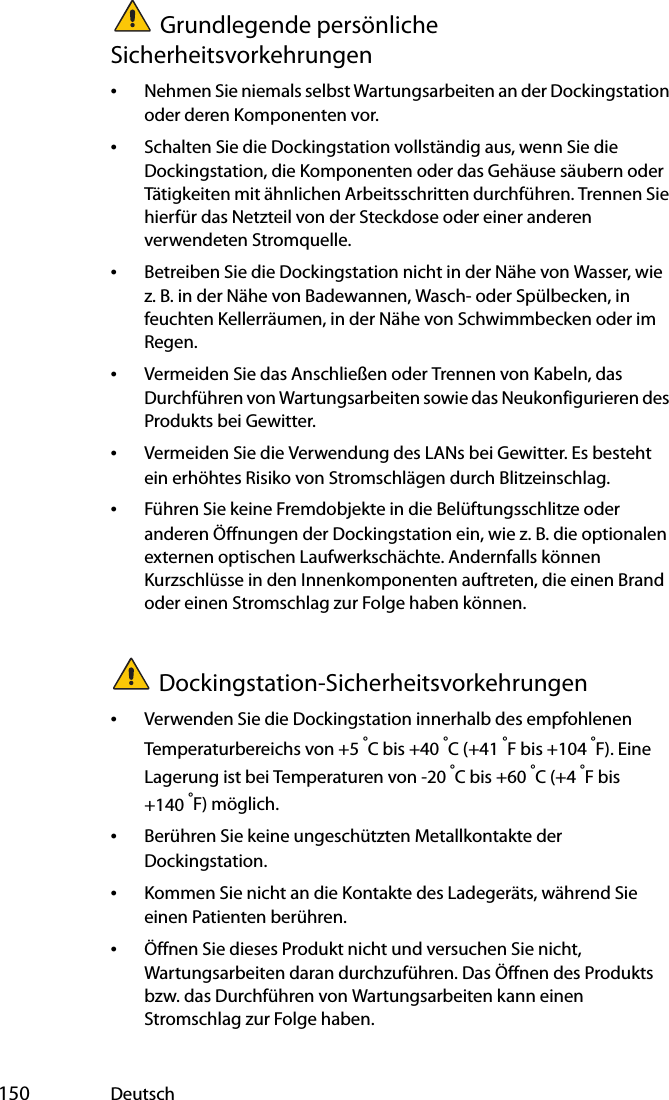
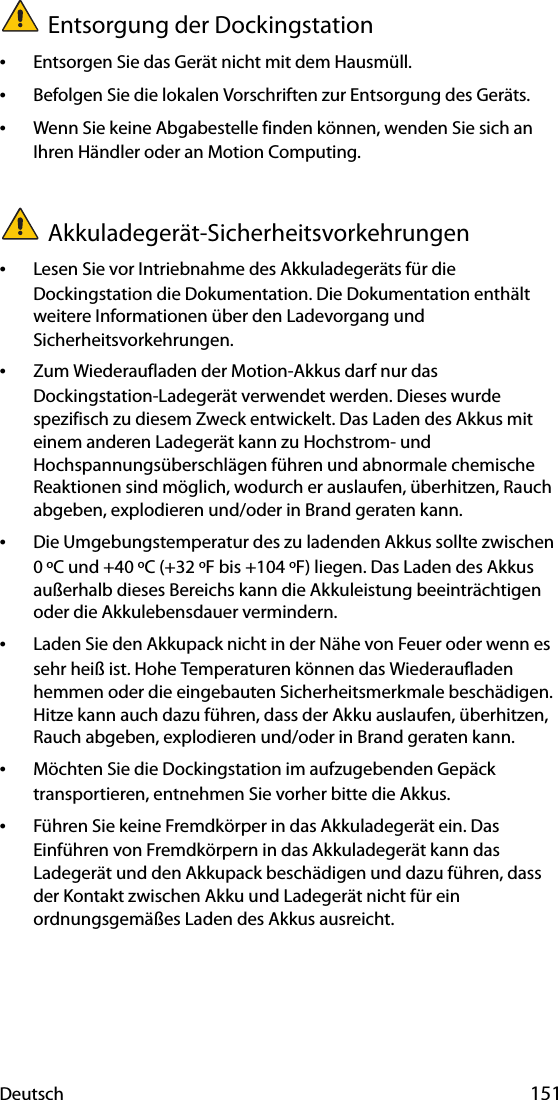
![152 DeutschITE-Netzteil-Sicherheitsvorkehrungen•Die Dockingstation darf nur mit dem dafür zugelassenen Netzadapter und Netzkabel betrieben werden. Die Benutzung eines anderen Netzadapters kann einen Brand oder eine Explosion zur Folge haben.•Platzieren Sie den Netzadapter zum Betreiben der Dockingstation oder zum Laden des Akkus an einem gut belüfteten Ort, wie z. B. auf einer Schreibtischoberfläche oder auf dem Boden. Decken Sie den Netzadapter nicht mit Papieren oder anderen Gegenständen ab, die die Kühlung reduzieren können. Der Netzadapter darf nicht benutzt werden, wenn er sich in der Tragetasche befindet.•Achten Sie darauf, dass das Netzadapterkabel so liegt, dass keine Gegenstände darauf liegen und dass niemand darauf treten oder darüber stolpern kann.•Achten Sie beim Ziehen von Netzkabeln darauf, dass Sie am Netzstecker und nicht am Kabel ziehen. Halten Sie während des Herausziehens den Netzstecker so, dass die Anschlusszinken gerade ausgerichtet sind, um Verbiegungen zu vermeiden. Vergewissern Sie sich vor dem Anschluss eines Kabels, dass beide Anschlüsse richtig ausgerichtet sind.Weitere Informationen zum Netzteil für den medizinischen Einsatz finden Sie unter „Sicherheitsvorkehrungen zum Netzteil für den medizinischen Einsatz (nur für C5 [CFT-001])“.Sicherheitsvorkehrungen zum Netzteil für den medizinischen Einsatz (nur für C5 [CFT-001])Zusatzgeräte, die an medizinische elektrische Geräte angeschlossen werden, müssen den jeweiligen IEC- oder ISO-Standards entsprechen (z. B. IEC 60950 für Datenverarbeitungsgerät). Darüber hinaus müssen alle Konfigurationen den Anforderungen für medizinische elektrische Anlagen entsprechen (siehe IEC 60601-1 bzw. Paragraf 16 der 3Ed. von IEC 60601-1). Jeder Benutzer, der Zusatzgeräte an medizinische elektrische Geräte anschließt, konfiguriert eine medizinische Anlage und ist daher dafür verantwortlich, dass die Anlage den Anforderungen für medizinische elektrische Anlagen entspricht. Hierbei ist zu beachten, dass die örtlichen Bestimmungen Vorrang vor den oben genannten Anforderungen haben. Wenden Sie sich im Zweifelsfall an Ihren Vertreter vor Ort oder an den technischen Kundendienst.](https://usermanual.wiki/Xplore-Technologies-of-America/HWMSMC5725.Users-Manual-Safety-Info/User-Guide-1079955-Page-152.png)
